
The CURRENT of HAWAI‘I Theme: Food Volume 8 Issue 1 Features: Food Futures
ranchers shaping the future of island food, prisons
turn inmates
farmers,
of the dinners
defined Hawai‘i. Explore: Ritual Behavior Keepers of the flame
where to find them,
ritual acts that draw drinkers closer to the heavens. Special Section: 14 Local Flavors Perspectives on Hawaiʻi’s culinary zeitgeist, including where it’s going and what more it needs. 0 01 > 09281 $14.95 US $14.95 CAN 25489 8
Cattle
that
into
and reimaginings
that
and
and




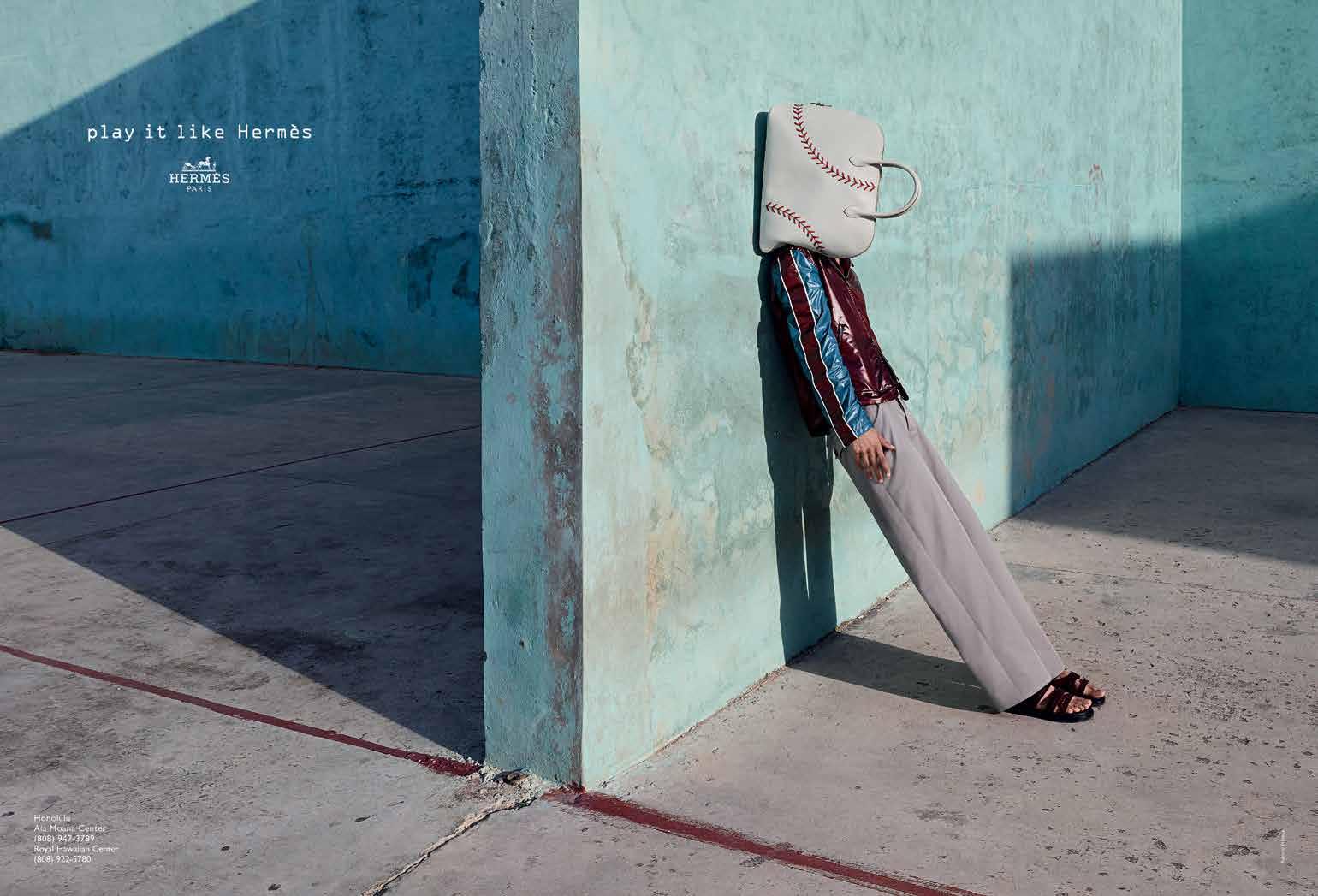



Editor’s Letter
Contributors
PHILES
28 | Culture: Sheldon Simeon
36 | Community: Roots Cafe
44 | Arts: Yuki Uzuhashi
A HUI HOU
192 | Glow with the Flow

FEATURES
50 | Beeves of Grass
Travis Hancock explores how fallow lands left behind by Hawai‘i’s defunct sugar plantations opened the door for cattle ranchers whose old traditions and new ideas could shape the future of island food.
70 | Redemptive Roots
Martha Cheng takes a look at how two penitentiaries on O‘ahu are preparing inmates for life beyond bars through farming programs that not only feed the prisons, but also the community at large.
84 | Defining Dinners
Matthew Dekneef and Rae Sojot reimagine three historic dinners that highlight Hawai‘i’s changing place in the world.
TABLE OF CONTENTS | FEATURES | 26 FOOD
FLUX


SPECIAL SECTION:
14
FOODS THAT TELL US WHERE HAWAI‘I CUISINE IS GOING TABLE OF CONTENTS

� In 2018, the nature of food—its origins, its production, its presentation—is at the center of our conversations about what we eat. For this feature, we’ve compiled a diverse cross-section of voices, from chefs and farmers to writers and educators, to gain a range of perspectives on where Hawai‘i’s culinary zeitgeist is today, where it’s going, and what more it needs.
94
| SECTIONS |



TABLE OF CONTENTS | SECTIONS | 160 EXPLORE 162 | Divinity’s Cup ʻAwa and wine 174 | This Tastes Like Home Crack seed, bento, and manapua 140 LIVING WELL 142 | Interiors The Dining Chair 154 | Health Marathon swimmer Kim Chambers

TABLE OF CONTENTS
FLUX TV |
Stay current on arts and culture with us at:
fluxhawaii.com
facebook /fluxhawaii
twitter @fluxhawaii
instagram @fluxhawaii

FLUX TV
Where’s the Beef?
Spend a day with Kunoa Cattle Company, which utilizes a ranching model called holistic management in order to help Hawai‘i achieve food independence and keep its beef in the islands.
Drinking in the Divine
In Hawai‘i, Christian theology and Hawaiian mythology find twin relevance in practices where partakers drink in the divine—namely the practice of serving ‘awa and the taking of the Eucharist— as means to draw closer to one’s God or gods. In this video feature, take a look at the two spiritual rituals.
On the Wings of Bees
Records of entomophagy, the formal term for insect consumption, stretch as far back as the Edo period. In this video profile, beekeeper Yuki Uzuhashi shows diners how to enjoy the proteinrich delicacy of bee larvae.
|

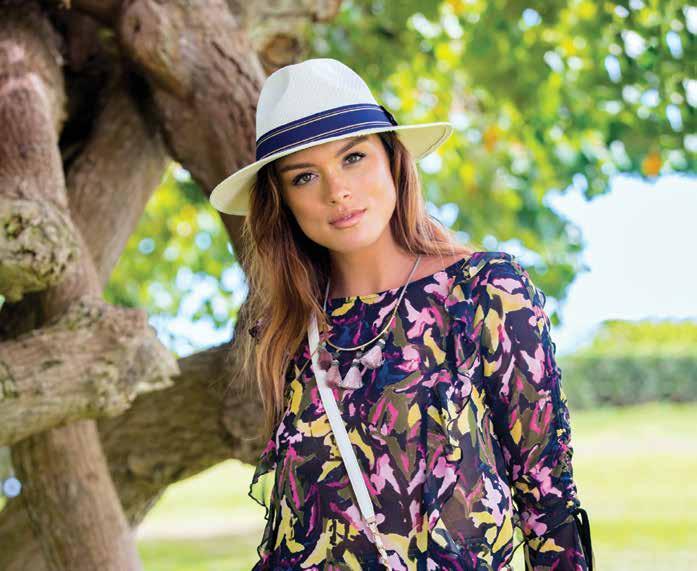









Mon-Sat 9:30am to 9pm Sun 10am to 7pm • AlaMoanaCenter com • 808.955.9517 • FREE WI-FI Your GGP Shopping Destination MORE THAN 350 STORES AND RESTAURANTS INCLUDING ANN TAYLOR • ASSAGGIO • BLOOMINGDALE’S • COACH • DIPTYQUE PARIS • GUESS • JANIE AND JACK • KIEHL’S LE LABO • LULULEMON • MACY’S • NEIMAN MARCUS • NORDSTROM • ROSS DRESS FOR LESS • SAKS OFF 5TH TARGET • THE REFINERY HONOLULU • TOMMY BAHAMA • UNICASE • VINTAGE CAVE CAFÉ • ZARA • & MANY MORE
In October of last year, I found myself in New York City, eager to dine in what many call the culinary capital of the world.
I was there to throw an event with Hawai‘i Tourism USA, promoting the sounds and flavors of the Hawaiian Islands, so with only a few days to spare, I set out to some of my favorite haunts: Russ and Daughters for bagels smeared with smoked fish and cream cheese; Katz’s Delicatessen for slabs of pastrami piled high on rye bread; Hi-Collar, a tiny 10-seat Japanese-style bar, for mentaiko pasta, omurice, and fluffy, towering hot cakes. I went for fried chicken and biscuits in Williamsburg, freshly shucked oysters in Chelsea, Italian food in Greenpoint, and New American in the East Village.
But the best food I had in New York City was not New York City food at all. It was at our event, served by a Maui chef flown in for the weekend: Sheldon Simeon. It was the first time I had tried Simeon’s food. There was ‘ahi poke, served with chili tobiko aioli and kaki mochi; pancit bucatini with bottarga and what Simeon calls “roof lemons” (see page 28); huli-huli pork belly with marungay and shoyu poi; onaga, served lāwalu-style, wrapped in banana leaves, with macadamia nuts and purple potato mash.
Can I just say that Hawai‘i food is having a moment? Simeon competed on Bravo’s Top Chef in seasons 10 and 14, and walked away with top-three finishes and the “fan favorite” award for both seasons. Poke is trending, for better or worse, around the globe. (Just when we thought it couldn’t get any worse, Tail and Fin in Las Vegas debuted its customizable pineapple poke bowls, while Poké Bowl Station—accent theirs—in Brooklyn launched handheld poke wrapped in rainbow-colored waffle tacos.) Try to walk in and get a table at San Francisco’s Liholiho Yacht Club, opened in 2015 by O‘ahu-born Ravi Kapur, who is of Indian, Native Hawaiian, and Chinese descent, without a reservation—you will likely be told to come back in two hours.
Here at home, the culinary scene is an increasingly dizzying bounty. More locally grown choices are within reach on grocery store shelves and in farmer’s markets booths than ever before. Food, as Simeon points out in our interview with him, is as powerful an indicator of culture as language and skin color. For those who hold the islands in our hearts, we know that Hawai‘i cuisine is much more than a trend. It is a reflection of who we are, a commemoration of where we have been, and a beacon of where we have yet to go.
Still, there is much work to do. Governor Ige is committed to doubling local food production by 2020, but less than half a percent of the state’s budget is dedicated to agriculture. So can it be done? Can Hawai‘i become a model for selfsufficiency? “It could be done here better than any state anywhere,” Kunoa Cattle Company co-founder Bobby Farias says, “if you let us.”
With aloha,
Lisa Yamada-Son EDITOR lisa@nellamediagroup.com
EDITOR’S LETTER | FOOD |

MASTHEAD
“Christoph Radl, creative director for Cabana and Interni. I know it would come with an art history lesson and a waterfront view of Lake Como.”
PUBLISHER
Jason Cutinella
EDITOR
Lisa Yamada-Son
CREATIVE DIRECTOR
Ara Feducia
MANAGING EDITOR
Matthew Dekneef
ASSOCIATE EDITOR
Anna Harmon
SENIOR EDITOR
Rae Sojot
DESIGNERS
Mitchell Fong
Michelle Ganeku
PHOTOGRAPHY DIRECTOR
John Hook
PHOTO EDITOR
Samantha Hook
EDITORIAL ASSISTANT
Eunica Escalante
CREATIVE ASSISTANT
Naz Kawakami
“Someone with synesthesia—who can hear what they taste. I want to know what food sounds like to them!”
If you could have dinner with anyone in the world, who would it be?
IMAGES
AJ Feducia
Marie Eriel Hobro
Mark Kushimi
Josiah Patterson
Meagan Suzuki
Lauren Trangmar
Kate Webber
CONTRIBUTORS
Martha Cheng
Beau Flemister
Travis Hancock
Jen Murphy
Natalie Schack
NETWORK MARKETING COORDINATOR
Aja Toscano
WEB DEVELOPER
Matthew McVickar
ADVERTISING
Mike Wiley GROUP PUBLISHER mike@nellamediagroup.com
Chelsea Tsuchida MARKETING & ADVERTISING EXECUTIVE
©2009-2018 by Nella Media Group, LLC. Contents of FLUX Hawaii are protected by copyright and may not be reproduced without the expressed written consent of the publisher.
OPERATIONS
Joe V. Bock CHIEF REVENUE OFFICER joe@nellamediagroup.com
Gary Payne VP ACCOUNTS RECEIVABLE gpayne@nellamediagroup.com
Courtney Miyashiro OPERATIONS ADMINISTRATOR courtney@nellamediagroup.com
Gerard Elmore
LEAD PRODUCER gerard@NMGnetwork.com
Kyle Kosaki VIDEO EDITOR kyle@NMGnetwork.com
Francine Beppu NETWORK STRATEGY DIRECTOR francine@NMGnetwork.com
INTERN Alan Fraser
General Inquiries: contact@fluxhawaii.com
“Barry Obama. To reminisce about our grade school and high school years together and to thank him for a favor he had done for me back in 2008.”
PUBLISHED BY:
Nella Media Group 36 N. Hotel St., Ste. A Honolulu, HI 96817
FLUX Hawaii assumes no liability for products or services advertised herein. FLUX Hawaii is a triannual lifestyle publication.
“Director Damien Chazelle because I’d like to pick his brain about the modern Hollywood industry and how storytelling structure is changing.”
| FOOD |

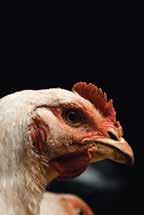
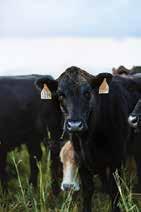
On the Cover
Local chicken or local beef?
In reflection of an age-old debate that continues in kitchens across Hawai‘i over what to eat for dinner, we’ve released two covers for this issue, each dedicated to these homegrown subjects. At J. Ludovico Farm in Waialua, O‘ahu, John Hook snapped this portrait of a meat chicken as part of our photo essay on page 98; in Līhu‘e, Kauaʻi, Josiah Patterson roamed the grasslands of Kunoa Cattle Company for this shot of a Black Angus cow, which you can read about on page 50.

Lauren Trangmar
Lauren Trangmar is a Honolulu-based artist and graphic designer who combines meticulous, traditional processes with contemporary technologies to create surreal imagery. Born and raised in Christchurch, New Zealand, she moved to Hawaiʻi to purse a BFA in graphic design at the University of Hawaiʻi at Mānoa. Her work has been included in private collections and exhibitions in Hawai‘i, North Carolina, Australia, and New Zealand. Most notably, she produced a body of work for the Honolulu Museum of Art’s Artists of Hawaiʻi 2015 exhibition. “Storytelling plays a central role in my work,” says Trangmar, whose playful illustrations accompany “14 Foods That Tell Us Where Hawai‘i Cuisine Is Going” on page 109. “Because my work belongs to an imaginative realm, I always face the challenge of capturing the essence of a story realistically, yet creatively, without pushing it too far. I like to play with form and meaning to create surprising images that are uncanny and humorous yet elicit a strange kind of logic.”

Josiah Patterson
Josiah Patterson is a selftaught photographer from Mākaha. In this issue, he photographed the ranchers of Kunoa Cattle Company for “Beeves of Grass” on page 50. “Sitting in the back of a truck while being given a tour of the ranch, I couldn’t help but notice how vast and beautiful the landscape was. While being on the move posed its challenges, it also gave me unrestricted views of mountains, pastures, and roaming cattle. I wanted to capture the beauty of the place, but also the ranchers and the hard work that they do. Hearing about the sustainable practices they employ and also the challenges that local ranchers go through gave me a newfound appreciation of where our beef comes from.”

Travis Hancock
In the process of writing the story “Beeves of Grass” featuring Kunoa Cattle Company on page 50, writer Travis Hancock got to thinking deeply about what cows, and in turn, humans, eat. This whisked him back to his childhood route to school, which passed the North Shore of O‘ahu’s mystifying Waialeʻe Livestock Experiment Station, where University of Hawai‘i scientists studied cattle that had been fitted with cannula to keep gaping portholes to their digestive tracts open in their sides. Incidentally, Hancock hasn’t eaten beef since he was 16, a fact that Kunoa co-owner Bobby Farias discovered partway through his visit to the ranch on Kauaʻi. “Have you tried our beef bars?” Farias asked. “Um, no, I haven’t,” Hancock replied. “Oh, you gotta try them!” Farias insisted. Hancock confessed he was pescatarian, and to his surprise, found the rancher tremendously understanding—his own wife is vegan.

| FOOD |
CONTRIBUTORS





Cattle roam the grasslands in L ī hu‘e. Image by Josiah
 �
Patterson.
�
Patterson.
FOOD
“When the food is honest, that’s the sweet spot. It needs to be inspired by a moment, or connect to a story.”—Sheldon
Simeon


How Sheldon Got His Groove Back
Sheldon Simeon isn’t trying to reinvent the wheel. Instead, he looks to family history for inspiration in creating his soulful cuisine.
TEXT BY LISA YAMADA-SON
IMAGES BY JOHN HOOK
The line snaking its way along the counter and out the door of Tin Roof, the Kahului lunch joint helmed by Sheldon Simeon, never ceases. For four hours, a steady thrum of hungry patrons neatly file behind one another, waiting to get their hands on bowls filled with mochiko chicken, poke, or dry mein, and, perhaps, catch a glimpse of the guy whose humble persona and cuisine earned him the “fan favorite” award on both seasons 10 and 14 of Top Chef .
It has been a whirlwind of activity for Simeon since his two top-three finishes on the Bravo TV cooking show. He has made appearances at food and wine festivals around the country, started his own YouTube channel with Eater called “Cooking in America,” opened one restaurant, Migrant Maui, in 2014, only to close it in 2016 and open Tin Roof later that year. “I was gone every single month last year,” Simeon says. “But I’m just trying to preach the concept of Hawai‘i cuisine, [for people] to hear it from the horse’s mouth.”
For the born-and-bred Hawai‘i chef, Hawai‘i cuisine is nuanced and often misunderstood. “Everybody calls our cuisine ‘Hawaiian,’ but ‘Hawaiian’ is very specific,” Simeon says. Rather, Hawai‘i cuisine is a celebration of different moments in history, including when immigrants came to call Hawai‘i home, he says, and how it all seamlessly blends together today.
“Next time you go to a house party, just sit back and count the amount of cultures on the table,” Simeon says. “I was just in Hilo this past weekend, and we had beef stew on the table, poke, ‘opihi, kimchi stew. There’s this whole randomness of it, and to us, just felt natural. … Even though I’m not Korean, I associate kalbi as part of my culture. Even though I not Chinese, chow fun is still part of my culture.”
Simeon, who is full Filipino, attributes his philosophy on Hawai‘i cuisine to the plantation towns of Pepeʻekeo on Hawai‘i Island, where his grandparents on his dad’s side worked. He recalls biking through the Chinese and Korean plantation camps, looking for “roof lemons” to slingshot down. “The workers would take lemons, salt and sugar them— everybody had their own way—and put them in these gallon mayonnaise jars and ferment it on the top of their roof,” Simeon explains.
� For chef Sheldon Simeon, shown with his daughters at home in Wailuku on Maui, Hawai‘i cuisine is nuanced and often misunderstood.
FLUX PHILES | CULTURE | 28 | FLUXHAWAII.COM
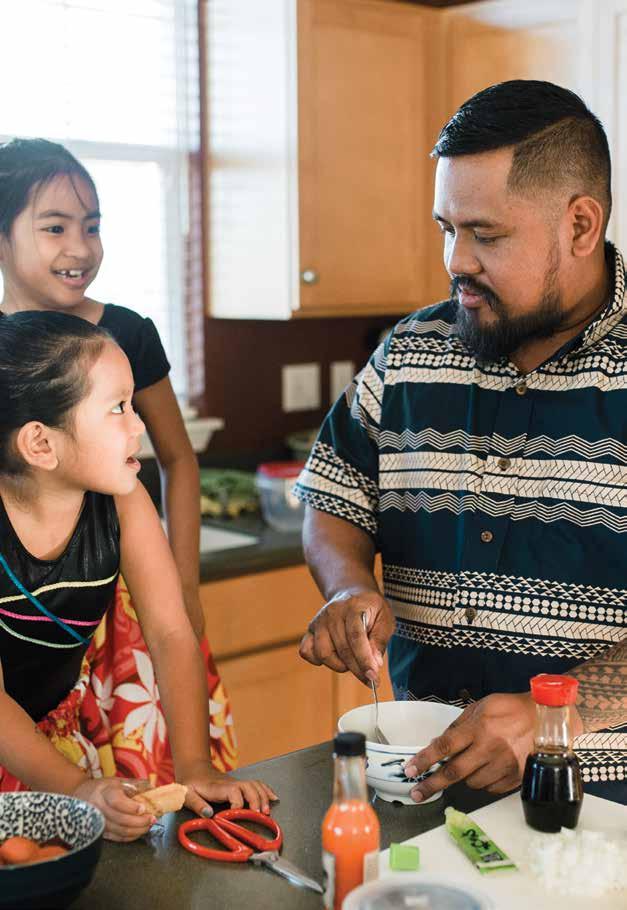

With a large family on both his mom and dad’s sides, large parties naturally followed. His dad, a welder, would fix old stoves and fashion pig roasters and other cooking implements, sizzling dishes like his famous pork guisantes (often called “pork and peas”) in cavernous outdoor woks. “My mom, my dad, all my aunties, everybody always brought over food, and as young kids we were taught to always help out, clean the table, wash dishes. If uncle’s beer is halfway full, you grab him another one before he even asks,” Simeon recalls.
Though he initially wanted to be an architect, Simeon watched his older brother breeze through culinary school (those adolescent days honing their knife skills at family parties, butchering chickens for soups, even a neighborhood goat or pig for large celebrations, paid off). While enrolled in Leeward Community College’s culinary program, Simeon got an internship at Walt Disney World in
Orlando. There he met his wife, Janice, who was interning in the same program. But the work, as a busboy in a Mexican restaurant (“You should have seen my costume,” he says), proved uninspiring. He ended his internship early, completed two more semesters at LCC, then followed Janice home to Maui, where he would work his way up the ranks at Na Hoaloha ‘Ekolu restaurant group, first at Aloha Mixed Plate, then as the chef of Star Noodle.
But after 10 years of grueling 17-hour work days with Na Hoaloha ‘Ekolu, Simeon was burnt out. “I wasn’t always just cooking, it was stressing a lot of time,” Simeon says. “I was just tired.” With no other opportunities in sight, Simeon walked away and spent the entire summer hanging out with his kids. “It was like the first summer we actually went to the Big Island to cruise,” he says.
As it has since small-kid times, family has been what informs Simeon’s culinary
� Simeon combs his family history and classic Hawai‘i cookbooks for inspiration for his recipes, including those for dishes he serves at Tin Roof, his casual lunch spot in Kahului.
30 | FLUXHAWAII.COM


narrative and has contributed to some of the proudest moments in his career. Despite his hectic schedule and the multitudes of people vying for his time, Simeon spent the weekend cooking for his best friend’s baby’s first birthday party in Hilo. “To me, that’s the highest regards of cooking, the highest honor,” he says. “To cook for someone’s first birthday, I’d pick that over the James Beard House any day, to tell you the truth.”
Not that he hasn’t held that honor, either. In February 2017, after winning one of the challenges on Top Chef , Simeon found himself standing in the prestigious James Beard House serving his favorite plate lunch fare of mochiko chicken, rice, and ʻulu mac salad to New York’s culinary elite. It was a redemption of sorts for the chef, who failed to impress the judges in the finale of Top Chef season 10 after departing from his Filipino-inspired cuisine and cooking what he describes as
“fancy food.” But for Simeon, the timehonored Hawaiʻi tradition of a baby’s first birthday is a rare chance to feed his entire family. The same applies to Tin Roof, that unremarkable joint tucked between an island gift shop and a Money Mart. “Tin Roof has been the most rewarding restaurant for me, of all the restaurants I’ve ever done, because it’s a chance to feed my community,” he says.
In all things, Simeon is proud to represent Hawai‘i and Filipino foods, what Anthony Bourdain declared as “the next big thing” in 2017—a declaration that sits uncomfortably with Simeon. “I like that Filipino food gets a shine, but … food is tied in as personal to a nationality as it can be,” Simeon says. “Food and language and skin color is on the same level. Maybe a dish, that can be a trend, or a cronut, that’s a trend! I’m a Filipino, a culture is not a trend.”
� Family informs Simeon’s culinary narrative, which includes the dishes found at Tin Roof, shown right. Clockwise from top left: dry mein with wafu dashi; shoyu poke bowl; local kale tossed with Kula onion dressing; pork belly bowl with lomi tomato and patis vinaigrette; twice-fried mochiko chicken with kochujang aioli and mac salad.
32 | FLUXHAWAII.COM

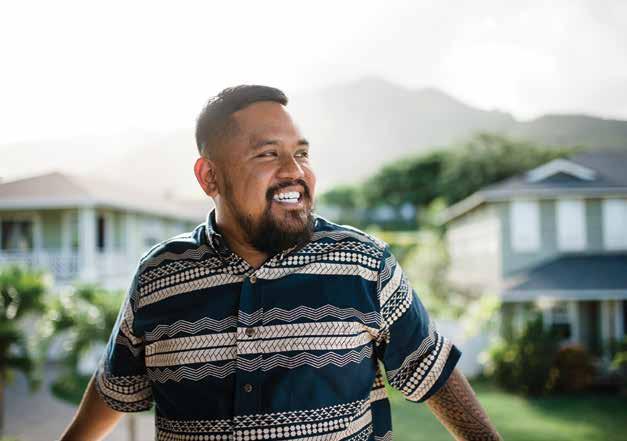
Instead, food should simply be a celebration of cultures. Simeon hopes to expand on this with the opening of Lineage in May at the Shops of Wailea. “Yeah, it will be a fancy restaurant,” Simeon says sheepishly. “I guess it’s chef-ego driven … but this is a moment that I can … express myself fully.” Though the fare might be fancier, the menu remains inspired by Simeon’s mixed-plate upbringing. It will feature an appetizer called the “pūpū line,” a celebration of all the foods one might find as pūpū for a baby’s first birthday party, including pa‘i ‘ai, pohole fern, ‘opihi, and smoked meat. He’s also doing the classic Filipino noodle dish, pancit, but his version is finished with roof lemons.
“I think when the food is honest, that’s the sweet spot. It needs to be inspired by a moment, or connect to a story,” he says. “That storyline is an ingredient that nobody can replicate, no matter if they get the same ingredients, the same recipe.”
� “Tin Roof has been the most rewarding restaurant for me, of all the restaurants I’ve ever done, because it’s a chance to feed my community,” Simeon says.
� Tin Roof is located in Kahului at 360 Papa Pl. For more information, visit tinroofmaui.com.
34 | FLUXHAWAII.COM
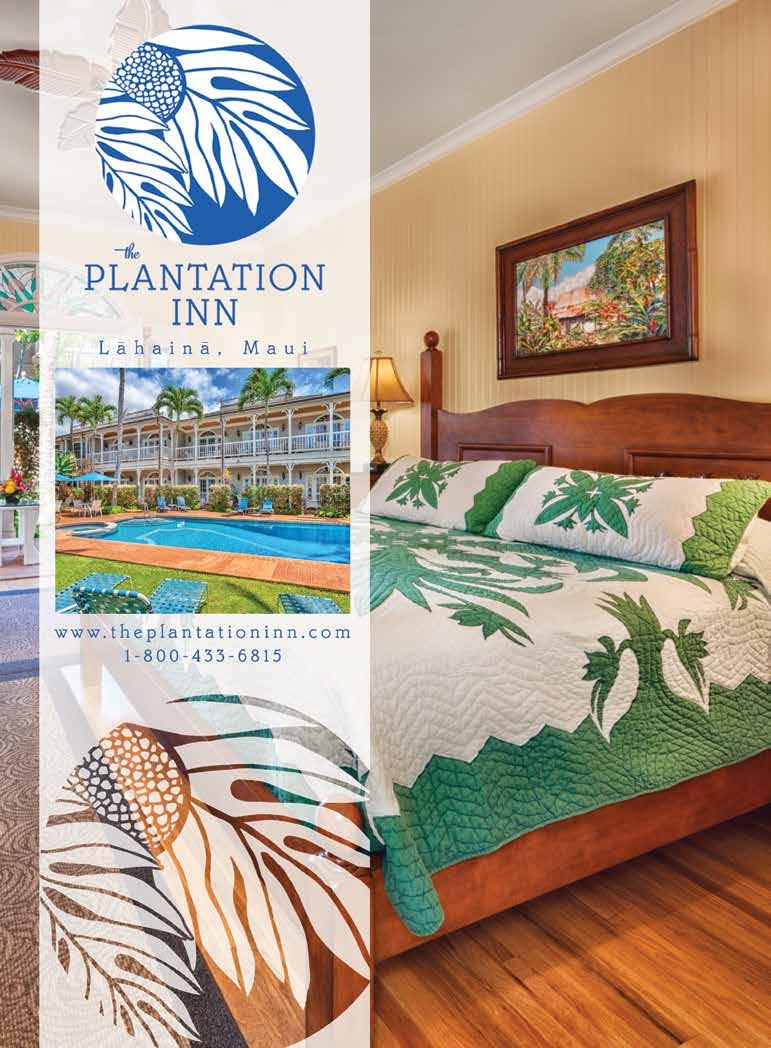
The Valley Provides
The Roots Project cooks up a hearty food system in Kalihi.
TEXT BY NATALIE SCHACK
IMAGES BY MEAGAN SUZUKI
It’s Thursday at Roots Cafe, one of only two days a week the eatery is open, and it is bustling with activity. Diners greet cooks and workers by name, while groups of friends talk story, discuss work over lunch, or share food. It’s an unadorned, humble little thing, consisting of a few dining tables and a lunch counter tucked away at the far back of the Kōkua Kalihi Valley Community Health Center, on the far end of School Street. But it’s got big flavor. This day, the dishes listed on the café’s chalkboard include a barbecue portobello mushroom burger, chickpea curry, and pineapple kombucha. There is a hefty inclusion of ingredients from local farms, which are noted alongside the dish. It is a far cry from the menu of a typical graband-go plate-lunch restaurant.
In fact, Roots Kalihi, the organization behind the café, aims to change what its neighborhood considers standard fare. The organization began under Kōkua Kalihi Valley in 2011 with one grant and a vision to bring health back into Kalihi through food. Six years later, it is juggling six grants and a plateful of projects: the caf é , farmers markets, nutrition education outreach, cooking classes, cultural food events, community gardens, and a program discounting produce for food stamp holders.
The café, which opened in 2013, is a snapshot of Roots Kalihi’s endeavor to reshape the neighborhood’s food systems, from production to distribution to demand, and in body as well as in spirit. Its founders knew that native health couldn’t be truly understood solely through modern, clinical metrics like body mass index or blood pressure. For a roadmap on where to start, they turned to the community itself.
� With Ho‘oulu ‘Āina, Roots Kalihi endeavors to reshape the neighborhood’s food systems, from production to distribution to demand.

FLUX PHILES | COMMUNITY | 36 | FLUXHAWAII.COM

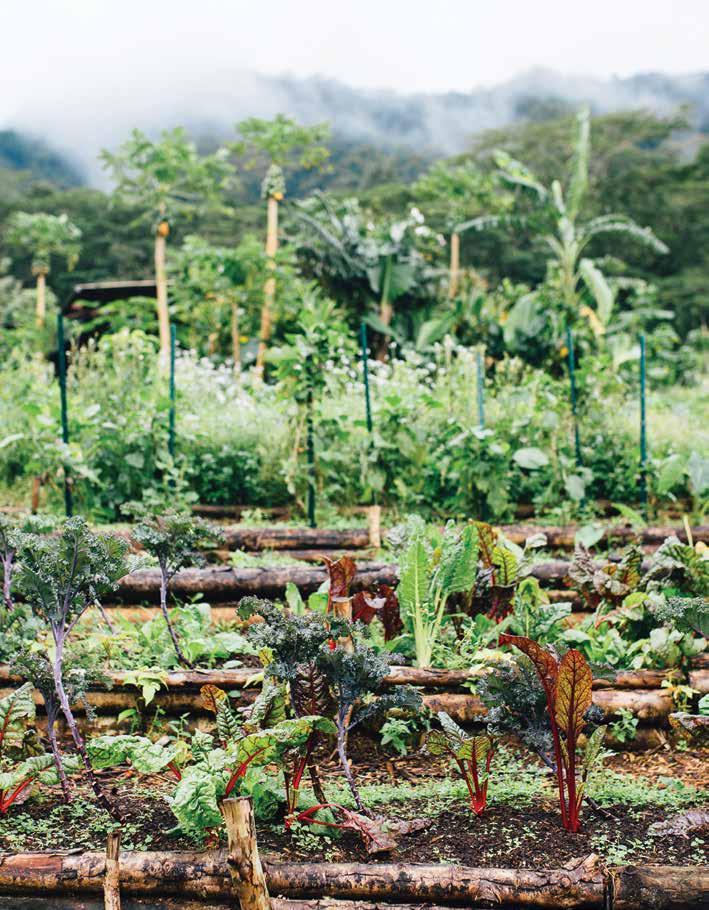
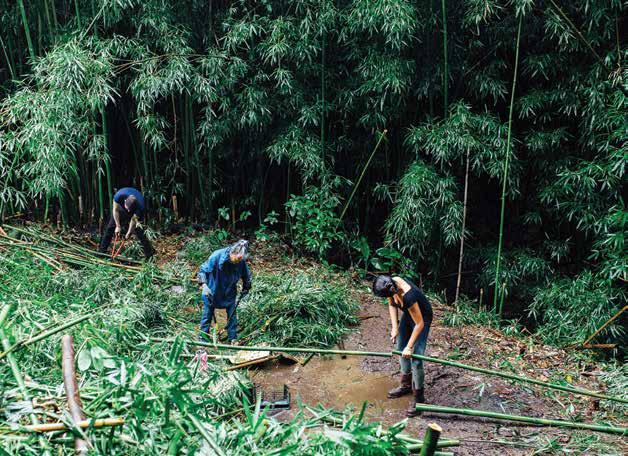
“We really wanted to sit down and ask, ʻWhat does health look like if you’re looking at wellness through indigenous eyes?’” says program director Sharon Ka‘iulani Odom. “Knowing that food connects you to all of your family, your customs, are we taking the time nowadays to share food with neighbors, to share stories with neighbors, to connect?”
The team embarked upon a year of research. They held dinners to which they invited cultural practitioners, thinkers, and community members. They asked each other how they defined good health and when they felt healthiest. The responses weren’t about numbers on a scale, weights lifted, or miles ran. Instead, they were about times when food provided key connections—to places, better selves, others, the past, and the future. Now, with each program, Odom and her team ask themselves how they can help people better connect in these ways.
Informing all programs, always, is a cultural foundation that values the power
of shared and ancestral knowledge and experiences. Special attention is paid to reviving and nurturing the food varieties and traditions of the past that once bound people together, enhanced their sense of place, and connected them to the foods on their plates.
“We want kids to know how to do an imu when they grow up, be able to be in charge and know all the steps,” Odom says. “We teach them how to lay net and how to make squid. We’ve even done haupia from scratch, where they have to get the coconut and grate the coconuts and squeeze it. It’s a family health project, but it’s based around food and taking care of the ‘āina.”
Roots is also improving access to resources. In 2013, the team launched a farmers market at the Towers at Kūhio Park, an affordable housing community. The idea was to give residents who might otherwise find it easier to reach for cheaper processed or fast-food options access to affordable, fresh, organic produce. In 2015, Roots Kalihi also launched a mobile produce cart that
� “We want kids to know how to do an imu when they grow up, be able to be in charge and know all the steps,” says Sharon Ka‘iulani Odom, the program director of Roots Kalihi, which aims to give the community greater access to resources.
38 | FLUXHAWAII.COM



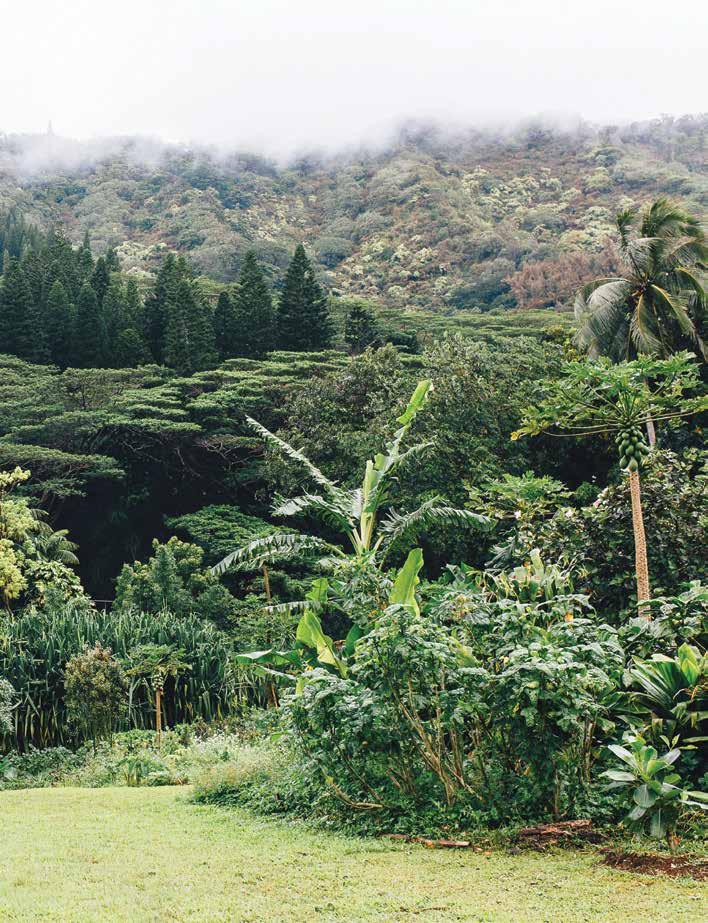

makes rounds at the health center and throughout the neighborhood, stopping at schools and workplaces. They provided access to ancestral foods such as poi and breadfruit. To bring it full circle, the nonprofit also offers nutrition awareness and cooking classes.
As families in the neighborhood get the knowledge they need to prepare wholesome meals, local farmers are finding growing customer support at the markets and health center, and Roots Kalihi’s community gardens are thriving. The cultural food knowledge of yore is being revived. It is busy but rewarding work for Roots Kalihi’s staff of about 15, each of whom contribute their own food-related passions and backgrounds in topics that include farming, nutrition, anthropology, social work, baking, and beer brewing.
Back at the café, employees and volunteers munch on rose and cardamom cookies, homemade by their operations manager, while they stuff gift baskets filled with local fruits, vegetables, and treats for helpers in the back office. Earlier that
morning, the group had come together at sister property Ho‘oulu ‘Āina, a farm and cultural space deep in the valley, for a time of togetherness and meditation. As the early sun began its crest over the Ko‘olau mountains, the Roots ‘ohana recited an oli, or chant, over the space’s four ahu, or shrines. Each individual set his or her personal intention for the coming months, and discussed their gratitude for this ‘āina, these people, and this work.
“We’re doing the best we can for Kalihi, but there are also things we’re getting from working here that’s helping us as individuals to grow,” Odom says. “From a Western point of view, it’s always about getting bigger and better—and that’s not my goal at all. My goal is to make sure that everyone is taken care of.” Roots Kalihi is doing just that, from body to soul, one plate of food at a time.
� Roots Cafe uses fruits, vegetables, and proteins sourced from local farms. While the menu changes daily, it is always affordable.
� Roots Cafe is located in the Kokua Kalihi Valley Wellness Center, 2229 North School St. For more information, visit rootskalihi.com.

42 | FLUXHAWAII.COM

The Buzz on Larvae
Out of artistic expression, a bee farmer stumbles upon an alternative protein source.
TEXT BY RAE SOJOT
IMAGES
BY MEAGAN SUZUKI
When Yuki Uzuhashi was 12 years old, he accompanied his grandfather from Osaka to Nagano Prefecture for a summer holiday. While exploring the mountainous countryside together, his grandfather shared a curious detail from his youth: He had grown up eating hachinoko , or bee larvae. And, his grandfather added, not only was it nutritious, it was also very tasty. More intrigued than repulsed, the young Uzuhashi decided he had to try hachinoko for himself. The duo inquired among their Nagano relatives and eagerly combed local grocery shops for a taste of grandfather’s past, but their search proved futile. Then, as the two sat dejected and empty handed at the terminal waiting for their return bus to Osaka, an aunt strode in with a can of preserved bee larvae. As soon as he got home, Uzuhashi rushed to open the tin. Inside was larvae cooked in a traditional sauce of shoyu, sake, and sugar. It was savory sweet, Uzuhashi recalls. More than the taste, it was the entire hachinoko experience that left an indelible impression on the young Uzuhashi. “Searching for it, getting it, and biting on something unusual—I still remember it all,” he says.
Today Uzuhashi is the owner of Mānoa Honey Company on O‘ahu with nearly 400 hives under his care. Though first a beekeeper, he is foremost an artist. During college, he pursued sculpture, but the heavy mediums of stone and wood felt more onerous than uplifting. He later experimented with performance art, but was wary of works that leaned toward musicals or interpretive dance. Instead, Uzuhashi desired a long-term art form, an ethos that didn’t end in a white-cube gallery exhibit or a one-off performance. Inspiration came on the wings of bees. During his final year in college, Uzuhashi learned of a small tribe of people who traveled each spring from
� Mā noa Honey Company owner Yuki Uzuhashi has nearly 400 hives under his care. Though he is a beekeeper, Uzuhashi considers himself first and foremost an artist.

FLUX PHILES | ARTS | 44 | FLUXHAWAII.COM


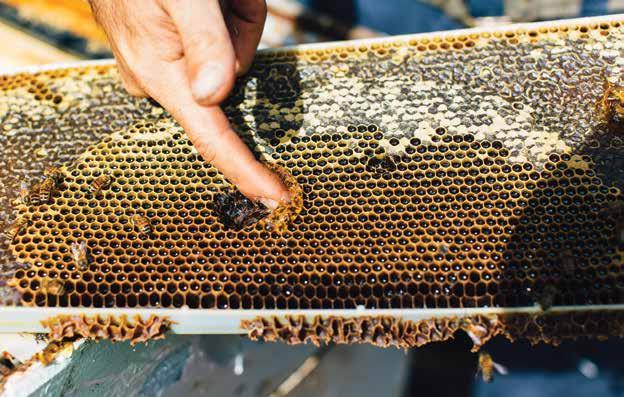
the southern islands of Japan to northern Hokkaido, following the blooming path of flowers, and in turn, bees. They were honey harvesters. “I liked the idea of a bohemian, gypsy lifestyle,” Uzuhashi says. He saw the migratory movement of the blossoms, bees, and beekeepers as organic poetry, a wonderful integrated performance set in nature. “I wanted to be like that,” Uzuhashi says. “Beekeeping would be my life’s expression of art.”
At age 23, he embarked on a beekeeping apprenticeship in Hyogo Prefecture on Japan’s main island, Honshu. Soon, his childhood memory of hachinoko, long dormant, resurfaced. As a burgeoning beekeeper, he was also the quintessential starving artist. “I was very poor,” Uzuhashi says, “so, I started to cook larvae.”
As in many Asian countries, the practice of eating bugs—namely bees, wasps, crickets, and grasshoppers—is not strange in Japan. Records of entomophagy, the formal term for insect consumption, stretch as far back as the Edo period. Though insects are more commonly consumed in rural areas or during times of food scarcity (World War II witnessed Japan’s population resorting to eating bugs out of
necessity), there has been a rise of interest in them as a viable alternate protein source across a wide swath of proponents that include environmentalists, sustainability advocates, nutritionists, and, of course, adventurous foodies. According to the Food and Agricultural Organization of the United Nations, bugs offer the same amount of protein as conventional meats like pork and poultry yet require much less feed, space, and time for growth. Their high content of nutritious fats, vitamins, fiber, and minerals has even led NASA to research insects as a possible food source for future colonies on Mars. Back on Earth, they might also help people to live longer: Nagano Prefecture, where Uzuhashi’s grandfather grew up, has the highest life expectancy in Japan, a country with a population that already averages 83.4 years as of 2015. In Nagano, insect consumption is commonplace, and men and women lead surprisingly active lives well into their 80s and 90s.
“I came into beekeeping from the point of view of contemporary art,” Uzuhashi says. Harvesting bee larvae is an edible extension of his craft. In 2007, Uzuhashi hosted what he called a “Panic Picnic,” as
� Honey is not the only life-giving substance bees provide. As a burgeoning beekeeper, Uzuhashi was also the quintessential starving artist. “I was very poor,” Uzuhashi says, “so I started to cook larvae.”
46 | FLUXHAWAII.COM


part of an art exhibit featuring elements of his life’s work as a beekeeper. Small teams of volunteers were given live hive trays and tweezers, and taught how to peel off the waxy brood nest cappings and extract the larvae, a laborious and meticulous process. Then, a culinary challenge was issued: Each group was tasked with creating a dish utilizing bee larvae. The result? An impressive tasting menu ranging from bee larvae pasta to bee larvae pudding. Sitting together at a long table to eat, “We cheered and gave thanks to a life given from bees,” Uzuhashi says. With each new Panic Picnic came a new set of bug-as-food believers.
Uzuhashi believes that the success of his Panic Picnics stem from the experiential excitement surrounding the discovery of something new. “Art is one of the greatest ways to change people’s perceptions or to expose them to something different,” Uzuhashi says. “Rather than going too straight or too direct into bugs as a protein food, it’s really more about experience.” Naturally, bee larvae rookies are curious, if not concerned, about the taste. Depending on the stage of development—pupa, larva, or adult—each has its own flavor profile and texture, Uzuhashi explains. When
deep-fried and salted, bee larvae tastes like crumbled potato chips. When eaten raw, they pop like ikura, or salmon roe, their flexible, firm exoskeletons giving way to a gush of creamy liquid. “It tastes like milky chestnut,” Uzuhashi says. “We also only eat the drones,” he adds, cognizant of the concern surrounding dwindling bee populations. Drones are different from the larger population of female worker bees. In their lifespans, drones perform one-time roles of inseminating the queen bee, who, once fertilized, lays nearly 2,000 eggs a day. Says Uzuhashi, “Drones play a much less important role than the workers do.”
Uzuhashi is quick to note that he doesn’t consider himself an ardent bug protein activist or even ambassador. To him, beekeeping, whether extracting honey or eating bees, is an iteration of his organic, poetic art form. He’s also diplomatic about the varied reactions—from the bewildered and curious to the bewildered and grossedout—he receives when he tells people that there’s more to bees than just honey, and that bee larvae is, in fact, a delicacy. “Some nod hard,” Uzuhashi says with a chuckle. “And some scream.”
� When deep-fried and salted, bee larvae tastes like crumbled potato chips. When eaten raw, they pop like ikura, or salmon roe, their flexible, firm exoskeletons giving way to a gush of creamy liquid.
� For more information, visit manoahoney.com.
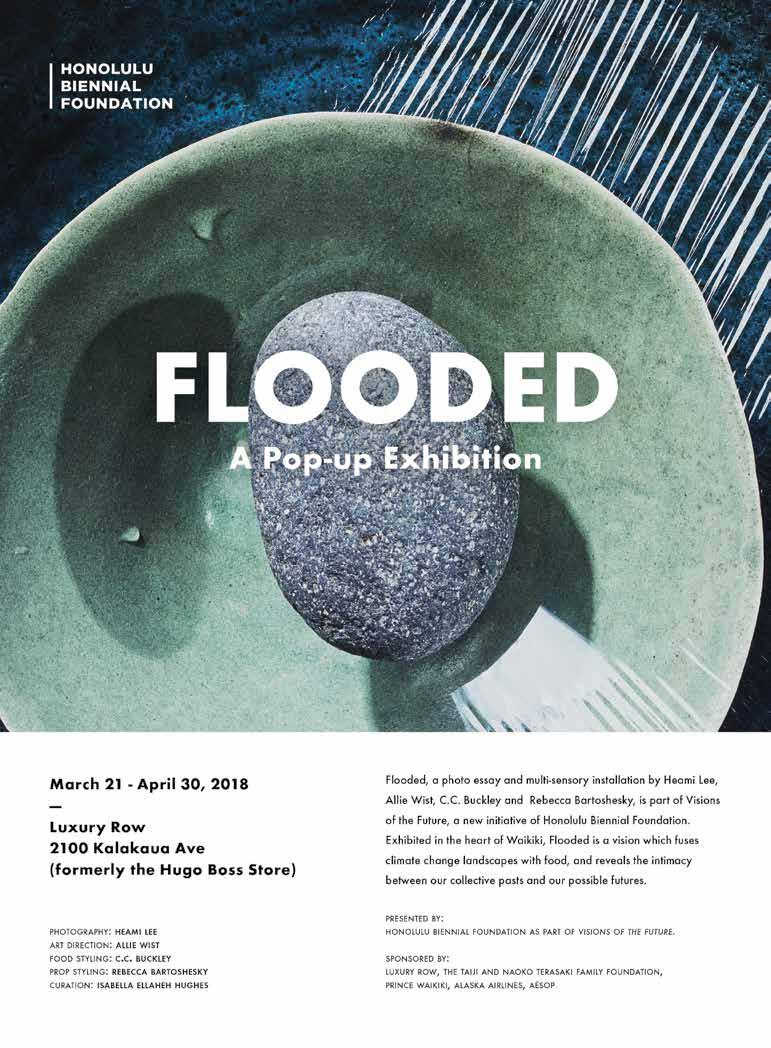
48 | FLUXHAWAII.COM

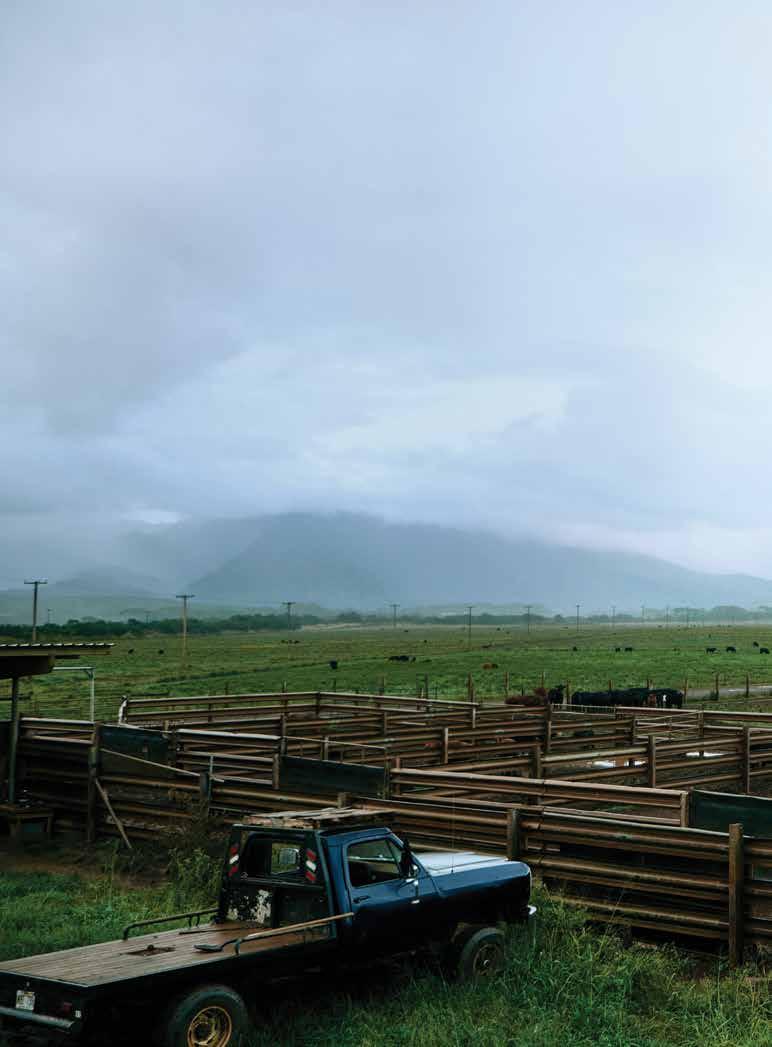 FLUX FEATURE
FLUX FEATURE
Beeves of Grass
The fallow lands left behind by Hawai‘i’s defunct sugar plantations opened the door for cattle ranchers whose old traditions and new ideas could shape the future of island food.
TEXT BY TRAVIS HANCOCK
IMAGES BY JOSIAH PATTERSON


That’s a perfect cow right there,” says Bobby Farias, as he puts his pristine Ford half-ton in park and points out the driver-side window. “Look. Number 41, height is good, good back line, sort of compact, nice and tight.” The cow whose twin ear tags read “41” is of the Black Angus breed, like most of the dozen or so grazers around her. The herd has been keeping pace with the truck as it ambles down the red-dirt road that rounds the perimeter of a sprawling grassland just upslope from Līhuʻe, Kauaʻi.
Farias has operated the Kunoa Cattle Company on these lands for nearly four years, but his roots here go much deeper. His grandfather once oversaw this area as manager of the Līhuʻe Plantation, which closed in 2000. A year later, Grove Farm added the land to its massive Kauaʻi holdings, and let wild guinea grass take over—the kind Farias knew would produce world-class beef. In 2004, Farias started leasing fallow parcels from Grove Farm, and raising calves on the hearty grass, before shipping them off to mainland buyers for grain or corn finishing and then slaughter. But the operation was “a doubleedged sword,” as he is wont to say—cattle kept the land clear and productive, but the standard export model kept Kauaʻi dependent on the mainland for beef it could clearly produce itself.
In 2014, Farias was introduced to Florida transplant and eco-entrepreneur Jack Beuttell, who envisioned a vertically integrated cattle company that could keep its beef in Hawai‘i. But Beuttell’s vision had a catch—it would require taking over the rundown slaughterhouse at Campbell Industrial Park on Oʻahu’s ‘Ewa plain. “I was hell-bent on a slaughterhouse on Kauaʻi,” Farias says. “I’m from Kauaʻi. I do everything on Kaua‘i.” But Beutell, who came equipped with master’s degrees in business administration and environmental management, and had formerly run sustainability programs for a multinational real estate firm, was convincingly pragmatic. Oʻahu’s cost of power is significantly lower, and its
customer base 15 times higher. Farias caved, and Kunoa was born.
Today, on Kunoa’s Līhuʻe land, the moans of bawling calves fill the air. “We’re getting them weaned off their moms, quieted down, and then they’ll get kicked out [to pasture], and then brought back in to get shipped to the mainland,” Farias says. Kunoa itself is still being weaned off the cow-calf model, as it is called in the industry. When Farias drives to the far side of the property, to the pasture where the ideal cow, Number 41, munches grass, he arrives at the dream represented by the Hawaiian word “kunoa,” meaning stand free. It is a dream of freedom from mainland buyers, antibiotics, foreign feed, chemical fertilizer, debt, and the fear of failure.
Farias and Beuttell believe that the best means of achieving independence is through the ranching model called holistic management, which involves rigorous rotational grazing of high-density herds on hearty grass diets. They see this model as far-reaching, with the ability to combat serious problems facing the Hawaiian Islands including the burden of fallow cane lands, the dependence on food imports, the runoff that imperils reefs, and the threat of rising sea levels. So far, the most immediate and persuasive arguments that the model has produced take the shape of USDA-approved prime cuts of beef, stamped with “Made in Hawai‘i” stickers and sold at Times and Don Quijote supermarkets.
But the public hasn’t yet reached a consensus on local, grass-fed beef, or on Kunoa as its lead provider. “Hawaiʻi was trained to buy food,” Farias says, referring to mainland imports. “That’s what Kunoa fights the most out of everything. Does it taste good? Is it tender? Is it marbled enough? Is it profitable? Those aren’t the big issues. The big issues are people saying, ‘I go to Costco for milk. It comes in a jug in aisle 12.’” With every new Costco, Walmart, and McDonalds that opens, imported food, shipped to the islands in bulk, increases its monopoly on local diets via higher convenience and lower costs.
“Hawai‘i was trained to buy food. That’s what Kunoa fights the most out of everything. Does it taste good? Is it tender? Those aren’t the big issues. The big issues are people saying, ‘I go to Costco for milk.’”
Bobby Farias, co-founder of Kunoa Cattle Company
52 | FLUXHAWAII.COM
“

To steer public perception and, hopefully, allegiance toward locavorism, Farias takes every opportunity to speak publicly and show off Kunoa’s facilities. But for all its eye-opening power, Kunoa maintains a historical blindspot— before Hawaiʻi was trained to import its beef, it had to be trained to eat it, at a significant environmental cost. Beef entered Hawaiian diets after British explorer George Vancouver gave King Kamehameha a gift of six cows and one bull in 1793. Kamehameha protected them with a kapu, and the cattle exploded into a herd 25,000 strong by the 1840s—grazing solely, and devastatingly, on native forage. This homegrown herd on Hawai‘i Island was the genesis of island ranching, as Kamehameha III had to import vaqueros from Mexico to train up a new class of Hawaiian cowboys, or paniolo, who funneled the wild herds into beef production at places like Parker Ranch. However, corralled cattle overgrazed and trampled their pastures into desertified landscapes. Ranchers then introduced grasses and fodder that could grow fast enough to keep up—including modern menaces like haole koa and strawberry guava. To hold down topsoil and prevent runoff, they planted Australian eucalyptus and ironwood trees. And ultimately most of the hides, tallow, and meat left the islands for foreign markets.

In a sense, when Kunoa vaunts the power of local beef, it is asking consumers—including a growing base of ecominded millennials—to forget this past and trust a new era of island ranchers to do better by the ‘āina this time around. This
trust hinges on the success of holistic management, which, in the eyes of many ranchers, soil scientists, and scholars from around the world, is at best a complete gamble. Uncowed by the naysayers, Farias and Beuttell are betting on black—namely, the dark,
� To help Hawai‘i achieve food independence and keep its beef in Hawai‘i, Kunoa Cattle Company’s Bobby Farias and Jack Beuttell are betting on the hearty breed known as Black Angus.
54 | FLUXHAWAII.COM

hearty breed with marbled meat known as Black Angus. And Kunoa is all in. “If you find something that will do the community better than cattle, I’ll leave,” Farias says. “I’ll be the first one to move.”
Farias dresses the part of a Hawaiʻi cattle rancher, from the straw cowboy hat and brass belt buckle to the blue jeans and palaka-style shirt with “Kunoa” embroidered on the breast. A lifelong cattle roper who spent years competing in the mainland rodeo circuit, Farias wears the garb like a second skin. The dawn sky is overcast, filling up with sun. As if aware of the unfolding tableau, Farias’s dog Hina Iti, named during Farias’s stint managing real estate in Tahiti, trots over and poses by his boot.
Across the road from Farias is a wire fence almost totally consumed by headhigh grass. “That’s the hardline of the state and Grove Farm,” he says, pivoting around as he maps the area. “That’s Kālepa Ridge. Wailuā River is just on this side of that mountain range.” Farias’s gaze lands on an out-of-place grove of eucalyptus trees a few acres away. “That is the state line, under attack from the biofuel industry,” Farias says. Though Kunoa and biofuel companies work toward a common goal of island sustainability, Farias feels that ranchers, who also feed people and leave a less visible mark on the land, are undervalued. “A lot of the ranchers get pushed around with these higher-yielding crops,” Farias explains. In Hawaiʻi, most land leases defer to “highest and best use” terms, and returns on island cattle are historically low and a long time in the making. “We don’t mind the hard work, the heavy lifting, taking a place that’s completely overgrown, taking down all the trees, getting it all cleaned up. But then when it looks like that, somebody comes in and says, ‘Wow, that would be great for vegetables or something.’” Out go the ranchers.
The sound of conversation draws a steady muster of cows along Kunoa’s fenceline. They eye their ruler squarely.
“See, this is what we want,” Farias says, “cattle that want to know what we’re doing, versus us having to go out there and they’re all hiding in the trees. These cattle just don’t have any bad experiences so they aren’t afraid to come look. Those animals, when they go to harvest, are going to be gentle.”
Kunoa’s four-man herding team, led by multigenerational paniolo Koni Silva, and supported by at least five cattle dogs, puts the cows’ gentleness to the test. As Farias drives ahead and rounds a bend on the road, he inadvertently takes up the rear of Silva’s daily cattle drive. The men on horseback whoop and clap their hands as they press a herd of about 60 into a lane that leads to a holding pen. The dogs bark wildly, darting through dirt clouds and falling hooves. As Farias’ truck begins to approach, a few cows break and charge toward it. The dogs give chase and circle the ankles of a runner, but it leaps over them and bolts for pasture.
“Those will be culled,” Farias says. Skittish cows will raise skittish young, perpetuating a system containing smarter but less efficient cattle. “Culling is an ongoing thing, but I think in about two years we’ll have a really good bunch of cows that are giving us the kind of calves we need,” he says. “They say the difference between a good ranch and a great ranch is all the good cows. You’ve got to grow up enough to say, ‘We’re going to get rid of that good cow and make room for a great cow.’”
Since most Hawaiʻi ranchers do not have their own harvest facilities, culling has historically meant shooting the animal and leaving its disposal to nature. But with its own slaughterhouse, Kunoa has a new set of options for lower-grade animals: hamburger meat, beef bars, stew meat. At present, there are approximately 142,000 head of cattle throughout the islands, the majority of which are dedicated to producing calves for picky mainland buyers. But only a fraction of the animals that remain in the islands will make it into the eight local slaughterhouses—most of which are used privately at ranches around the state and not USDA-inspected. Kunoa
“I think you should take responsibility for that decision to eat meat. You should understand that it was a living creature that gave its life so that you could extend yours, essentially.”
Jack Beuttell, Kunoa Cattle Company CEO
56 | FLUXHAWAII.COM

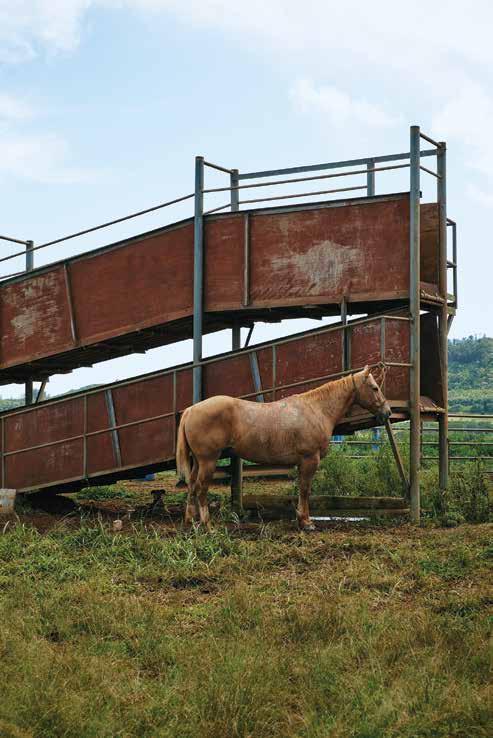
All of the company’s lanes, pens, and harvest equipment fit the ethical guidelines set by Temple Grandin, an acclaimed proponent of humane livestock treatment.

A lifelong cattle roper who spent years competing in the mainland rodeo circuit, Farias utilizes a ranching model called holistic management, which involves rigorous rotational grazing of high-density herds on hearty grass diets.
wants to change that by opening up its facilities to other ranchers, and possibly enticing them to keep more beef in the state—a hard sell while calf sales continue to rank among the state’s top three most valuable agricultural commodities.
The cattle that Silva and his team rounded up jostle around as they get accustomed to the tighter space of the holding pen. A stout black cow with a glossy coat, tagged number 43—a virtual twin of cow 41—made the prime-cut list, and will ship to Honolulu on Tuesday. Fortunately for Silva, getting number 43 there is much easier than it was for his grandfather, who used to march cattle from Kauaʻi’s north shore across the island to Kalapakī Bay.
“They had a special group of horses that would ride into the mountains and rope all the bad cattle,” Farias says. “They would basically rope them and tie them to a tree for a couple days because they were so bad they had to let their horns get worn down a little bit.” Once broken, the leaders could be tied to a horse, and the rest of the herd would simply follow them down to the ocean. The animals then had to swim out to waiting ships, one cow on each side of the horse, which had to tread water until the cows were belly-banded and lifted onto the ship. Eventually, someone thought to replace the horses with canoes, and attach a number of cows to each side like outriggers, speeding up the load time and saving the horses from exhaustion.
Around WWII, shipping containers became the new normal, and today, Kunoa uses its own modified versions with custom, cattle-friendly windows and gates. Come Tuesday, cow 43 will be driven down the lane, then weighed and sent up a ramp into the container. After the short drive to Nawiliwili Harbor, 43 will be loaded onto a Young Brothers barge, shipped overnight, unloaded in Honolulu, and trucked out to the ʻEwa plain where, after wending through another series of lanes, pens, ramps, and scales, it will take a bolt to the brain, get broken down into cuts of meat, ride a conveyor belt into air-sealed
packages, and be placed in giant freezers until the next trucks arrive to take the meat to market.
“I think most people should eat less meat,” says Jack Beuttell over the phone from the East Coast, where he spent the holidays. “I think that when people eat meat, they should eat the right kind of meat, and I want Kunoa to be that kind of meat.” Beuttell has held this unorthodox approach to selling meat since he first pitched the Kunoa model to investors. They liked it, and tapped him to serve as the company’s CEO in 2015. Unlike Farias, who has been around cattle his entire life, Beuttell connected with the animals during the interval between college and graduate school, while working on a Colorado ranch in 2011. Even then, the concept of supplying an entire state with beef was unfathomable. Following a childhood deer hunting trip, he had been vegetarian for 10 years.
“I saw the life in that animal’s eyes when I walked up to it—or rather I saw the death in the animal’s eyes,” he said. “It was just a very intimate, powerful moment for me that made me, for the first time I think, conscious of food, because presumably we were going to eat that deer after I killed it.” Obviously, Beuttell has changed his ways since then, but he works to instill this conscientious approach in Kunoa’s treatment of animals. All of the company’s lanes, pens, and harvest equipment fit the guidelines set by Temple Grandin, an acclaimed proponent of humane livestock treatment.
“I am trying to bring more honesty and integrity to the space, and to the people that buy my product,” Beuttell says. “I think you should take responsibility for that decision to eat meat. You should understand that it was a living creature that gave its life so that you could extend yours, essentially. A lot of people don’t like that concept, but I sort of think with a scientific mind. If you look at human’s biological evolution, there’s a very tight relationship between human evolution and meat proteins.”
� At present, there are approximately 142,000 head of cattle in the Hawaiian Islands, the majority of which are part of calf-raising operations for mainland buyers.
60 | FLUXHAWAII.COM

Beuttell’s interest in biological history primed him for his encounter with the ideas of Allan Savory, the godfather of holistic management. The white Zimbabwean rancher and ecologist has been promoting the concept for 40 years, but hit a tipping point in 2013, when his TED Talk went viral. “In nature, grazing species live in herds and move in herds that are tightly bound by predators lurking on the perimeter of the herd, picking off the weaklings,” Beuttell says of Savory’s ideas. Holistic ranches mimic this through tactical fencing and culling. “The livestock follow the feed,” Beuttell continues, “so they eat that forage down voraciously and as they move along, they poop, they pee, their saliva actually serves as a stimulant of sorts to the grasses, and their hoof action turns the soil over and reseeds the grass, like a very superficial disking of the soil, and those animals then move on.” Over time, he explains, grasses evolved along with the species that grazed them.
In Beuttell’s inventory of the cattle’s various bodily emissions, he left out the most problematic one that Savory’s acolytes and for-profit Savory Institute are up against: methane from the animals’ flatulence and decomposing manure. A 2017 Penn State study found that livestock in the United States could be emitting as much as 19.6 billion pounds of methane gas per year. But proponents of holistic management attribute this to the industry’s status quo, the feedlot model, which holds animals in large, static spaces that gradually desertify land under the steady churn of hooves, and contains fermenting manure in nearby lagoons. Savory’s followers claim that the grass stimulated by roving ungulates actually sequesters carbon emissions through photosynthesis, reversing global warming. But the ostensible proof that moving herds can even affect grass growth rates, let alone greenhouse gases, has been hotly debated. Complicating matters, Savory has historically dismissed empirical studies altogether, claiming that holistic management is endlessly adaptable to different settings and thus produces unrepeatable results.
Looking past the fray, a number of ranchers around the world have cherry-picked from Savory’s strategy to find solutions that work best for their environs. At the moment, Kunoa is doing just that—as are some other Hawaiʻi ranches, though more out of tradition than newfound inspiration. Still, the current reality is that even if Savory’s ideas were definitively quashed tomorrow, Kunoa’s steadily moving herd of 2,500 is too small to significantly alter Kauaʻi’s rain-soaked landscape, for better or worse. But then, Kunoa wants to grow.
“We can put more cattle per unit of land because we have healthier land, and we have more productive land,” Beuttell says. Kunoa is nearing a goal of raising $3 million to buy more cattle, lease more land, upgrade the slaughterhouse’s capacity, and build an education center outside of it. In 2017, Kunoa was named a candidate for one of the Savory Institute’s satellite training centers known as Savory Hubs.

“What we’re trying to do is essentially shed light on these practices and create a way for consumers to engage with that narrative, to learn and understand why they should support this practice over the mainland feedlot model,” Beuttell says. “That’s where I think Kunoa is adding value and making a difference. We are essentially a vehicle for education.”
The coastal area now known as Campbell Industrial Park, where Kunoa’s slaughterhouse sits today, was once the finishing area for cattle belonging to 19th-century industrialist James Campbell. In August of 1885, the editor of Honolulu’s Daily Bulletin, Daniel Logan, joined a cavalcade of journalists from every major Honolulu newspaper, and went on a mission to explore the 43,000-acre world of Campbell’s Honouliuli Ranch. On arrival, Logan found the
62 | FLUXHAWAII.COM
� A 2017 Penn State study found that livestock in the United States could be contributing as much as 19.6 billion pounds of methane gas per year. Proponents of holistic management claim that the grass stimulated by cattle actually sequesters carbon emissions.
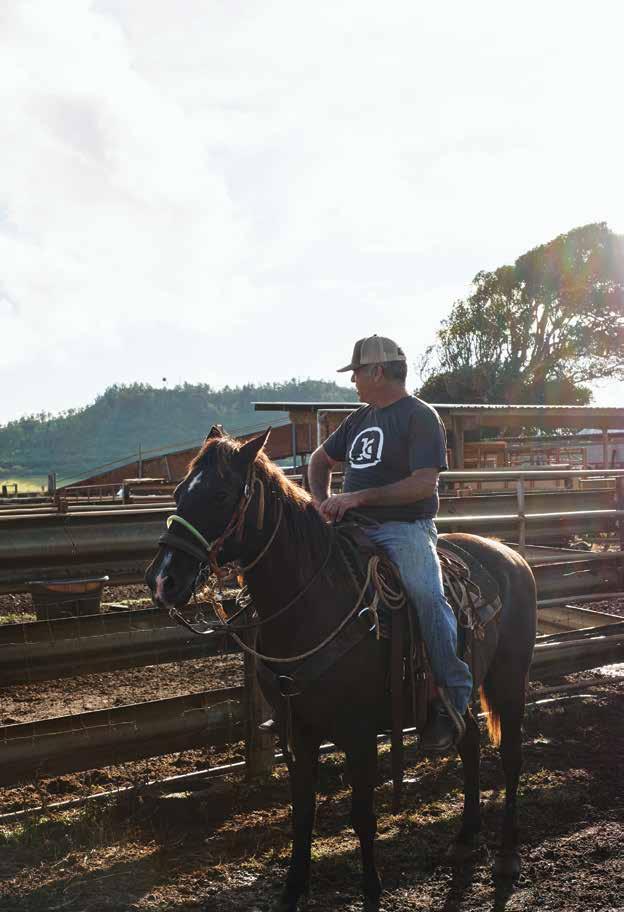
cattle grazing on native species that covered the slopes. In the seaside finishing paddock, he found “thick growths of pili, mākuʻekuʻe, pualele (milkweed), mānienie, kūkaepuaʻa, and other native grasses,” a vision far from the modern standard of finishing on grain or corn.
Campbell’s feeding practice was also at odds with the recommendation of the Planters’ Labor and Supply Company, an elite organization of white planters, which reported in 1883 that “the grass for stock which flourishes best on the island is the kind called ‘guinea.’” An invasive species of grass from Africa, Megathyrsus maximus, or guinea grass, was purportedly first introduced in the mid-1800s by Judge Lawrence McCully to Kaʻu on Hawaiʻi Island. It grew so well, the Planters’ report stated, that “[Charles Reed] Bishop said that this kind of grass ought to be more generally introduced. He had no doubt that it would prove valuable to feed stock.” With the seal of approval from Bishop— and a record of proven success in colonial agriculture projects in South Asia and the Caribbean—the introduced guinea grass became the feed of choice for island ranchers, and it remains so to this day.
And yet it seems that the decision to rally behind guinea grass was made in haste. Campbell’s herd of 5,500, which was subsisting and finishing on mostly native grasses, supplied one third of Honolulu’s daily meat consumption in 1885. What’s more, “The ranch is capable of supplying a much larger daily quota of beeves,” Logan wrote. “If the grasses, and other plants in their present condition, mean anything, they indicate enough and to spare for herds numbering twice five thousand.”
The planters’ quick deference to guinea grass derives from its ability to outpace foreign grasses introduced earlier to the islands. In 1889, the Hawaiian Gazette reported, “It is well known to all country residents that the native grasses have been steadily ousted by two foreign intruders, viz.: Hilo grass and mānienie.” Unfortunately, neither Hilo grass nor mānienie, also called Bermuda grass, produced quality beef. Instead of working to re-establish the wholesome
native grasses that fed Campbell’s cattle, which would have required time, space, and controlled breeding and grazing, the planters conducted an experiment. They tried sowing imports like guinea grass right over patches of Hilo grass. In a short time, the Gazette reported, “The foreign grasses, in spite of a luxuriant growth of Hilo grass, were holding their own famously.” Ironically, the success of guinea grass was seen as a win for diversity—making cattle, once an exclusively royal holding, viable to the haole planters whose coffers were previously dependent on sugar. As it turned out, the guinea grass spread indiscriminately throughout the cane fields, leading planters to introduce herbicides to the soil, and thus the water beneath it. With a trickle-down effect similar to so many other introduced elements of Hawaiʻi’s history, the cow was a big drop in a small pond, and it still ripples like wind across a field of grass that will never give a native plant a chance to break the soil. This, too, is the price, of local, grass-fed beef.
“The guinea grass is a double-edged sword,” Farias says, driving down a muddy road through Kunoa’s coastal finishing paddocks, immediately north of Līhuʻe Airport. The use of the metaphor speaks to his ability to look at problems from both sides, but this time he is being quite literal. If guinea grass grows too tall, its sharp edges slash the cows’ eyelids, which can attract flies, cause infections, and ultimately lead to a culled animal. But they let the grass here grow tall and seed out for practical reasons. “We’ve never planted any grass. This grass is trying to come back natural. It’s fighting all that herbicides and all that they put down,” he says, referring to the old sugar planters and the area’s last tenant—Syngenta.
In recent years, Syngenta, which grows seed corn on Kauaʻi, has faced fines from the U.S. Environmental Protection Agency and been taken to court for its pesticide use. By comparison, the ranchers raising guinea grass seem rather benign, and maybe in the broad scheme of things, it is better to have
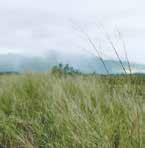
� For Farias, growing grass is better than what his neighbors are growing, which include genetically modified corn crops for seed, invasive eucalyptus trees for biofuel, and even massive solar fields for energy.
64 | FLUXHAWAII.COM
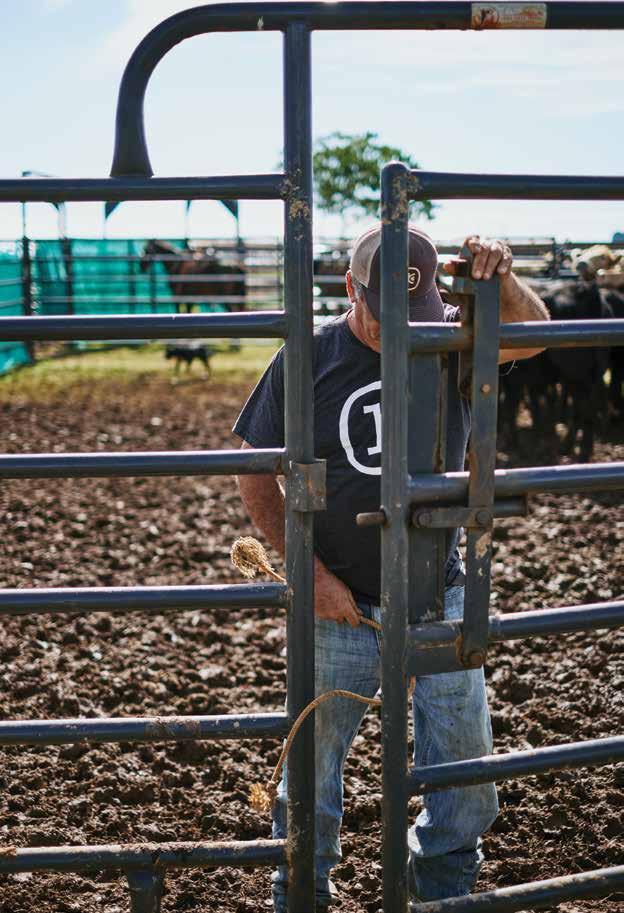
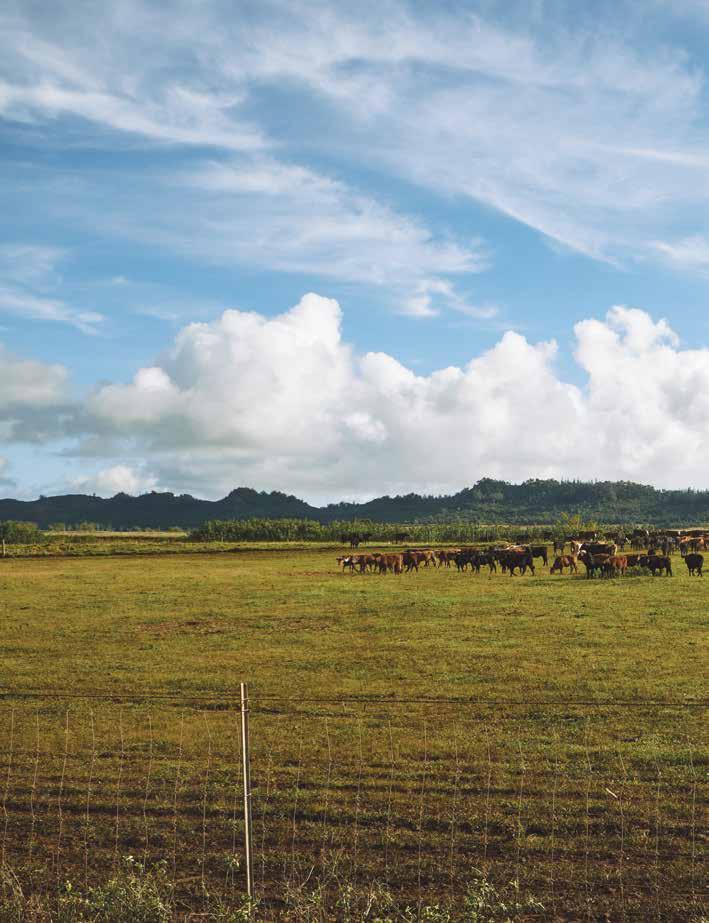


an introduced mammal keeping introduced grasses in check. As far as Farias is concerned, any grass is better than what his neighbors are growing, including genetically modified corn crops for seed, invasive eucalyptus trees for biofuel, and even massive solar fields, which are being developed by Tesla. Because the solar panels sit close to the ground, they actually hog the sun, preventing any undergrowth that would trap the topsoil. “It’s a monoculture,” Farias says. “If we all approach agriculture that way, then we’re going to be in trouble.” For Kunoa’s part, solar is relegated to the roof of the harvest facility. And while beef itself may be a monoculture, Farias reasons that “it’s a moveable crop.” In other words, it’s a stopgap against larger, less pono powers.
The dirt road ends at the edge of a bluff, and Farias parks his truck, its tires enveloped in red mud. He throws a stick for Hina Iti, then turns to survey the view—some tasseled grass, a few ironwood trees, and the wide, blue ocean.
“This is why we’re never going to own ranch land,” he says. The landowners and developers see too much potential, a higher, better use. “They’re going to sit here and have a drink and tell everybody how you can’t sell this for what Bobby wants to pay,” he says. Farias lets his thoughts run on, from hotels, to school lunches, to Mark Zuckerberg, and then recalls a recent run-in with Governor David Ige.

The governor asked him what he thought about increasing local food production, to which Farias replied, “I don’t see it.” Ige was stunned, saying, “I thought you, of all people.” But because the government only devotes less than half a percent of its budget to agriculture, Farias stood his ground. He
says that he told Ige, “We’re not magicians. You guys brag on the tourist numbers because that’s how much you put into it, you know? It’s like a bank account— you only get out of it what you put into it. So can it be done? It could be done here better than any state anywhere, if you let us.”
� Currently, less than half a percent of the state’s budget is dedicated to agriculture, even though it has set a goal to double local food production by 2020.
68 | FLUXHAWAII.COM
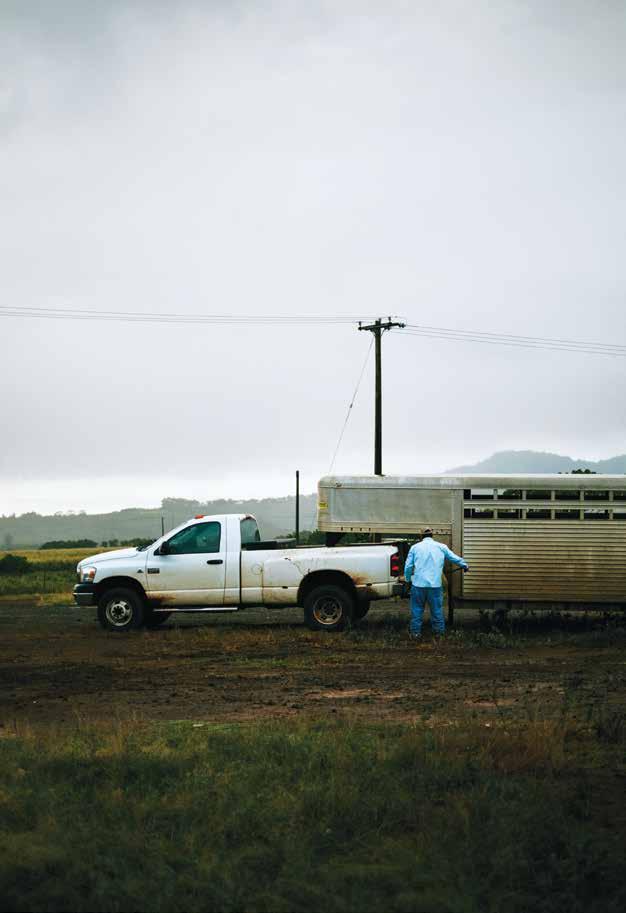 FLUX FEATURE
FLUX FEATURE
Redemptive Roots
Hawai‘i’s prisons are preparing inmates for life beyond bars through farming programs that not only feed the prisons, but also the community at large. Although some consider these programs controversial, in the end, they may provide the solutions that redeem us all.
TEXT BY MARTHA CHENG
IMAGES BY MARIE ERIEL HOBRO & JOHN HOOK
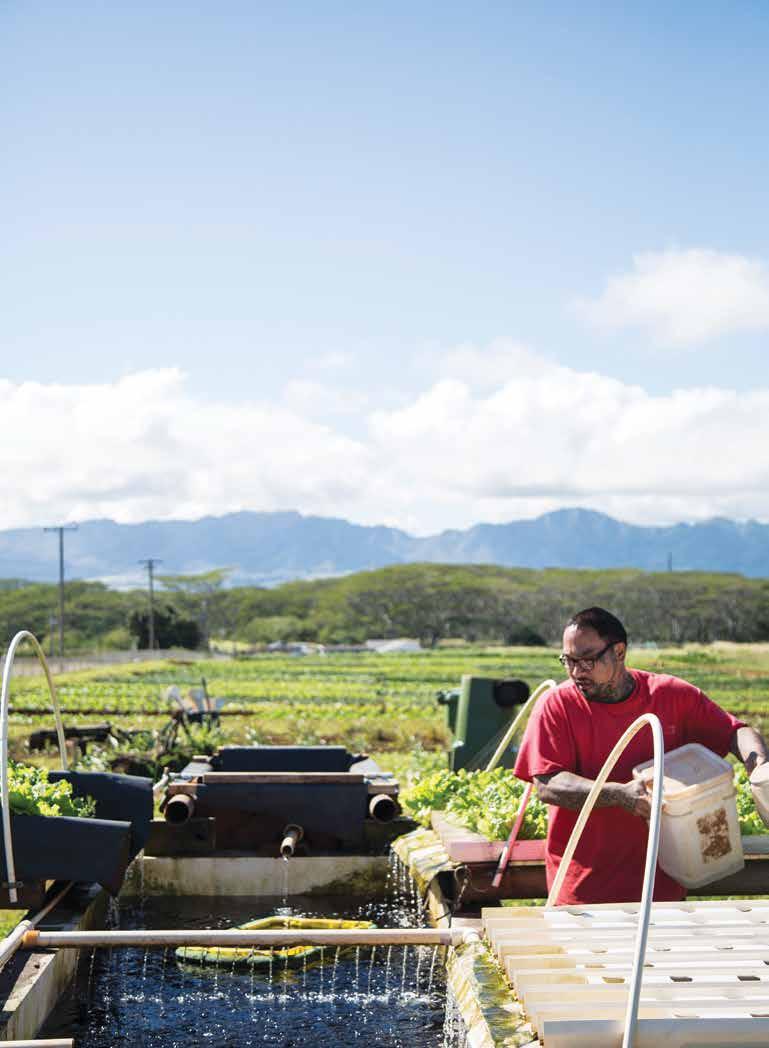
It’s going to sound kind of weird, but I originally got into baking because I used to sell and make drugs,” Tricia Liupaono says. “When you cook cocaine, it’s a chemistry, and pastry is a chemistry.”
Liupaono, who was convicted on drug charges and served four years in state prison, now works as a pastry cook and baker at Aulani and Embassy Suites by Hilton in Kapolei. She has a knack for transferring her skills from the illicit to legal. Since she was released from prison in 2011, she has cooked in kitchens from Morimoto to Sullivan Family Kitchen, the production facility for Foodland and other subsidiaries, where she was promoted to manager. Before then, “the only thing I supervised and managed was dealing drugs, and it’s kind of the same concept,” she says. “I was in charge of ordering, and I never ordered fruit before, but I knew the concept of supply and demand, and I knew how to buy wholesale, break it down to make it a profit.”
While the state doesn’t keep data on the professions of former inmates, anecdotal stories indicate many find their ways into the restaurant and food industry. “There are so many convicts and felons that are really good at [working in restaurants],” Liupaono says. In some ways it is a natural fit for those who eschew office jobs, who can take the hot and physical labor that restaurant work entails, and, like Liupaono, who enjoy the adrenaline rush.
The food industry was also one of the few avenues available to her after prison. “It’s not that I only wanted to do culinary,” she says. But her conviction of distribution of a dangerous drug precluded her from jobs in the travel and nursing fields, other areas in which she was interested. In the restaurant industry, she says, people “never did discriminate who I was, where I came from, never judged me. It’s such a big and
huge industry that they need people. Do you need a background check to cook turkey and flip burgers or chop onions? No. You can take it as far as you want. As soon as you get your foot in the door, as soon as they see who you are as a person, the criminal record fades away and they don’t care about it anymore.”
And the restaurants need them. In Hawai‘i, the restaurant and food service industry employs 14 percent of the labor force, second only to the government. In addition, Hawai‘i’s unemployment rate hit a record low of 2 percent in December 2017, shrinking the labor pool and making it difficult for employers to find people. Add to that the lowest wages out of any major occupational group—restaurant workers earn an average of $22,165 annually—and it’s easy to see why there’s a constant labor shortage in the industry.
Russell Siu, chef and owner of 3660 on the Rise and Kaka‘ako Kitchen, has for years hired former inmates and inmates on work furlough. “It’s hard to find help,” he says. “And we like to give them the opportunity.” Most of the people Siu hires have been convicted on drug charges; some of them go back to using and drop out of the kitchen. “There’s a 50-50 chance these workers will make it,” Siu says. Even on general terms, the restaurant industry’s turnover rate is high: 70 percent was the national average as of 2016.
Currently, Siu employs three former inmates at Kaka‘ako Kitchen. One of them, Frank Scott, 41, has worked there for five years. He began as a dishwasher and is now the front-of-house manager, one of the first people you meet when entering the restaurant. He was in and out of prison on theft and drug paraphernalia convictions starting at age 26. After prison, he thought he would go into construction. “I didn’t want to use my brain,” he says. Instead, through a friend, he heard about the
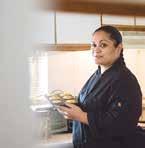
“I was scared and worried about finding a job. With a felony background, I really don’t know where I would have been.”
Tricia Liupaono, pastry chef
� Tricia Liupaono’s conviction precluded her from jobs in the travel and nursing fields. The food industry was one of the few avenues available to her after prison.
72 | FLUXHAWAII.COM
“

 � Lyle Botelho, left, and Daniel Stephens, right, pick cabbage at the Waiawa Correctional Facility in Waipahu.
� Lyle Botelho, left, and Daniel Stephens, right, pick cabbage at the Waiawa Correctional Facility in Waipahu.


job opening at Kaka‘ako Kitchen. Since then, he has learned to write checks and manage people. “I have to say, I think I should have been doing something like this,” he says. “I’m such a social person. I like to talk to people and so forth. It doesn’t bother me to actually hold a conversation with people.” Siu’s wife, Marcy Uyehara, who runs Kaka‘ako Kitchen, calls him “Mr. Aloha.” Over the span of an hour, he leaves our conversation three times— to follow up on an older couple’s dinner order and to greet regulars with a kiss on a cheek. He says people even recognize him from his cameos on OC16’s The Champ Show and Terrace House , a Japanese reality TV series.
That’s the thing about restaurants: They are large, consumer-facing businesses where, in the end, no one cares whether you’re a Harvard grad or a convicted felon, as long as you can do the work.
It makes sense, then, that the Women’s Community Correctional Center on O‘ahu’s east side offers for-credit culinary classes through Kapi‘olani Community College, which Liupaono signed up for when she was incarcerated. “I was scared and worried about finding a job,” she says. “With a felony background, I really don’t know where I would have been, what I would have done when I got out of jail, if I would have gone back to selling drugs, if I didn’t have [culinary] as my backup.”
Since leaving the Women’s

Community Correctional Center, Liupaono has earned an associate degree in pastry arts from Kapi‘olani Community College. She has worked at events like the Hale ‘Aina Awards, and has even helped organize a KCC fundraiser benefiting women.
Hawai‘i’s recidivism rate of 52 percent suggests that a job alone isn’t enough to keep former inmates from returning to prison. But for Scott, the bonds that kitchen culture forges, with its high-intensity environment and close interactions with other
� Prisons like the Women’s Community Correctional Center and Waiawa Correctional Facility use agriculture to teach focus and discipline, skills inmates will need for jobs once they get out.
76 | FLUXHAWAII.COM


At Waiawa Correctional Facility, the rate varies, but inmates are paid up to $2 an hour for labor on the farm. There are more applicants signed up for the program than there are available slots. Since 2011, at least eight former inmates have gone on to work in agriculture. Shown here, Leighton Fuentes plants seeds in Waiawa Correctional Facility.
 Waiawa Correctional Facility’s nearly 200 acres include prison facilities, an 8-acre farm, an aquaponics farm, a fruit orchard, a koa forest, and a Christmas tree farm.
Waiawa Correctional Facility’s nearly 200 acres include prison facilities, an 8-acre farm, an aquaponics farm, a fruit orchard, a koa forest, and a Christmas tree farm.
workers, helps. “I always keep that in the back of my mind—I can always get in trouble,” he says. “I separate myself from the friends I knew. I keep my circle small. And I work. I think about this place a lot. Sometimes I even dream about this place. It’s a business and it’s family. My boss is like my mom. She’s on me all the time: ‘If I ever catch you with drugs…’ We’ve become really close, and it’s kept me out of trouble.” Monday through Friday, 11:30 a.m. to 9 p.m., Scott is at the restaurant.
Inside the prisons, some programs use growing food to teach focus and discipline, skills the inmates will need for jobs once they get out.
Waiawa Correctional Facility, formerly a military installation, was converted to a minimum-security prison in 1985, and its prison farm program began in 1987. Across Waiawa’s nearly 200 acres are prison facilities, an 8-acre farm, an aquaponics farm, a fruit orchard, a koa forest that the prison maintains for University of Hawai‘i researchers, and a Christmas tree farm that supplies state, city, and county agencies. Here, at almost 1,000 feet in elevation, where vegetation is thriving, the air feels cooler. Neat rows of lettuce stretch out in front of the barracks, and the tops of Christmas trees peek out over other trees.
Wearing faded red shirts, 37 inmates harvest lettuce from the ground, as well as vegetables including ong choy and

mustard cabbage from the aquaponics setup. The farm yields 2,000 to 3,000 pounds of produce a week, supplying about 10 percent of the vegetables in Maui and O‘ahu prisons. In line with Governor Ige’s goal of doubling local food production by 2020 and
recent farm-to-school initiatives, the long-term plan is for Waiawa’s farm to supplement all of the state’s prisons, as well as the state’s schools.
Inmate Leighton Fuentes, who is in Waiawa for robbery, can name at least five varieties of lettuce
� “To see life, see something go from nothing, being renewed, grow, it gave hope for the situation and predicament that we were in,” says Tricia Liupaono, who now works as a pastry cook and baker at Aulani and Embassy Suites.
80 | FLUXHAWAII.COM

grown on the farm, including Tropicana, ānuenue, and a Korean green leaf lettuce, which is his favorite. “The more you put into it, the more you can see the results,” Fuentes says. “We don’t use any pesticides or herbicides. Everything we do to keep the weeds in check, we do by hand. So if you let it slip, it’s going to show. It helps to develop a good work ethic, and helps us to work together, work in unison.”
Fuentes spends his time in the greenhouse, sprouting the seeds and transplanting the seedlings in the field. “It’s really, really satisfying to see the fruits of labor,” he says. “And it’s a peaceful respite.”
For inmate Kevin Harris, serving time for unauthorized entry into a motor vehicle, it’s caring for another living thing that gives him gratification. He monitors the fish in the aquaponics system, which, last year, yielded 1,200 pounds of fish that was given to the KCC culinary program. (They can’t be fed to the inmates, for the risk of choking on bones.) “Idle time is where we go wrong,” Harris says. “For me, it’s having responsibility [that keeps me out of trouble], and having responsibility is taking care of the fish.”
Waiawa’s farm is not unique. Prison farms exist in many states and on much larger scales. At the Louisiana State Penitentiary, the largest maximum-security prison in the United States, inmates harvest four million pounds of vegetables, while the Cañon City prison complex in Colorado houses a 30-acre produce farm that supplies the prison. Some consider prison labor—in particular, the labor that supplies commercial businesses—exploitative. In response to protests in 2015, Whole Foods stopped selling cheese made with goat milk from Cañon City’s prison goat dairy. But others consider the labor part of a rehabilitation process, providing inmates with psychological benefits and a skillset
for when they are released and enter the work force. At Waiawa, the rate varies, but inmates are paid up to $2 an hour, and there are more applicants wanting to work the farm than there are available slots. (The prison hopes to get more funding for supervisory staff positions, so that 20 to 30 more inmates can work on the farm.) Since 2011, at least eight former inmates have gone on to work in agriculture.
Over at the Women’s Community Correctional Center, the hydroponics system functions as therapy as much as it does food production. The Lani-Kailua Outdoor Circle partnered with the women’s prison to create the hydroponics program in 2008. “We built those machines from the ground up,” Liupaono says. “That whole place was all trash. There was nothing, it was all dead. [The Outdoor Circle] taught us how to do hydroponics—it was the best program I was ever in. To be able to see something grow from a seed into a big entire plant that feeds you, that whole experience was indescribable. And just to see life, see something go from nothing, being renewed, grow, it gave hope for the situation and predicament that we were in.”
The women harvest more than 200 heads of lettuce a week, which are sold at five Foodland locations on O‘ahu. The Lani-Kailua Outdoor Circle manages the program and reinvests the profits back into it.
Hyacinth Poouahi, who has been incarcerated at the Women’s Community Correctional Center for eight years, says working the hydroponic farm has been healing and has helped her get along with others. “And I just enjoy it,” she says. “For those couple of hours that we come down here, it makes you feel like you’re not in prison, because you get to work with the land.”
“The more you put into it, the more you can see the results. … So if you let it slip, it’s going to show. It helps to develop a good work ethic, and helps us to work together, work in unison.”
Leighton
Fuentes
� Andrew Kaoihana mends his section of the Waiawa Correctional Facility farm.
82 | FLUXHAWAII.COM

Defining Dinners
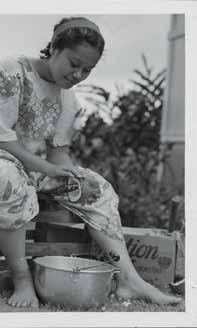
Hawai‘i’s iconic flavors go hand-in-hand with the customs that shaped them. Here are three historic meals that have gone on to forever alter the islands’ culinary landscape.
TEXT BY MATTHEW DEKNEEF & RAE SOJOT
IMAGES COURTESY OF HAWAI‘I STATE ARCHIVES
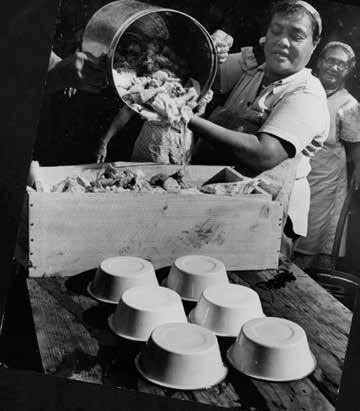
84 | FLUXHAWAII.COM
FLUX FEATURE


BREAKING KAPU: WHEN HAWAIIAN MEN AND WOMEN FIRST ATE TOGETHER
November, 1819. On the shores of Kailua, Hawaiʻi Island, the stage was unassuming, but set: two tables and woven mats—one for kāne, the other for wāhine. Seated with the women were Kaʻahumanu and Keōpūolani, two of the recently deceased King Kamehameha’s highest ranking wives, in the company of their royal female attendants. In front of them was a spread of kalo, iʻa, and limu (taro, fish, and seaweeds). Dining separately, at a generous tableau strewn with calabash bowls of puaʻa, maiʻa, kalo, ʻulu, and niu (pork, bananas, taro, breadfruit, and coconuts), the tender and savory staples of the people’s diet, were the leading chiefs of the time, sharing these foods with a handful of European male visitors. On the surface, this gendered scene was following standard protocol of the ʻai kapu, or “sacred eating” law. For centuries, this and other kapu laws, infused with political and spiritual powers, organized the daily fabric of Hawaiian society.
However, Kaʻahumanu, in alliance with Keōpūolani, was intent on ensuring that this evening’s meal would take a new course. She began by persuading Liholiho, Kamehameha’s chosen successor and Keōpūolani’s son, to call upon a dinner and surprise his brethren by explicitly breaking the ‘ai kapu by eating with the women, instead of the men. Liholiho, who was last to arrive, was visibly nervous as he entered the feast, clearly torn between upholding the framework of laws followed closely by his father or setting in motion the new progressive ideals of his mothers. He slowly circled both tables two or three times, as if considering the array of dishes being served on each.
In Hawaiʻi, food had always carried clear religious overtones. The act of
eating itself was seen as communing with the multitude of godly beings Hawaiians worshipped. The women, even consorts with unquestionable political clout like Kaʻahumanu, were not considered sacred enough for such an exchange, and refrained from eating the specific foods associated with male deities, such as bananas, a land form of Kanaloa, and pork, the beastly shape of Lono. ʻAi kapu went so far as to require women to only partake in foods that had been prepared in an imu designated for their gender, so as not to defile the holy communion between a man and his pork, his bananas, his coconuts, and his gods.
Kaʻahumanu was determined to dismantle this deeply ingrained edict. Upon Kamehameha’s death six months prior, she had emerged the most powerful person in the Hawaiian kingdom, as he had decreed her the kuhina nui, the co-ruler, of his newly unified islands, alongside Liholiho. She could order that all the guns of the neighboring aliʻi be collected and taken into her possession, which she commanded following Kamehameha’s last mortal breath. On any given day, she could be wrapped in new exotic fashions gifted by European explorers, a symbol of her boundless relationship to lands and luxuries the male aliʻi didn’t possess.
Yet, she still couldn’t feast from the same bowl as any of the men. Because of this, she hungered for a change. After all, dinners, from a Western perspective, displayed the power to bring people together, not divide them, and was something Kaʻahumanu witnessed intimately during her rise to power. She indulged in ignoring the ʻai kapu often throughout her youth. In her 20s, she spent an afternoon eating in the company of a young haole lieutenant under the watchful eyes of her allfemale court. She offered him fruit and sent to have coconuts, a forbidden
food, gathered from a nearby tree and presented to him. While the two ate together, her attendants continued to wave Kaʻahumanu with kahili, fanning a scene they hadn’t witnessed on their ‘āina before. In her 30s, while entertaining a Russian commander, she called for a watermelon, then cut it and offered it to him with her bare hands, a sacrilegious display, since women were never allowed to touch a man’s food. In the commander’s expedition journals, he described her as one who “united a clear understanding with masculine spirit, and seems to have been born for dominion.” Most importantly, according to historians, is that Kaʻahumanu always performed these displays in the presence of other Hawaiian women. Already she was stirring an appetite for a new social dynamic among her circles.
As Liholiho orbited the segregated diners, Kaʻahumanu and Kēopūolani watched him closely. Without warning, he sat at a vacant place with the women. Beside them, he ate voraciously—a symbolic mastication of his kingdom’s concrete rules— while the astonished guests erupted in applause, crying out, “ʻAi noa! ʻAi noa!” Free eating!
The effects of this single dinner were far-reaching and immediate. With no religious mandates to follow any longer, Liholiho and Ka‘ahumanu ordered all the islands’ heiau destroyed and idols burned. Within days of the ʻai noa, their official instructions enjoining men and women to feast together of the same foods had reached Honolulu. In the diaries of a Spaniard living on Oʻahu, he noted a day in November that appeared to carry on like any other. Nothing out of the ordinary, he noted, except out along the waterfront, all the women were eating pork.
— M.D.
86 | FLUXHAWAII.COM


THE PLANTATIONS: WHERE LOCAL FLAVORS WERE FIRST MARRIED
O‘ahu, 1918. A newly married Ayako Kikugawa proudly wrote home to her father in Japan that she had made miso soup for the first time. The 19-year-old’s burgeoning cooking skills were borne of necessity. Like many women who lived on Hawaiʻi’s plantations, Kikugawa was responsible for preparing meals for herself and her new husband. Rising before dawn each morning, she made breakfast, then packed twin bentos of rice and tsukemono, pickled vegetables, for their day’s labor in the field. When they returned home in the evening, she’d commence cooking dinner over an open fire.
From the late 19th to the early 20th centuries, Hawaiʻi’s agricultural economy boomed with the rise of pineapple and sugar empires. To satisfy these growing industries, a large immigrant workforce arrived, settled, and found a permanent home in the islands. Many of these workers were single Japanese men who desired to marry but were unable to afford passage home to seek brides. Instead, they employed the popular services of matchmakers who paired potential brides and grooms through photographs and family recommendations. Known as “picture brides,” nearly 20,000 Japanese, Okinawan, and Korean women, Kikugawa among them, left their homes and embarked on the 4,000-mile journey to Hawaiʻi, where new husbands—and new lives—awaited them.
It wasn’t easy. After an arduous 10day voyage by sea, the picture brides disembarked and filed straight into the immigration station at Honolulu Harbor, casting curious glances toward the group of men assembled on the dock. Once paperwork was processed and a battery of physical and competency exams completed, the brides and grooms met in person for the first time, moments of anxious anticipation for both as they
matched black-and-white portraits to the faces before them. A quick marriage ceremony followed on the dock, conducted en masse in groups of 20 or so couples. Any additional matrimonial fanfare was curtailed by a lack of time and finances— most newlyweds headed straight back to the camps. There, women were thrust into a new relationship with a veritable stranger and the demands of plantation living.
Life in the sugar and pineapple fields meant long days of toil under the hot sun. In addition to cooking and cleaning, women weeded the fields and stripped pineapple crowns, which left their hands raw and blistered. They dug ditches and carried heavy bundles of cut cane. When they became mothers, they brought their children along, often working with their infants strapped to their backs. But there was a silver lining: friendships, forged in the midst of hard labor.
These friendships led to shared meals, and soon, foods made on the plantation began to reflect a creative melding of the various ethnic groups that lived there. Rice, the economical and filling mainstay of the Japanese laborers, was no longer only served with miso soup and tsukemono. It found satisfying places alongside Hawaiian dried, salted akule, Filipino pork adobo, and Chinese stir fry.
As the plantation women cooked and communed together, they helped to shape local cuisine unique to Hawaiʻi. They left a lasting, tasty legacy: Their new bentos of assorted ethnic dishes served as the precursors to Hawai‘i’s beloved plate lunches.
— R.S.
88 | FLUXHAWAII.COM
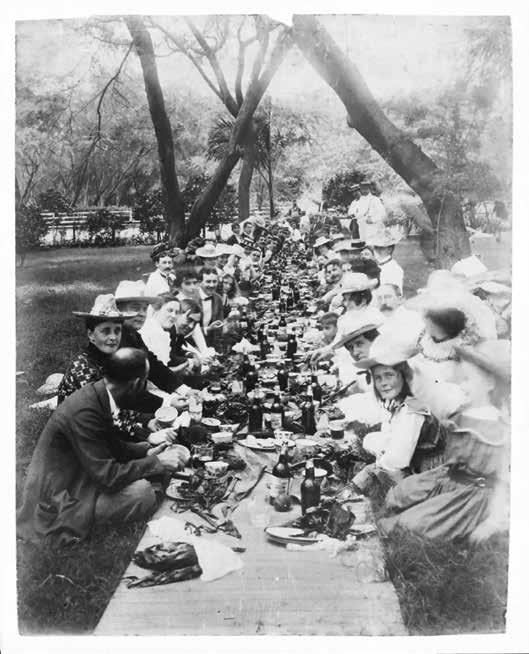
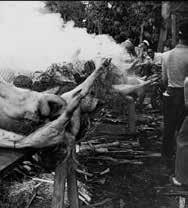

ʻO kāu aku, ʻo kā ia ala mai, pēlā ka nohona o ka ʻohana.
From you and from him—so lived the family.
— Mary Kawena Pukui, ‘ Ō lelo No‘eau: Hawaiian Proverbs & Poetical Sayings





THE RISE OF LUXURY LINERS: A TOURISTS’ FIRST TASTE OF THE ISLANDS
Spring, 1953. When Los Angeles resident Rose Yampolsky boarded the S.S. Lurline bound for the Hawaiian Islands, the cruise staff provided guests with their first taste of Hawaiʻi: a celebratory “Poi Cocktail,” which blended Hawaiʻi’s beloved purple taro paste with cream and a shot of bourbon. For Yampolsky, the indulgence technically fell under doctor’s orders. Recently widowed, she had been encouraged by her psychologist “to go out, get out and do something,” grandson David Dichner recalls. So the plucky 55-year-old sought out new adventures, booking a cruise across the Pacific Ocean. “It was the glamorous thing to do back then,” Dichner says. “Hawaiʻi was exotic and faraway and that’s where everybody was going.”
It was post-World War II posterity that bolstered a surge in American travel overseas. Mesmerized by advertisements featuring swaying palms, white-sand beaches, and tropical seaside lūʻau, a robust influx of tourists arrived upon Hawaiian shores, eager to experience all things Polynesia—food included. Cruise ships served as the fulcrum of Hawaiʻi’s tourism, disembarking and boarding nearly 700 passengers via Pier 11 at Honolulu Harbor each week. The Matson Lines’ S.S. Lurline , along with her sister ships the S.S. Malolo , S.S. Mariposa , and S.S. Monterey —collectively known as the “White Ships”—glittered as the four crown jewels of its fleet of luxury ocean liners. Providing a first-class-only transit service between California and Hawaiʻi, the ships gained prestige for their glamorous accommodations and amenities. By capitalizing on the allure of paradise, these cruises proved instrumental in establishing Hawaiʻi as a world-class destination. In 1955, tourist arrivals numbered 109,798. Within two decades, the arrival numbers had swelled well into the millions.
The S.S. Lurline ’s luxuriousness was legendary in attracting hoi polloi and celebrities alike. John Wayne and Clark Gable were special guests, as were Shirley Temple and Elvis Presley. The weeklong crossing allowed for shuffleboard and movie screenings, trap shooting and tennis. When not reclining in their air-conditioned three-room “lanai suites,” guests could swim in a seawater pool or indulge in champagne parties and midnight buffets. Dining was an extravagant affair, offering a preliminary if not downright regal taste of the islands: opakapaka meunière with buttered cucumbers, clear turtle soup with Amontillado sherry, fresh frosted pineapple au crème de menthe. Even the menus that announced such dishes were posh, graced with vivid murals by artists like Eugene Savage that captured the gaiety of tropical island culture, as commissioned by Matson Lines.
These meals were merely appetizers before the overall travel experience. Upon arrival in Honolulu, guests received a jovial welcome. Outrigger canoes sidled up to the ship, shouting warm greetings. Thousands of fragrant lei were bestowed upon the debarking travelers. Along the crowded dock, women danced hula and musical groups sang “hapa haole” music to the tune of ʻukulele and steel guitar. For guests of the S.S. Lurline , their Hawai‘i adventures were about to begin.
— R.S.
92 | FLUXHAWAII.COM

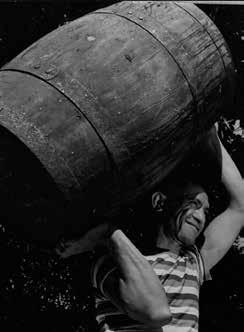
 � The gardens at Ho‘oulu ‘Ā ina, Kalihi. Image by Meagan Suzuki.
� The gardens at Ho‘oulu ‘Ā ina, Kalihi. Image by Meagan Suzuki.

SPECIAL SECTION: 14 FOODS
“Maybe in the cyclone of today’s intense state of world affairs, I’m just loving the way food makes us lean so generously into each other lately.” —Matthew Dekneef

14 Foods That Tell Us Where Hawai‘i Cuisine is Going 1 Local Poultry by Lisa Yamada-Son 2 Jackfruit by Jennifer Hee 3 ‘Ulu by Mark Noguchi 4 Homegrown Greens by Noe Tanigawa 5 Edible Weeds by Gaye Chan 6 Slow Fast Food by Kevin Yim 7 Overlooked Comforts by Guy Hagi 8 Wild-Harvested Eland by Jason Peel 9 Pipikaula Loco Moco by Dean Okimoto 10 Crowdsourced Cocktails by Dusty Grable 11 Imu by Shannon Wianecki 12 Elevated Chinese by Will Chen 13 Cheung Fun by Martha Cheng 14 Community Feasts by Matthew Dekneef
In 2018, the nature of food— its origins, its production, its presentation—is at the center of our conversations about what we eat.
For this feature, we’ve compiled a diverse cross-section of voices, from chefs and farmers to writers and educators, to gain a range of perspectives on where Hawaiʻi’s culinary zeitgeist is today, where it’s going, and what more it needs. If there’s a trend that arises based on this group’s reactions, it’s beyond the next fusion-flavor profile or Instagram-ready dessert—it’s that in Hawaiʻi people are taking ownership of what they place on their plates at an exciting and accelerating rate.
Lisa Yamada-Son FLUX Hawaii editor
Poultry is treated as an obligatory menu item,
regularly listed beneath its more ostentatious cousins of beef and fish. But this often-overlooked protein may just be what helps make us a more food-secure state. I’m not talking about those spongy filets that come from factory farms on the mainland, where thousands of birds are processed daily, frozen, and then flown across the ocean to our island shores. Instead, I’m talking about the kind that come from chickens that live out their lives in the fields of Waialua, that graze on the grasses beneath their feet, that are individually processed—by hand—in the shade of the Ko‘olau Range, and delivered direct to restaurants around O‘ahu within 24 hours. I’m talking about the chicken from J. Ludovico Farm.
I first had a J. Ludovico bird at The Pig and the Lady, where it was poached lightly and served as the star of the restaurant’s Hainan chicken dish. Next was at Yakitori Hachibei, where I took down skewer after skewer of succulent grilled breast, liver, and wing. Delicate and clean, the meat was unlike any other chicken I’ve tasted. This chicken, I soon discovered, was the product of Julius Ludovico, one of only three purveyors who raise locally grown, free-range chicken for meat in Hawai‘i, and the sole one doing so on O‘ahu (the others are on Hawai‘i Island). Rain or shine, seven days a week, Julius and his wife, Jamie, rise at 5:30 a.m. to schlep the more than 60 chicken pens— each shaded coop holding about two dozen fully grown
chickens—across their Waialua acreage. The pens must be moved onto new patches of grass daily. Julius must also tend to and feed the chickens daily, or risk them turning on themselves and eating each other. He shepherds them, protects them from the elements, and guards them from mongoose, pigs, and wild dogs. Then, twice a week, Julius and a team of four other workers, including his wife and sister, round up the birds that are six to eight weeks old, sever the arteries in their necks, and package them for same-day delivery. In total, J. Ludovico Farm produces between 600 to 1,000 pounds of poultry meat a week. It is dirty work. But it is work that feeds our community.
We’ve all heard the statistics: how we import 90 percent of our food; how most of the agricultural land in production in Hawai‘i is used to grow exports like seed, feed, and other ornamentals; how much of the beef raised in the islands is shipped to the mainland to be finished and consumed elsewhere (or packaged and sold back to us). But what if we ate more chicken? Sure, $6 a pound for local poultry is steep when compared to the $3 for Foster Farms, but consider that local beef will run you anywhere from $8 a pound for sirloin to nearly $25 a pound for tenderloin, or that ‘ahi could set you back as much as $30 a pound. Try the twice-fried chicken at Fête and see if it’s worth it. Ultimately, to support farmers like Julius is to invest in Hawai‘i’s future.
98 | FLUXHAWAII.COM ONE: LOCAL POULTRY
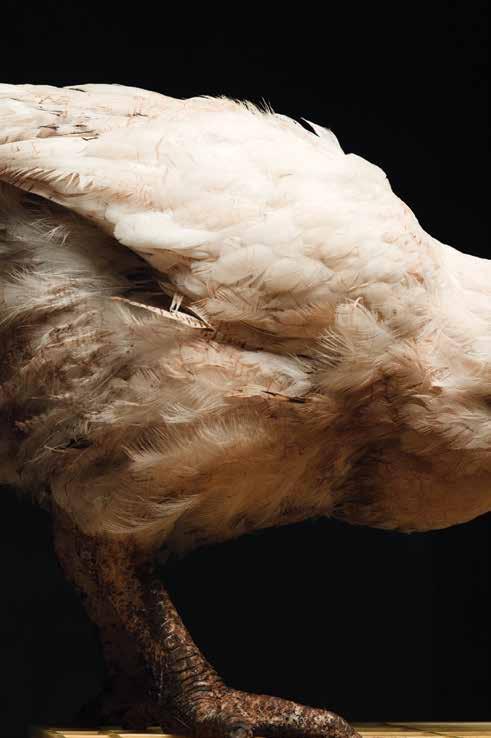
“I know these birds intimately, however crazy that sounds,” says Julius Ludovico of J. Ludovico Farm. “From hours-old to harvest time to slaughter, I know what they’ve gone through. I don’t want to say there’s a dread, but there’s always that knot in my stomach. But honestly, I’m never used to it.” ”
Images by John Hook.
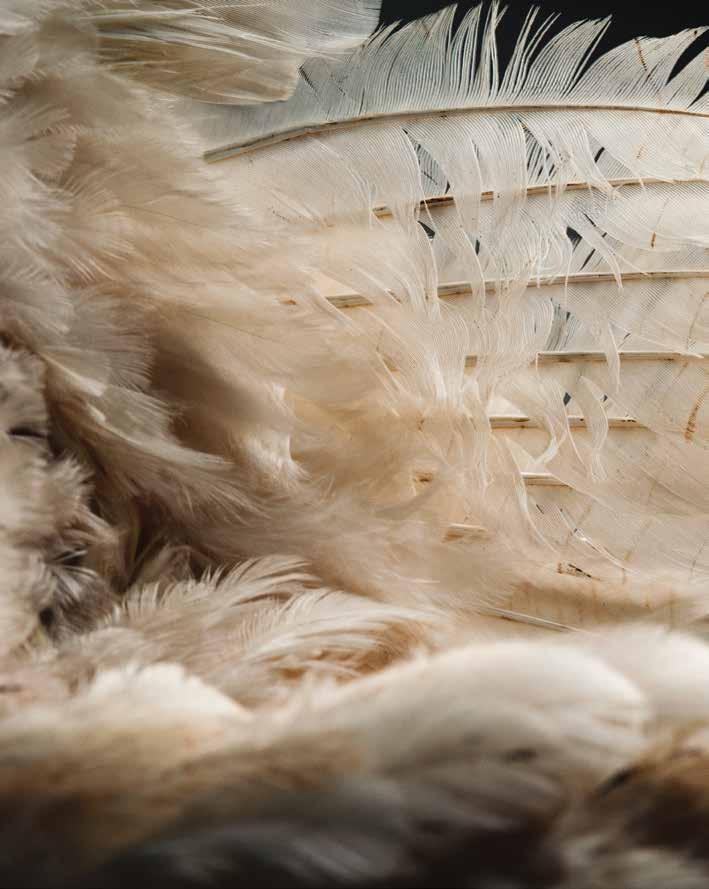
100 | FLUXHAWAII.COM


101

“Chickens taste good because they have less stress. We’re not doing anything different per say. It’s still relatively the same as everybody else, but I think the stress level is significantly lower.”
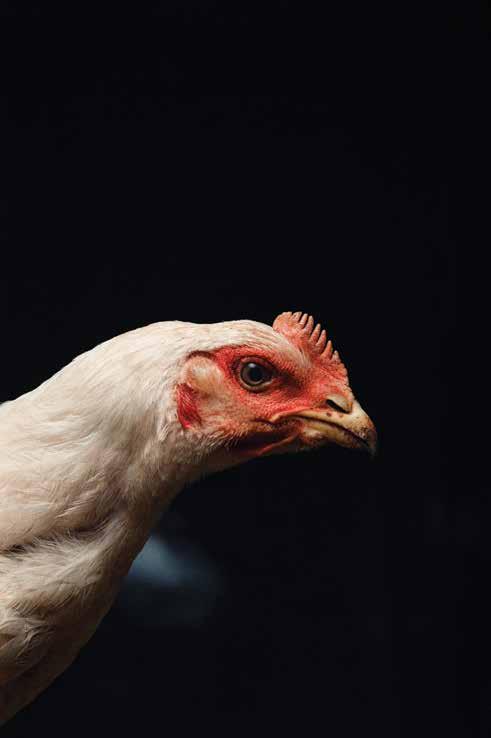
“I’ve gone through so many emotions doing this. When it rains, it gives me anxiety. Back in March, we lost over 300 hundred birds because of the rain. It was very unusual, the direction. It came down from the mountains, and it just went sideways and got all the chicks wet. I was literally blow-drying chickens, seriously.”
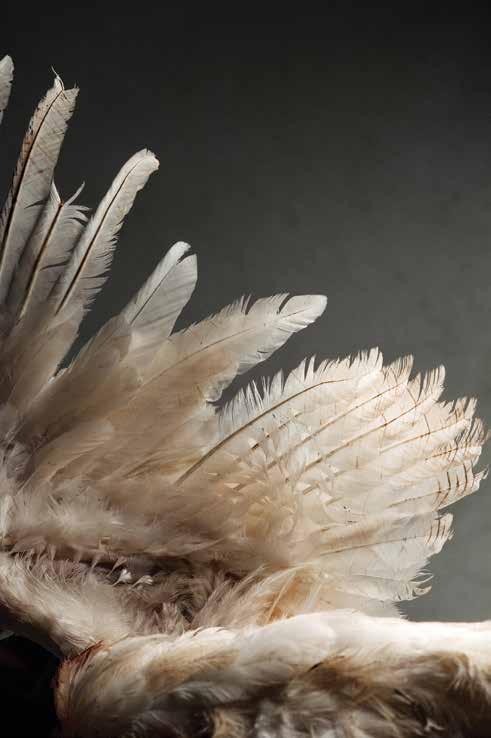
“This one guy called me out of the blue, said that he’s opening a restaurant on Wai‘alae, a yakitori place. I gave him a chicken. He went home, ate it raw—in Japan they do that. He ate it raw, fed it to his kid raw, and they’re all good. The kicker was, he put it back in the fridge, waited a week and ate it again, raw. Fed it to his kid too, and he said, it’s good, I didn’t get sick. And I’m like, brah.”

“This side of the island [North Shore] can provide all the vegetables that O‘ahu would need. But most of these farmers, they export products. People say we need more farmers. Like, no, that’s BS. We need more educated consumers to demand local products.”

106 | FLUXHAWAII.COM

107
Jennifer Hee
Juicy Brew chef
I first tasted jackfruit years ago in Sri Lanka,
where I was amazed by jackfruit trees and their enormous, spiked fruits that dangled from improbably small stems. Never did I imagine that one day I would be harvesting jackfruit from a friend’s backyard in Mānoa, standing atop a ladder armed with a serrated knife duct-taped to a telescoping tent pole and a bit of old-fashioned girl power. We’ve been fortunate to have an abundant source of jackfruit to experiment with at Juicy Brew, the café where I cook. Some jackfruit dishes we’ve made include laulau with kiawe-smoked jackfruit, jackfruit tacos and burritos, jackfruit jambalaya, barbecue jackfruit sandwiches, jackfruit bulgogi for Korean-style dishes, jackfruit manapua and bao, jackfruit “crab cakes,” jackfruit “tuna” casserole, and jackfruit pithivier. All our cooks undergo jackfruit processing as part of their kitchen initiations. It is a tedious and unpleasant task to break down this sticky, dripping fruit that often weighs more than 70 pounds. It requires oiling prep tables, cutting boards, and knives, and, for the prudent chef, donning a full-coverage Hazmat suit.
More than once, I’ve heard people say they have learned about jackfruit as a meat substitute, and have attempted to cook a savory dish with it, only to find it tasted sweet and disgusting. Friends, strangers, fellow chefs, in order to make a savory jackfruit dish, the jackfruit must be completely unripe. The arils and their surrounding fibrous bits should be the same whitish color. The only inedible parts of an unripe jackfruit are the outermost layer of skin, the core, and, depending on the stage of ripeness, the seed casing. (The seeds are great roasted in oil, garlic, salt, and Sriracha. They can even be ground into flour or made into ‘inamona, if you have the monk-level patience to peel them.) While it is not local, canned jackfruit is a great, incredibly easy alternative to its fresh counterpart, and it can be found at many Asian markets and Kokua Market.
Ripe or unripe, jackfruit is an incredibly versatile and locally available fruit that will hopefully find its way into the trends and kitchens of Hawai‘i’s many talented chefs this year.
108 | FLUXHAWAII.COM TWO: JACKFRUIT
 Illustration by Lauren Trangmar.
Mark “ Gooch ” Noguchi Chef and co-founder of Pili Group
Illustration by Lauren Trangmar.
Mark “ Gooch ” Noguchi Chef and co-founder of Pili Group
Artocarpus altilis
finally has its time.
If you wander through the aisles of your local market, you might hear ʻulu, or breadfruit, mentioned. At our local farmers markets, I often overhear people discussing ‘ulu, whether before purchasing it, or talking about the tree they just planted. That wasn’t the case five years ago in Hawai‘i. Thanks to a group of Native Hawaiian practitioners, ʻulu (along with kalo and paʻi ʻai) has become a household staple. Steamed, fried, baked, stewed, pureed, smoked, or fermented—ʻulu is once again a staple in the islands. If you’re in Hāna, Maui, stop by Kahanu Garden to see the largest collection of ‘ulu specimens in the world. A longliving and long-fruiting tree, ‘ulu is considered one of our future crops to watch because its smaller carbon footprint makes it one of the most sustainable starches to grow. ʻUlu is found throughout ‘ōlelo noʻeau (Hawaiian proverbs). My favorite is this one: “ʻAʻohe ʻulu e loaʻa i ka pōkole o ka lou.” No breadfruit can be reached when the picking stick is too short. There is no success without preparation.
110 | FLUXHAWAII.COM THREE: ‘ULU
Noe Tanigawa
Hawai‘i Public Radio arts and culture reporter, artist
It started with bunches of lemon basil alongside our plates in Iran—
it turns out chewing citrusy minty leaves really perks up a meal. But guess what? I found out I can grow sparkly tasting lemon basil right here in Hawai‘i, next to pots of marjoram, thyme, oregano, mint, tarragon, and sage. This year my mesclun took off. Fresh-snipped butter lettuce, mizuna, tatsoi, frisée, and arugula are crisp but tender, and super tasty. Toss ’em with handfuls of herb leaves including lemon basil, no need salad dressing! Revelation. Eat with chopsticks. All killah, no fillah.
This is where Hawai’i food has been heading, to the exaltation of individual flavors. We can do it because food grown here actually tastes better. I had a leaf and root
salad this year that made me look differently at “weeds” along the road. Amplifying flavors is part of it too, by aging, reducing, drying (then roasting!), salting, pickling, and fermenting.
Wanna play? Do something like what I planned out for a month: Put down two layers of blackout cloth to keep weeds away. Top that with four cedar slats in a square, fill with organic soil. A small pot on a window sill is fine, too. Start with arugula. Tuck the seeds not too deep in the dirt, drizzle with water every morning, and four days later, you’re in business. Pluck the leaves when they look toothsome, in about a month, and enjoy.
111 FOUR: HOMEGROWN GREENS
Gaye Chan
Chair of the Department of Art and Art History at the University of Hawai‘i at M ā noa, artist, food activist
Driven by war, violence, and climate change, people are moving across the globe more than ever before.
Simultaneously, there is escalating nationalism, racism, and growing hostilities toward those who are deemed to not belong. In Hawai‘i, the phrase “invasive species” is increasingly used to describe everything not native, regardless of what the living beings actually do within the ecosystem.
My WE(ED)S project began in this nexus. It started with research, followed by letting edible weeds grow in our yard. Weeds are now a standard fare in our meals. Our favorites are ivy gourd shoots and amaranth, stir fried, added to soup, scrambled with eggs over rice. My mom adds them to her morning oatmeal.
Foraging and eating weeds has been life changing. I have gotten several neighbors to stop spraying chemical herbicides. There are far fewer insect problems in my garden, and I never have to do emergency runs to the market for lack of vegetables. To share this knowledge, I have been also doing cooking demonstrations and tastings of edible weeds for more than a year. The next time you are thinking of tossing that handful of weeds in the trash, try this recipe instead:
Stir-Fry Ivy Gourd Shoots with Mushroom
Ingredients:
1 bunch ivy gourd*
1 tablespoon fish sauce or light soy sauce
2 tablespoons cooking oil
1 box Hamakua mushrooms
2 cloves crushed garlic
*Use only the new growth on the vine, which breaks off easily when pinched.
Instructions:
Add oil and crushed garlic to pan over medium-high heat until garlic turns golden brown. Add fish sauce or soy sauce and cook for 1 minute. Add ivy gourd and stir for about 2 minutes or until ivy gourd is coated with sauce. Add mushrooms and cook for 1 minute. Serve over rice.
For more such recipes, nomoola.com.
112 | FLUXHAWAII.COM
EDIBLE WEEDS
FIVE:
 Illustration by Lauren Trangmar.
Kevin Yim Zippy ’s Restaurants vice-president of marketing
Illustration by Lauren Trangmar.
Kevin Yim Zippy ’s Restaurants vice-president of marketing
Think locally grown, and you might conjure images of a small artisanal restaurant with a fussy executive chef and a hip, young waitstaff.
But the dish that made me excited recently was one from someplace that is completely unlike that image: the Zippy’s Korean chicken salad, available at the dinein section of the restaurants. A new employee of the company, I found this hidden gem tucked away near the back of the menu. Made with leafy greens from Kunia Country Farms, this salad, atypical of what is usually served by large restaurant chains, supports a sustainable aquaponics operation that is land, water, and energy efficient. However, it is a challenge for one farm to supply enough leafy greens to support the 22 Zippy’s restaurant locations on O‘ahu, and already, Zippy’s needs more produce like this. Additionally, Hawai‘i’s
public school system recently launched its own “Farm to School” initiative, and other large food-service providers are beginning to embrace sustainable food sourcing strategies. That being said, demand needs to grow even more. More restaurants and food-service operations need to insist on buying locally whenever viable. This would allow the economics of supply-side production to provide greater monetary rewards for farmers, leading to greater investment in sustainable farming technology, and, ultimately, more production. It looks like 2018 might be the year that demand, and supply, will expand, meaning a more sustainable, food-secure future for all of Hawai‘i.
114 | FLUXHAWAII.COM SIX: SLOW FAST FOOD
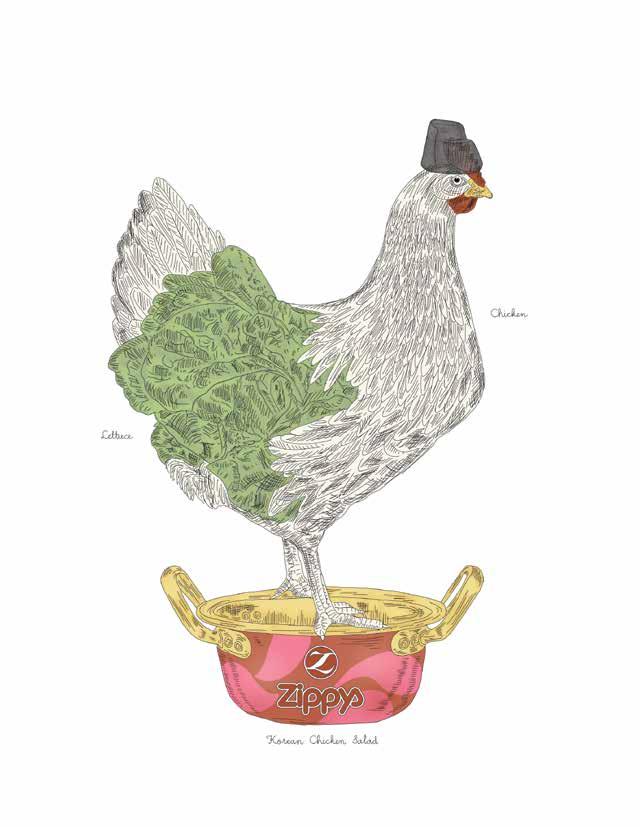 Illustration by Lauren Trangmar.
Illustration by Lauren Trangmar.
 Illustration by Lauren Trangmar.
Guy Hagi
Illustration by Lauren Trangmar.
Guy Hagi
There are a handful of
comfort foods I
’ ve been turning
to of late.
Pho is always a top one for me, but its lesser-known cousin is having a moment. Bo kho , or Vietnamese beef stew, looks like its Western beef stew counterpart except for the glossy, bright-orange spots of oil that glisten atop its brownish-red tomato broth. That slightly spicy sheen is thanks to annatto seeds, which are added to the oil used to brown the beef. Other than this fluorescent telltale, the other way bo kho differs visually from run-of-the-mill beef stew is an absence of potatoes. Instead, the Vietnamese stew has only onions and carrots swimming with the tender chunks of beef.
What makes bo kho a favorite of mine is the laundry list of humble Asian ingredients, common to most restaurants in Chinatown, that are added in the cooking process.
The fish sauce-marinated beef, braised for a couple of hours, is fork tender. The tomato broth is enriched with ginger, lemongrass, Chinese allspice, and star anise, which blend together to make a slightly tangy, semi-thick soup.
You can find bo kho in most Vietnamese restaurants, where it is usually served with rice noodles or French bread. Being local, I always opt for rice. If you like to cook, bo kho is not a complicated dish to prepare, though the more exotic ingredients might necessitate a visit to an Asian market.
117 SEVEN: OVERLOOKED COMFORTS
Hawaii News Now weather anchor
Jason Peel
Executive chef of Eating House 1849 at International Market Place
As residents of isolated islands in the Pacific,
it is important to use the product that is available to us. Wild-harvested eland (a type of antelope) is a delicious and lean meat, and sustainable in every way. The animals roam in abundance on the island of Ni‘ihau, and their meat is lower in cholesterol than beef. I like to make a tasty tartar out of eland. Consumers can now purchase this meat directly from Ni‘ihau Ranch, which began processing and selling eland in 2015. Harvesting and preparing the meat is one thing. Educating the consumer is another. It is important to continue raising awareness of what we have available to us in Hawai‘i, like this meat that is raised in the wild—what I call “happy meat.”
NINE: PIPIKAULA LOCO MOCO
Dean Okimoto
Hawaii Farm Bureau Federation president
I had what may be the best loco moco in
town.
It was from the Row Bar by Tamura’s and made almost completely with local ingredients. The patty was made from pipikaula (dried salted beef) and ground Hawai‘i Island beef, with a hint of locally grown jalapeño. Of course, it was topped off with over-easy eggs, also local. This interesting dish had a hint of spice to it and was very savory. I think the general public is becoming increasingly aware that sourcing and eating locally is good for everyone in the region. Adapting a lot of ethnic cuisines to use locally sourced foods or local cooking methods is becoming more top of mind, which will make for some interesting cuisine going forward.
118 | FLUXHAWAII.COM
WILD HARVESTED ELAND
EIGHT:
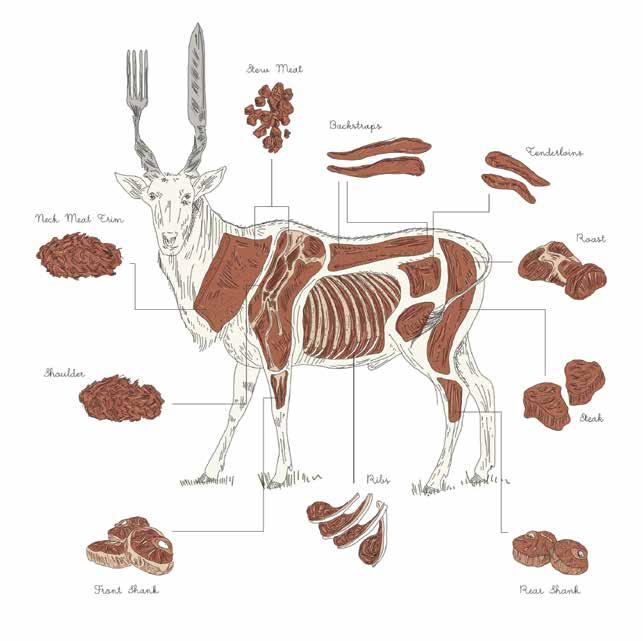 Illustration by Lauren Trangmar.
Illustration by Lauren Trangmar.
 Illustration by Lauren Trangmar.
Illustration by Lauren Trangmar.
Dusty Grable
Stage Restaurant general manager
When I think about what excites me about the future of Hawai‘i ’s hospitality, food, and beverage industry,
I think of our passion-driven, inspired, and hard-working innovators. What’s even more exciting, though, is the idea of these minds coming together to elevate the culinary landscape. This sense of collaboration was captured beautifully in a drink served to me by Alicia Yamachika, the new lead bartender at Azure Restaurant at the Royal Hawaiian. Aside from its delicious flavor and beautiful presentation, what made this drink so captivating is the fact that many hands—from chefs to bartenders to farmers—helped to shape it.
The drink, O Ka Honua (meaning “of the Earth”), is an amazing libation inspired by the classic Bloody Mary. It is made with KōHana Kea, an incredibly aromatic white agricole rum distilled from fresh indigenous sugarcane juice grown onsite by Manulele Distillers in Kunia, on
O‘ahu. The rum is combined with beet juice, liliko‘i, ginger juice, maple syrup, and balsamic vinegar. The contents are shaken over ice, and then Ho Farms tomato water made by Azure’s chef, Shaymus Alwin, is stirred in. The glass is elegantly half-rimmed with beet powder, alaea sea salt, and shichimi. Finally, the drink is garnished with Hirabara Farms watermelon radish, Mari’s Garden micro shiso, and a Ho Farms grape tomato. It is almost too beautiful to drink.
The complementing flavors and aromatics are endless. Grassy notes from the rum shine through the deep earthy flavors of the beet. The ginger adds gentle spice, while the liliko‘i and balsamic bring a sweet, tart layer. Finally, the tomato water provides the backbone for everything to build on. Delicious.
121 TEN: CROWDSOURCED COCKTAILS
Shannon Wianecki Travel writer
My culinary revelation wasn’t an ingredient or a dish. It was a method.
I built my very first imu (underground oven) last year. Growing up in Hawaiʻi, I ate countless kālua dishes pulled from steaming pits at holiday parties and lū‘au, but I had never loaded or tended an imu myself until about a year ago. I now think it’s a superior cooking style, even though it takes a full day, or longer. Some imu-savvy friends coached me. We filled a fire pit with porous lava rocks, heated them red-hot, and covered them with mashed banana-trunk fiber. We piled on the food and sealed the bounty tight beneath tī leaves, wet burlap sacks, and tarps. We swam while our feast cooked.
Before this hands-on introduction, I had always associated kālua with smoke. In fact, it is steam—and pressure—that cooks the food over many hours. The resulting fare is super juicy and tender, with tantalizing hints of smoke, banana, and tī leaf. While whole pigs or turkeys are standard imu contents, I experimented with a cornucopia of ingredients: whole pumpkins, breadfruits,
sweet potatoes, parrotfish wrapped in pohole fern, and ‘ōpae ‘ula (freshwater shrimp). Imu-baked bananas and beets proved particularly delicious.
I’ve since noticed more and more people building imu in their backyards. Maybe I’m just attuned to them now, or maybe it’s a growing trend. I hope for the latter. Kālua is a relatively sustainable cooking technique. Underground ovens make maximum use of resources and can be relied on during power outages. They’re also healthy, lacking the carcinogenic elements of barbecuing or pan-frying. Best of all: The communal effort of building an imu brings people together.
In days past, Hawaiian women tended underwater gardens, and packed their favorite sea vegetables into the imu. Those wāhine were akamai and knew which limu would dissolve into savory jellies and gravy. That’s nextlevel imu cuisine, and I’m ready for it.
122 | FLUXHAWAII.COM ELEVEN: IMU
Will Chen
When I moved here over a decade ago, there weren’t many regional Chinese restaurants. And that boggled me.
The majority were Cantonese restaurants, followed by a handful of hybrid northern Chinese-Korean spots, which is still a little alien to me. I wasn’t sure if it was because there wasn’t enough of a population to produce the food or that it was tried and wasn’t well received by the Hawai‘i palate. China is huge, with each region having distinct flavor profiles and cooking styles. Considering the country’s proximity to Hawaiʻi: How come so many weren’t being represented?
But a change seems to be amongst us. When the Taiwanese franchise Little Sheep opened a few years ago, I couldn’t believe the amount of Chinese people that not only
worked there but came to dine. And then last year Chengdu Taste, which took over a previous Sichuan-style restaurant. It is busy almost every night of the week. After that came Spicy Pavilion in the Chinese Cultural Plaza, a Sichuan restaurant that has a strong following. And, of course, the most hyped about was Yauatcha, an elevated yum cha experience with European flair. This all gives me hope.
Clearly we are ready for more. Can Honolulu’s own Din Tai Fung be far behind? What about an authentic handpulled noodle shop or dumpling house? Exciting times are surely ahead.
123 TWELVE: ELEVATED CHINESE
Fresh Box
culinary director

124 | FLUXHAWAII.COM

 Images by Meagan Suzuki. Yauatcha at International Market Place.
Images by Meagan Suzuki. Yauatcha at International Market Place.
THIRTEEN: CHEUNG
Martha Cheng
Food writer and author of The Poke Cookbook: The Freshest Way to Eat Fish
Maybe it’s wishful thinking, but to me, this prawn
and crispy bean curd cheung fun is a sign of food to come in Hawai‘i.
Served at Yauatcha Waikīkī, it’s a refined version of what I grew up eating at dim sum in California’s Bay Area: steamed rice-flour sheets wrapped around youtiao, fried dough sticks. Yauatcha’s take swaps the youtiao for thin, pressed bean curd, fried to brittleness and stuffed with minced prawn and mushroom. The result is a layering of textures—slippery and soft, crisp and crunchy. It illustrates that Chinese food can be delicate, refined, and subtle, which are not the adjectives that characterize most of the menus at Chinese restaurants in Honolulu. But I think that’s about to change. The influx of Chinese nationals and tourists will help elevate and diversify Chinese food options in Honolulu, following a similar track as Japanese cuisine, which has grown from the
fare of the plantation era, of okazuya and Okinawan homestyle cooking, to include rarefied sushi and straightfrom-Japan chains specializing in tonkatsu and tempura. There’s so much more to Chinese food than our current restaurants would have us believe. Its diversity ranges from Sichuan’s cumin lamb to Xi’an’s meat pies to a refinement exemplified by Hong Kong dim sum palaces and Shanghai seafood destinations. Already, Chengdu Taste, which focuses on the fiery flavors of Sichuan fare, is in Honolulu. Chefs are also incorporating more Chinese touches into their creations, like Kevin Lee’s take on dim sum and black bean spareribs at Pai. These are the tastes of a more global and interconnected Hawai‘i just beginning to delve into one of the world’s greatest cuisines.
126 | FLUXHAWAII.COM
FUN


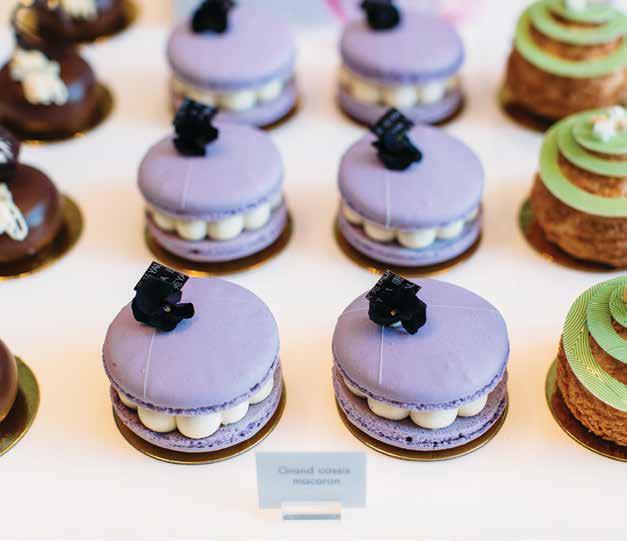
127

128 | FLUXHAWAII.COM

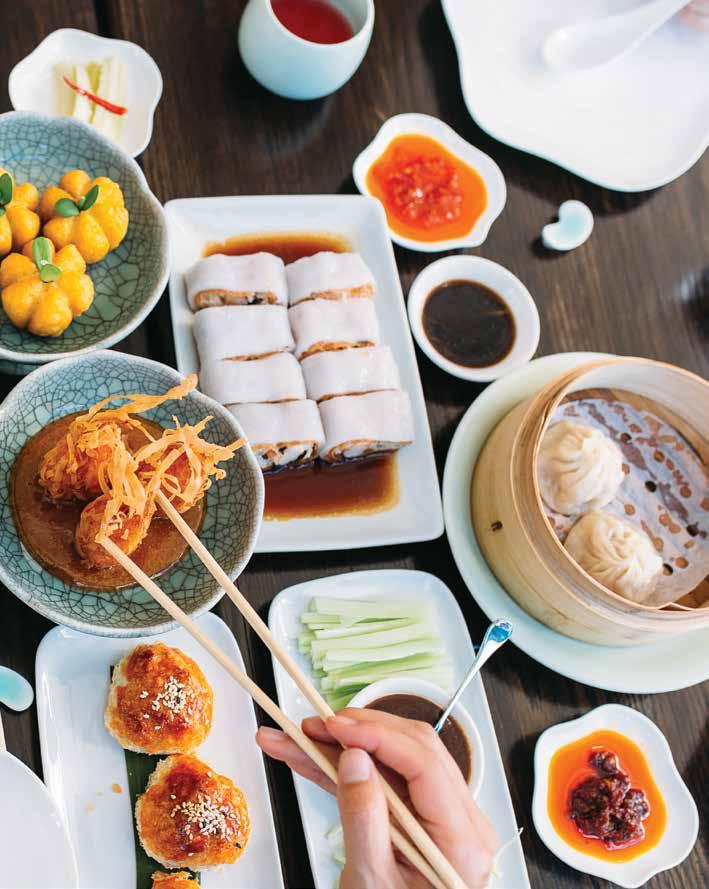
129
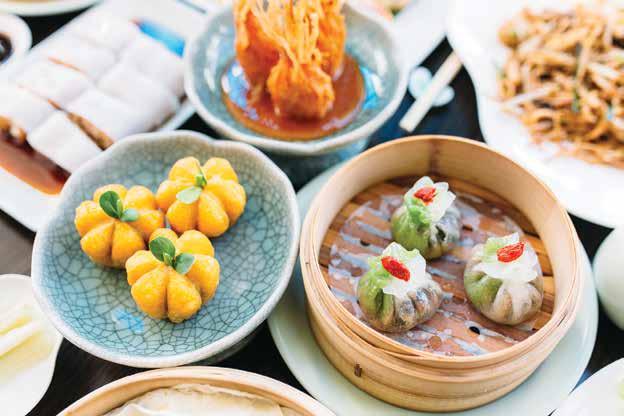
130 | FLUXHAWAII.COM

131
Matthew Dekneef
FLUX Hawaii managing editor
Excuse me, I don’t mean to interrupt... I just wanted to chime in and say that I truly believe where there is a good meal, there is a lively conversation.
Or there should be, anyway—the type of chit-chat that builds onto itself with diners who finish each other’s sentences, a whisper that simmers then erupts into farflung laughter, a coda of sounds that come together like the ingredients of a warm, well-worn recipe.
My most memorable dining-out experiences lately have been the ones textured by this sort of melodious discourse. Often, it makes the meal, and Hawai‘i’s best restaurants have found the most natural of ways to nudge our dialogues along with more family-style eating options.
I’m thinking of Mahina and Sun’s and its simply named Mahina’s Family Feast, where the only way to get a serving of its mochiko-dusted, deep-fried whole snapper is to lift
your voice and make it known (“Hey, can pass that plate!”), something you just can’t do when what’s mine is placed in front of me and what’s yours is placed in front of you. Where exclaiming, “You have to try the chili sambal!” over porchetta, fresh roti, sauces, and herbs in The Pig and The Lady’s Primal Feast Special could be enough to spark a charged discussion with a complete stranger sitting opposite you (“So, those Kealohas, huh?”).
Like the best kinds of conversations, both parties have to meet halfway to partake in these types of feasts. Maybe in the cyclone of today’s intense state of world affairs, I’m just loving the way food makes us lean so generously into each other lately. Anyway, you were saying?
132 | FLUXHAWAII.COM FOURTEEN: COMMUNITY FEASTS
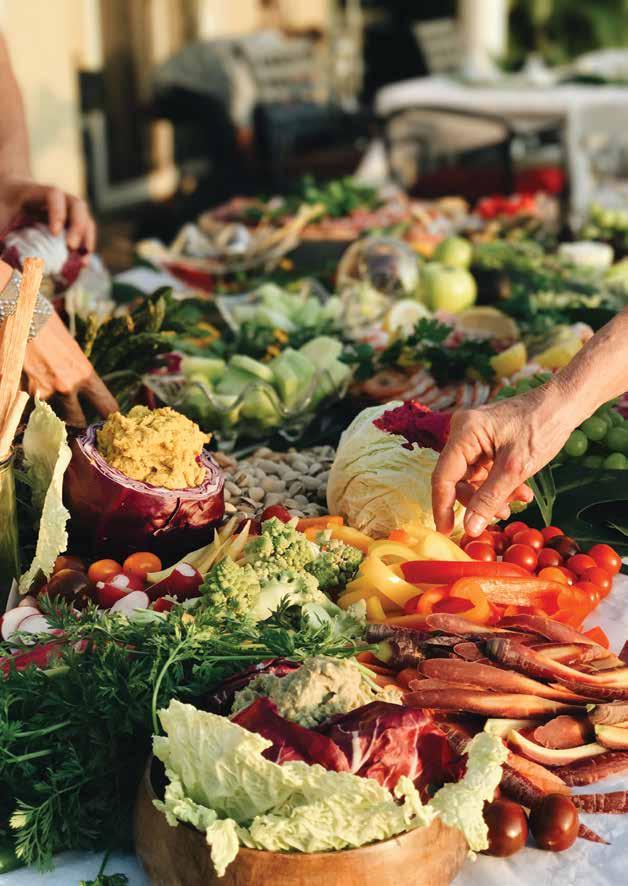 Image by Aja Toscano.
Image by Aja Toscano.

134 | FLUXHAWAII.COM
 Images courtesy of William Sonoma. Mahina’s Family Feast.
Images courtesy of William Sonoma. Mahina’s Family Feast.

136 | FLUXHAWAII.COM

 Image courtesy of Mykle Coyne for Feast Hawaii.
Image courtesy of Mykle Coyne for Feast Hawaii.
 Image by Michael Ni.
Image by Michael Ni.
 Image by Amanda Robson for Feast Hawaii.
Image by Amanda Robson for Feast Hawaii.
 � The La Fonda dining chair by Charles and Ray Eames. Image by John Hook.
� The La Fonda dining chair by Charles and Ray Eames. Image by John Hook.
LIVING WELL
“In a world of Kardashian imagery, swimming has taught me to feel comfortable in my body. To view it as a machine.”—Kim Chambers


The Dining Chair
Jacqueline Davey rounds up some of her favorite dining chairs.
COMPILED BY LISA YAMADA-SON
IMAGES BY JOHN HOOK

Though she studied design at Emily Carr University of Art and Design in Vancouver, Honolulu resident Jacqueline Davey has always been fond of architecture and furniture.
“I love the ritual of sitting down and sharing food with someone, although I rarely make time for it myself, so I wanted to focus on chairs for such occasions.” Here, Davey rounds up some of her favorite chairs and how they can bring a unique element to an eating experience.
THE LIS
This rosewood chair, dubbed the “Lis,” was designed in the 1960s by Niels Koefoed for Koefoed Hornslet. A unique detail to note is how the armrests extend down and actually wrap around the cross spindle. “I love this chair because its organic shape seems to reference the Art Nouveau movement popular through the early 1900s, although it was designed and manufactured in the 1960s.
“This chair would be suitable in a formal dining setting or anywhere you may want a sculptural chair to accent other furniture.” Available from Hawai‘i Modern, whose showroom is located at 527 Cummins St.
142 | FLUXHAWAII.COM
LIVING WELL | INTERIORS |
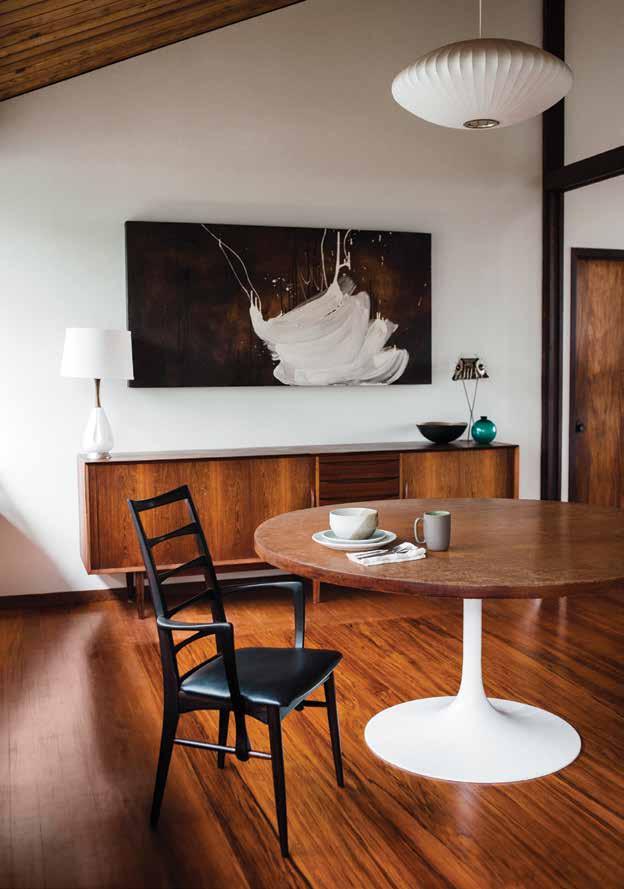
143
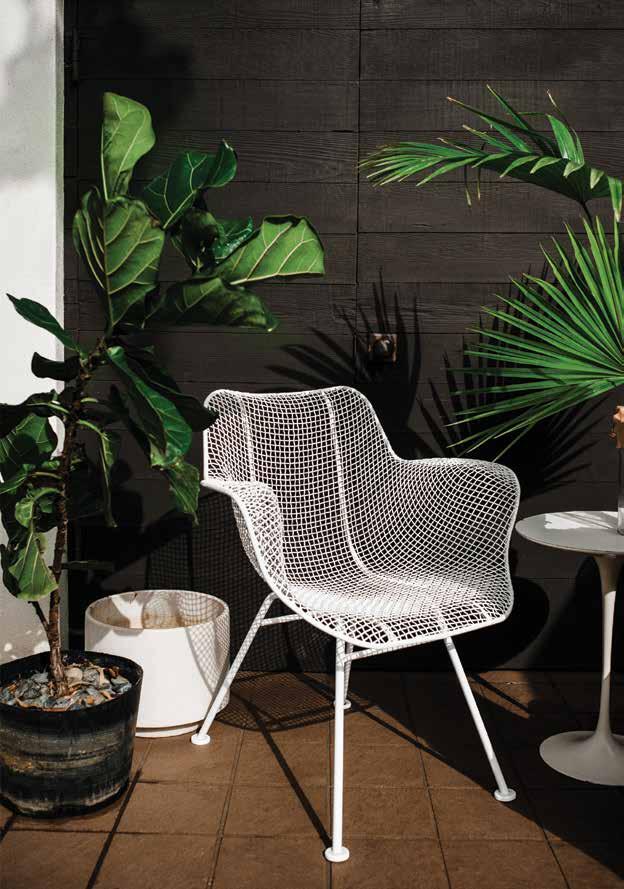
144 | FLUXHAWAII.COM

SCULPTURA
Russell Woodard designed this chair in 1956 for Woodard Furniture Co. Its wire framing and curved design is typically found on patios.
“Because these vintage wire chairs are not as ubiquitous as the Bertoia chair, it’s still possible to find them at reasonable prices, and they’re infinitely more comfortable,” Davey
says. In 1994, the Sculptura was added to the Cooper Hewitt, Smithsonian Design Museum’s permanent collection.
145
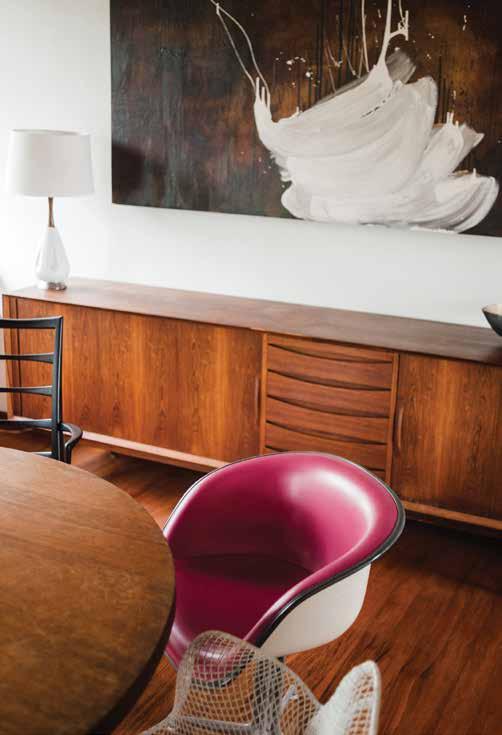
EAMES LA FONDA
“I love the history of this chair,” Davey says. Apparently, it was designed in 1961 in response to a request from a friend of Charles and Ray Eames, Alexander Girard, who needed seating for his new restaurant, La Fonda del Sol, in New York City’s Time-Life Building. He asked for chairs with backs no higher than the dining
table tops. “It’s so easy to say yes to neutrals and shy away from bright colors, but the fuchsia upholstery is really what makes this chair amazing,” Davey says. “You’ll be surprised how complementary the color is, especially when it comes to nature.” Though not for sale, you can find vintage pieces like this through Hawai‘i Modern @ hawaii_modern.
146 | FLUXHAWAII.COM

147

148 | FLUXHAWAII.COM

COMBACK
The Comback, designed by Patricia Urquiola, is a reinterpretation of a classic Windsorstyle chair. Made of durable technopolymer thermoplastic, this chair is even suitable for use on a covered lānai. “This chair comes in a variety of colors, making it a great accent
to any room,” Davey says. “It’s suitable for a dining room, but paired with a comfy cushion it can be used anywhere.” Available from Inspiration Interiors.
149

WALTER LAMB PATIO DINING CHAIRS
“The combination of bronze and flag line, or cording, are well suited to our tropical climate,” Davey says. “Because their origination is rooted in Hawai‘i, so is much of their history.” The story goes that after World War II, Walter Lamb salvaged bronze and copper tubing from naval ships at Pearl Harbor to create his first pieces.
(While this chair is attributed to Walter Lamb,
there is some disagreement as to whether he, or Kipp Stewart, who worked for Lamb while he was in college, originally designed this chair.) “This particular piece came from a now-defunct hotel located on the Gold Coast, on the foothills of Diamond Head, in Waikīkī,” Davey says. “This furniture was everywhere in the ’50s and ’60s, but is becoming scarcer, and consequently, higher priced.”
150 | FLUXHAWAII.COM

151

152 | FLUXHAWAII.COM
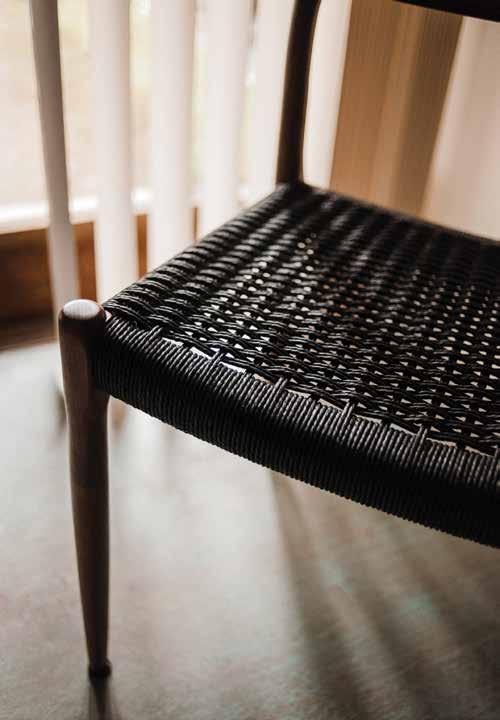
MODEL 79
The model 79 chair was designed and manufactured in the 1960s by Niels Otto Møller for Møllers Møbelfabrik in Denmark and is suitable for a formal dining setting, although its low back makes it a little less formal than the “Lis” chair. “The back has the perfect arch, and the paper cord, as opposed to upholstery, gives it a more handmade feeling,”
Davey says. “Despite its simplistic appearance, this chair is uber comfortable.” Available from Inspiration Interiors.
153
Channel Forward
Kim Chambers has swum some of the world’s deadliest channels. Here, she shares her diet for fueling up.
TEXT BY JEN MURPHY
IMAGES BY KATE WEBBER
Only 55 people have successfully swum across Hawai‘i’s Kaiwi Channel, a 26-mile stretch of water between Moloka‘i and O‘ahu known for its strong currents and large rolling swells. Kim Chambers counts herself among them. In 2012, she spent the night braving choppy waters and nearly 20-mileper-hour winds, until she finally crawled up the lava rock ledges of China Walls after 19-and-a-half hours in the ocean.
What makes her feat even more impressive is that she had only been swimming for three years. The 40-year-old grew up on a sheep farm in New Zealand, and for most of her life, went nowhere near the water. Yet, her Kaiwi crossing marked the start of a journey to
becoming one of the top long-distance, open-water swimmers in the world.
“It’s the uncomfortable, scary moments, like being in dark, rough, sharkfilled waters, that have helped me realize my full potential,” she says.
In 2007, before the Kaiwi Channel, before she spent any amount of hours swimming the moody sea, Chambers was living what she thought was the American dream, with a high-paying tech job in San Francisco and a buzzy social life to match. Then one morning, when she was rushing to work in high heels, she fell down her apartment’s stairs. Blunt-force trauma to her right leg caused a rare condition called acute compartment syndrome, which occurs
� Kim Chambers is among one of only 55 people who have successfully swum across Hawai‘i’s Kaiwi Channel, a 26-mile stretch of water

154 | FLUXHAWAII.COM
|
between Moloka‘i and O‘ahu.
LIVING WELL
HEALTH |


155
when excessive pressure builds up within a muscle. Doctors told her she had a 1 percent chance of ever walking unaided again. “It was the lowest point in my life,” Chambers says.
Two grueling years of physical therapy helped Chambers heal physically, but it wasn’t until she got into a pool for physical therapy in 2009 that she began to heal emotionally. Here, she was able to hide her limited mobility and feel a sense of freedom. “The pool was the beginning of my rebirth,” she says.
Chambers wasn’t a natural at swimming, but her dogged determination caught other swimmers’ attention, and earned her an invite to Dolphin Club, a group of hardcore swimmers who train in chilly San Francisco Bay. In those frigid, dark waters, she found her new path. “I loved being in an environment that humans aren’t supposed to be in, and having that intimate connection with nature,” she says. “I’ve had dolphins swim beside me and the
� In 2007, a fall down her apartment stairs left Chambers with a 1 percent chance of ever walking unaided again.

156 | FLUXHAWAII.COM

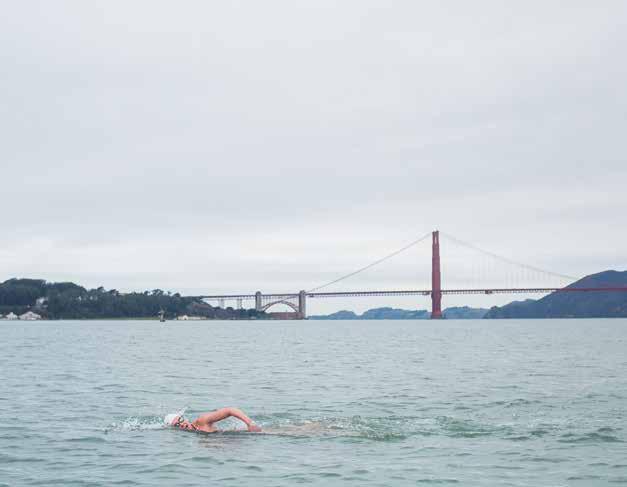
whiskers of sea lions tickle my feet. I was also really drawn to the discipline and focus of long-distance swimming.”
Less than six years later, Chambers became the only woman ever to complete what many consider the hardest swim in the world: the 30-mile span of water between the Golden Gate Bridge and Farallon Islands, a haunting archipelago inhabited by great white sharks. This 17hour adventure was chronicled in the 2017 documentary Kim Swims . She is also one of only seven people to have completed the Ocean’s Seven challenge, an aquatic version of the Seven Summits of mountaineering, which includes open-water swims across the English Channel and the Kaiwi Channel. Every long-distance endeavor raises funds and awareness for a cause, such as San Francisco Baykeeper, a watchdog of water quality.
Recently, Chambers has earned attention for what’s known as “Speedo diplomacy,”
politically sensitive, unprecedented openwater swims meant to spark positive action by governments or leaders around the world. In May 2017, Chambers, along with 11 swimmers from different countries, swam 10 kilometers across the U.S.-Mexico border in an attempt to shine a global spotlight on immigration issues.
Each swim is also, she says, an opportunity for self-discovery. “At the end of a long swim you’re cold and exhausted and you are a completely different person from the one who got in the water,” Chambers says. “In the ocean, you flirt with life and death. I love that anticipation of surrendering myself to the unknown.”
KIM’S DIET
Chambers frequently jokes about the Incredible Hulk moment she had at Adobe, where she works on the sustainability and social impact team. “I was fixing my hair
Less than six years after her accident, Chambers became the only woman ever to complete what many consider the hardest swim in the world: the 30mile span of water between the Golden Gate Bridge and Farallon Islands.
158 | FLUXHAWAII.COM
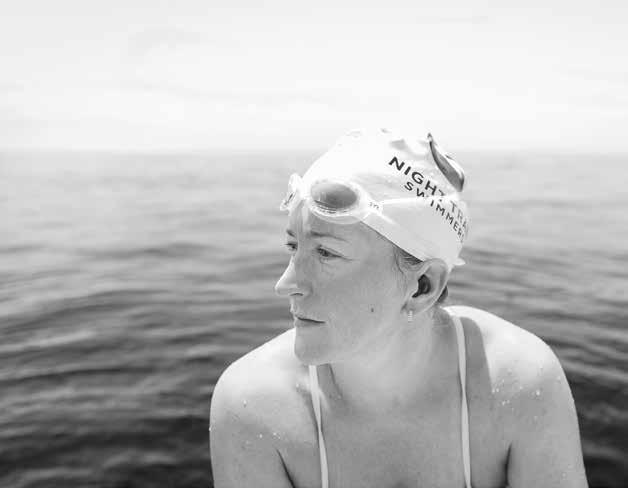
in the mirror, and the armpit seam of my shirt ripped,” she says. “I should have been embarrassed, but instead I felt a sense of pride.” Chambers swims by English Channel rules, which means she doesn’t wear a wetsuit for her swims. Instead, to prepare for the North Channel swim between Ireland and Scotland, the former ballerina gained 65 pounds. She now keeps a wardrobe just for training. “In a world of Kardashian imagery, swimming has taught me to feel comfortable in my body,” she says. “To view it as a machine.”
Post-workout breakfast: “My colleagues at Adobe have gotten used to seeing me devour a breakfast burrito in the cafeteria, and then go back up for pancakes.”
Favorite food for bulking up: “Pints of ice cream.”
Reward food: After Chambers has gone through a tough patch during a swim, her support crew will often toss her mini marshmallows as a treat.
Swim fuel: Chambers tries to eat every 30 minutes during a swim. On a 12-hour swim, that’s 24 feeds, which are supposed to be under 10 seconds and require fewer than three chews. For this, she prefers foods that slide down the throat, like scrambled eggs, mashed potatoes, and sliced peaches.
Sugar rush: The swimmer likes to make a mash of cooked white rice, Nutella, almond milk, and bananas. It tastes like a chocolate milkshake, and she can eat it on a swim.
Chambers’ 17-hour swim to the Farallon Islands was chronicled in the 2017 documentary Kim Swims For more information, visit kimswims.com.
159
 � K.P. Young, owner of the Kaimuk ī institution
Crack Seed Store. Image by AJ Feducia.
� K.P. Young, owner of the Kaimuk ī institution
Crack Seed Store. Image by AJ Feducia.
EXPLORE
“Any practice becomes stronger with ritual. We drink ‘awa to be closer to our gods and our ancestors. Our purpose is to keep our traditions alive.”—Keli‘iokalani
M ā kua

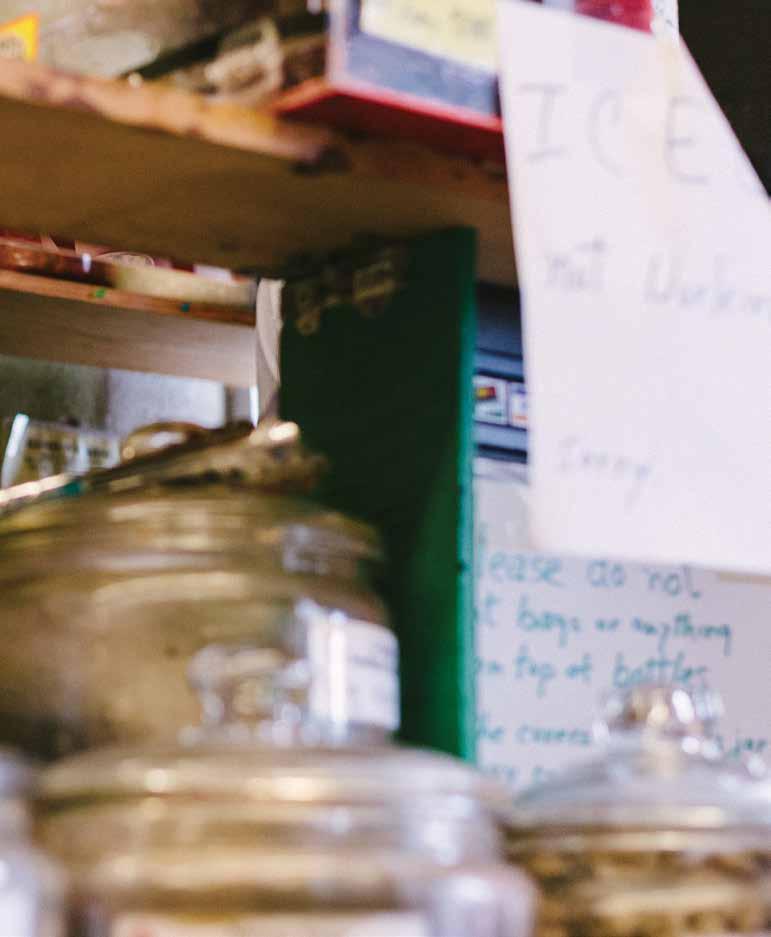
Divinity’s Cup
Two spiritual rituals call on participants to drink in the divine.
TEXT BY RAE SOJOT
IMAGES BY JOHN HOOK & MARK KUSHIMI
During the late 1990s, Japanese researcher Masaru Emoto drew considerable attention when he introduced a concept both compelling and controversial: Water, he said, could absorb and react to human consciousness. In his experiments, he would yell, sing, speak kindly, and use abusive language toward glasses of water, which he would then freeze

to examine the resulting ice crystals. According to Emoto, water that had been treated positively formed exquisite geometric designs akin to snowflakes. Samples that had been exposed to negative and ugly emotions resulted in malformed and misshapen patterns.
While the science community dismisses experiments like Emoto’s as metaphysical quackery, they do illuminate something that science is unable to quantify but spirituality can qualify: intention.
Water and its life-giving properties have long played a fundamental role in religious and spiritual traditions. To drink of a holy water is to affirm and align with the divine. Ancient Mayans, for example, drank a bitter elixir prepared from crushed cacao beans, calling it the “drink of the gods.” Zen Buddhists seek enlightenment through chado , or “the way of tea.”
Here in Hawai‘i, Christian theology and Hawaiian mythology find twin relevance in ritual practices where partakers drink in the divine— namely, practices of serving ‘awa, and the taking of the Eucharist—as means to draw closer to one’s God or gods.
“‘Awa is the drink of the gods,” says Keliʻiokalani Mākua at his home in Mākaha on Oʻahu’s
162 | FLUXHAWAII.COM
LIVING WELL | RELIGION |

Known as kava throughout the Pacific and ‘awa in Hawai‘i, both the drink and the plant have long held pivotal, sacred stature in Polynesian culture. For Keli‘iokalani Mā kua, ‘awa is drunk as a sign of respect for the gods.
163
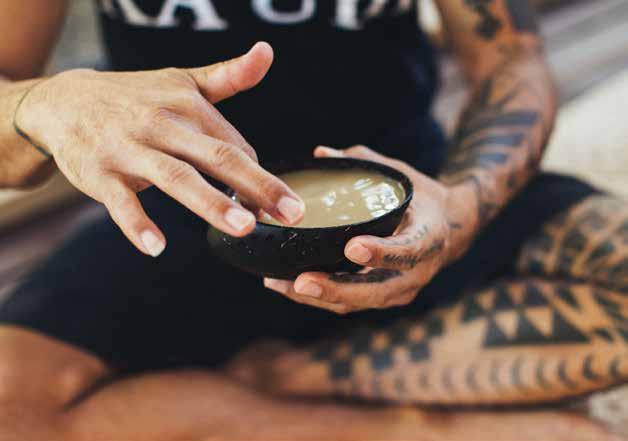
sunny leeward coast. A kahuna kā uhi, or tattoo priest, Mākua is preparing for his day’s work of kākau, the traditional art of Hawaiian tattoo. “Whenever we do sacred work, there’s ritual involved,” Mākua says. “Making ‘awa is part of that ritual, a sign of respect for our gods.” Nearby, a small group of men bring forth the implements used in making the venerated brew: polished coconut shells halved lengthwise into cups, a kamani wood serving bowl, a pitcher of filtered water, a small cloth pouch filled with dried, powdered ʻawa root. Earlier, Mākua had shared a story of two Hawaiian deities, Kāne and Kanaloa, and their love of drinking ‘awa: While traveling together near Ke‘anae on Maui, Kanaola, forever the enticer, wheedled Kāne into taking a break. “I’m thirsty, let’s have ‘awa,” Kanaloa said to his companion. So Kāne drove his ‘ō‘ō, or digging staff, into the ground to release two springs, providing them with freshwater for brewing ʻawa. “That area is called wai kau a Kāne me Kanaloa, ‘The waters of Kāne and Kanaloa,’” Mākua says. On this morning at Ka Pā ʻO Hūnōhūnōholani, the screened-in
enclosure where Mākua does kākau, it is men, not the gods, who endeavor to partake in the sacred drink.
Known as kava throughout the Pacific and as ‘awa in Hawai‘i, both the drink and the plant have long held pivotal, sacred stature in Polynesian culture. Termed a “canoe plant,” ‘awa (Piper methysticum, a member of the pepper family) was brought aboard canoes by Polynesians voyaging to the Hawaiian Islands, along with other staples such as kalo (taro) and banana. Where kalo fed the people, ‘awa nourished the spirit. In olden days, it was made by chewing the ‘awa root, mixing the masticated material with water, and then straining it out. The resulting liquid was drunk for its relaxing properties. ‘Awa was prized for its medicinal, spiritual, and social value in Hawaiian culture, and served as key thanksgiving to the gods during ceremonies ranging from war preparations to canoe blessing to healings. But with the arrival of missionaries in the 1820s and the subsequent rising tide of Christianity, Hawaiian cultural
� “‘Awa is a sacred representation of Kāne and so is kākau,” says Mākua, a Mākaha-based kahuna kā uhi, or tattoo priest.
164 | FLUXHAWAII.COM

� Many of the implements used in ‘awa ceremonies, including the root and drink itself, are sacred representations of the Hawaiian deity K ā ne.
165
traditions were diminished. The drinking of ‘awa in spiritual and social settings dwindled. “So much that what we knew as sacred got tossed due to the influx of foreign influence,” Mākua says. As a Hawaiian and a kahuna, Mākua considers it his kuleana, or responsibility, to retain the traditions of his native culture. The drinking of ‘awa is a form of reverence to the gods, and is immanent in the work of kākau. In Hawaiian culture, kino lau refers to the myriad forms—plants and animals, natural elements, and actions—that a god embodies. “ʻAwa is a sacred representation of Kāne and so is kākau,” Mākua says. “So we will make a mix before we start our work.”
In Mākua’s pā, the men offer a brief pule, or prayer. As a designated mixer pours water into the bowl and kneads the small pouch, the others begin a soft oli, or chant, their low baritones rising and falling in nearly perfect rhythm to Mākua’s lifting, wringing, and twisting of
On the first Sunday of each month, Ka ‘Aha ‘Ā ina A Ka Haku, or, the sacrament of Holy Communion, is offered at Kawaiaha‘o Church.

166 | FLUXHAWAII.COM

167
the ʻawa-filled pouch. In the bowl, the water grows misty, like a cloud filling a sky. Once the mixing is complete, a designated server pours a cup of the thin, milky-brown mixture along the edge of the bowl—a kino lau of Kāne. Another is poured near an ʻawa plant growing in Mākua’s yard in honor of Kāne. Then, the server offers cups to the rest of the group, presenting the ‘awa in a wide, sweeping arc. The recipient receives the cup with equal humility, clasping it between two hands. Dipping his fingers into the sacrosanct libation, he anoints himself with a few drops before drinking the contents in a singular motion. The cup is returned to the server, who begins the process anew, repeating the ritual until everyone is served. Mākua, as a person of high-standing rank, is served last—a sign of great respect. The surplus ‘awa is then covered with a cloth to signify the end of the ceremony. Once that cover is removed, Mākua explains, the remaining ‘awa will be noa, or freed of taboo, and open for general consumption without any formalities.
Though many describe ‘awa as tasting of earth, it also tastes of purpose.

168 | FLUXHAWAII.COM

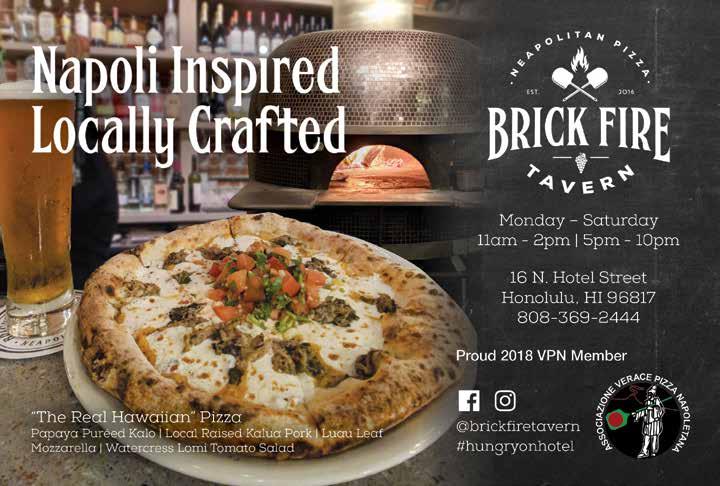

Mākua, who prepares ‘awa often, likens the act to a daily offering—as well as a connection—to his akua, his guardians. “Any practice becomes stronger with ritual,” Mākua says, noting that for him and the many who sit with him, drinking ‘awa is more than a rote nod to their culture: “We drink ‘awa to be closer to our gods and our ancestors,” he says. “Our purpose is to keep our traditions alive.”
Some 30 miles away, a spiritual tradition of a different kind calls out to its followers each Sunday, when the morning bells of Kawaiahaʻo Church ring a warm welcome across downtown Honolulu. Kahu James Merseberg greets parishioners who gather upon the church’s stone steps before entering the hushed sanctuary. Inside, muted sunlight filters through arched windows onto the ōhiʻa wood pulpit, while crimson and gold kāhili stand stately guard along the chancel. Rising above the nave, a single cross—simple, white, and unadorned—hangs as a symbol of Christ’s sacrifice and love for his people.
Established by Christian missionaries who arrived in Hawai‘i in 1820, Kawaiahaʻo Church began as a plain, grass-thatched structure, and was named after a chiefess who frequented a nearby freshwater spring. Later, during the reigns of Kamehameha II and Kamehameha III, Queen Kaʻahumanu, one of the most significant aliʻi to convert to Christianity, commissioned a building of worship in order to better serve an expanding congregation. Constructed of 14,000 slabs of coral rock, “The Great Stone Church” serves as the “mother church” of the 57 Protestant churches of Hawai‘i. For nearly 200 years, church services have been held in both Hawaiian and English.
The lilting tones of the Hawaiian language are especially evident during the first Sunday of each month, when Ka ‘Aha ‘Āina A Ka Haku, or, the sacrament of Holy Communion, is offered. On these mornings, the deacons, solemn and white-robed, arrive early to prepare the ceremonial elements. The preparation is a sacred affair, and those involved will ready themselves through private prayer and
� “When we participate in Holy Communion, our symbolic gesture of eating the bread and drinking of the cup is our remembrance and our acceptance of God’s true message: He loves us and through Him we are given eternal life,” says William Hi‘iakaikapoliopele Kaina.
170 | FLUXHAWAII.COM

171
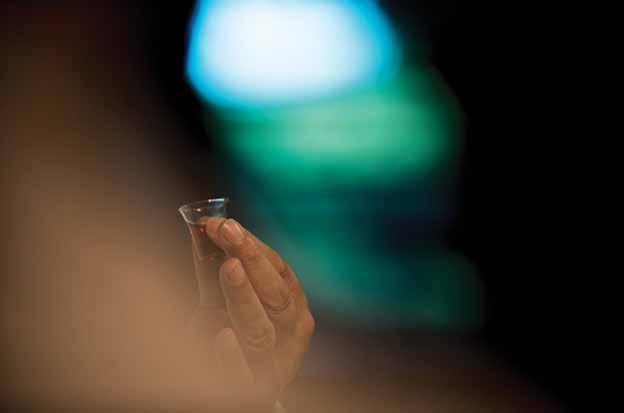
hoʻoponopono, a reconciliation process of making things right with oneself and others, with the environment and ke Akua, or God. Once complete, the deacons place thimble-sized cups of grape juice on silver trays and cut rounds of sweet-scented bread into small, even cubes. The kahu consecrates the items, which are covered with a white linen cloth until the church service begins.
The Christian faith has a number of sacraments, or rites of worship, that were instituted by Jesus Christ, explains William Hi‘iakaikapoliopele Kaina, who grew up on Hawaiʻi Island and served as Kawaiahaʻo’s kahu from 1984 to 1997. The United Church of Christ, of which Kawaiahaʻo is a member, recognizes two of the sacraments: Baptism and Holy Communion, also called the Lord’s Supper or Eucharist.
The elements partaken during Holy Communion recall the same elements Christ brought before his disciples the night before his crucifixion. “When Jesus came to Earth, he gave of himself to the people so that he might save them,” says Kaina, now 85. Though retired, he and his wife, Sandra, regularly attend Sunday
services. “At the Last Supper, Jesus took the bread and said, ‘This bread is my body,’ and he ate that, showing us to eat it too, to take it in within us. And then he took the cup that held the wine and said, ‘This is my blood that will be shed for you, to save you,’ and then he drank that and showed us to drink it too,” Kaina says. “When we participate in Holy Communion, our symbolic gesture of eating the bread and drinking of the cup is our remembrance and our acceptance of God’s true message: He loves us and through Him we are given eternal life.”
During a recent first Sunday service, Merseberg signals to the deacons that it is time for the Ka ʻAha ʻĀina A Ka Haku. The white linen cloth is removed from the Holy Communion table, revealing the simple yet sacred oblations. As the congregation moves forward to receive the Eucharist, the choir gathers, their voices lifting together in rapturous song. The kahu then leads everyone in the partaking of the sacrament. To many, the feeling in that brief, blissful spell is God’s presence, and that moment, a glimpse into eternal life.
� The body and blood of Jesus Christ is represented through bread and juice served during Holy Communion.
172 | FLUXHAWAII.COM
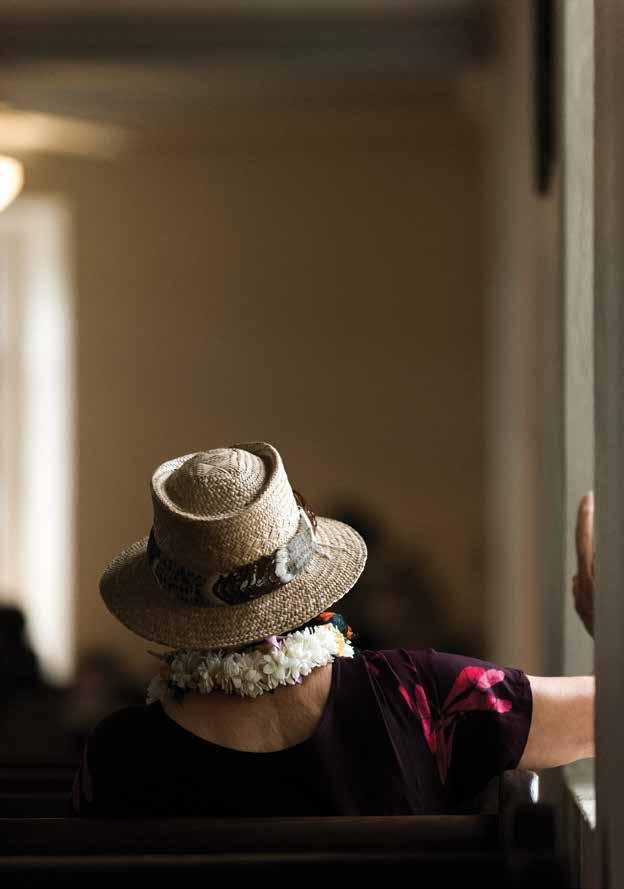
173
This Tastes Like Home
Three keepers of the flame and where to still find them, for now.
TEXT BY BEAU FLEMISTER
IMAGES BY AJ FEDUCIA
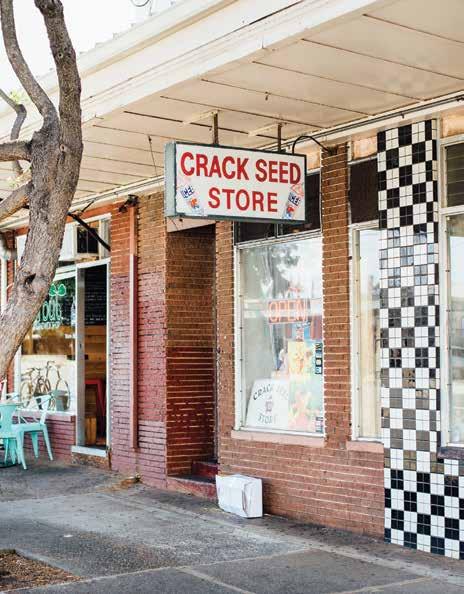
Maybe you have to leave to truly long for the taste. Maybe, like the literal li hing mui (“traveling plum” in Cantonese), you must experience your own personal odyssey to appreciate the foods of your youth. Because if anything evokes the complex flavors of a childhood in Hawai‘i, it’s the delicacies sold at the neighborhood crack seed shops, the pork hash behind the foggy plexiglass in the manapua man’s van, the aromas wafting from the bento and okazuya takeout windows.
Maybe no other such flavors capture the essence of growing up here like those of see mui or manapua, from the sweet (your first kiss), to the salty (a day at the beach park), to the sour (the lump in your throat as the aircraft pierces through the clouds and you watch your home
� If anything evokes the flavors of a childhood in Hawai‘i, it is the delicacies sold at neighborhood crack seed shops.
174 | FLUXHAWAII.COM
EXPLORE | EATS |

175
� K.P. Young still mans his Kaimuk ī crack seed shop alone, as he has for 37 years.

slowly fade away). Maybe the entire human experience is found within a preserved plum. Maybe li hing mui powder is pixie dust to find your way home. Second star to the right, straight on till Diamond Head…
CRACK SEED
The interior of the very literally named Crack Seed Store on Koko Head Avenue near Waiʻalae Avenue resembles a fabled medieval apothecary more than a modern small business. Multiple tiers of large glass jars showcasing the goods crowd the small shop, sharing space with an Icee machine, a beef jerky case, shelves of Tomoe Ame rice candies, boxes of Yan Yan dip sticks, and two scales—one analog, the other digital. But instead of potions like witch hazel or laudanum, within the jars sit see mui, lemon peel, and other precious preserves labeled “Soft and Sweet,” “Red Seedless,” “White Seedless,” “Dry Rock Salt,” “Sweet and Sour Cherry,” “Wet Mui,” “King Mui,” “Baby Mui,” “Honey Ume.”
The ever-jovial K.P. Young still mans his shop alone, as he has for 37 years. He bought the business in 1979 from a woman who opened her own crack seed operation there in the late 1950s. A wide range of local people from varying generations funnel in and out, with little break for Young. I watch as a customer asks for a quarter pound of rock salt plum, and Young shovels the seeds with one deft scoop, weighing the amount right on the money, like a magician.
Has he done much modernizing since 1979? Sure. Young has gone from twist ties to a sealing machine for the plastic baggies. And while it might look like he makes his own product, he tells me that he has been importing all the crack seed from Hong Kong, Taiwan, and now Thailand. The company that seasons the see mui has a family secret formula, he says, passed on through the ages.
I ask him if his own children will likely take over his business when he’s too old, and he smiles and shakes his head. “My kids all have their own jobs,” he says.
� Much remains unchanged at the Crack Seed Store since it opened in 1979, although its owner has introduced two modern elements: twist ties and a sealing machine for plastic baggies.
176 | FLUXHAWAII.COM

177
� Customers line up at the Crack Seed Store to snag bags of red seedless li hing mui, sweet and sour cherry, and pickled mango.
“Crack seed is a hard business. It’s not easy. First of all, it is a foreign product with a lot of regulations, and has to go through customs. Sometimes, when a shipment doesn’t come in, you even have to check on the foreign side. It’s kind of sad, because there’s definitely less crack seed stores these days, since the children aren’t taking over.”
Regardless of the decline of crack seed brick and mortars, I realize why Young’s smile won’t leave. Because on a gloomy Tuesday at 11 a.m., there’s still a line snaking out the door.
OKATA BENTO
Just around the corner from Crack Seed Store, on Waiʻalae Avenue, is Okata Bento, a comfortfood cornerstone with only a takeout window that has been in Kaimukī since 1981. I walk up to the literal hole in the wall and order a teriyaki beef and char siu chicken bento, while wondering if the prices are typos because it’s so affordable. It’s not a mistake. Score. As I wait, trade workers in long-sleeve neon yellow shirts, bank tellers, and businesspeople swing by and grab their boxes with ease. Clearly I have not called in my order. Rookie mistake.

178 | FLUXHAWAII.COM

Serving plate lunches, donburi bowls, and sandwiches since 1981, Okata Bento remains a comfort-food cornerstone.
179
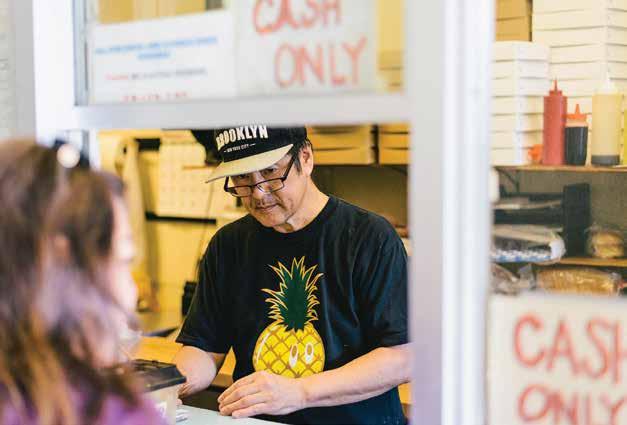
Lyndon Okata, Okata Bento’s owner and chef, has been running the show since he started the business as a food truck. He has counter help and an assistant, but Okata still does the work of three men behind the glass, making every bento, plate lunch, donburi, and sandwich upon order—hence the benefit of calling in.
I ask Okata what the most popular bento is, and he laughs. “It’s so funny, because everybody has their favorite, so there’s not really one in particular,” he says. “Whenever a customer comes, I already know what they want. They basically order the exact same thing every single time. They rarely ever change their order. Even my kids growing up who would help me, we’d have this thing like, ‘Oh, the chicken katsu guy or chicken teri guy.’ You could automatically equate the order with the name.”
I ask Okata if he plans to pass the business on to his two children, but he doesn’t see that happening. They helped him growing up—at the counter, washing dishes, cleaning, prepping—but both now live in New York City. One is a fashion stylist and consultant, the other, a graphic designer.
While he’s got some items that other bento shops don’t always carry, like tonkatsu and a special char siu sauce that is the secret recipe of a friend, Okata believes the reason for the joint’s ongoing popularity is consistency.
“It’s only me cooking, me preparing—it tastes the same every time,” Okata says. “Some places you go and they’ll have different cooks or maybe different staff, so taste can change. But not here, I feel.”
At this moment, a hurried businessman in an aloha shirt swings by for his order. I’m new at this, but I have a strange inkling it’s the chicken katsu guy.
MANAPUA TRUCK
If you are not from a neighborhood with a manapua man, it can be difficult to locate one. Manapua men and manapua women don’t do websites. They don’t take card. They don’t strive for sparkling Yelp reviews. To find one of their aging vehicles— normally a white converted van—you must rely on word of mouth. That, or trending hashtags with GPS coordinates.
� Lyndon Okata, Okata Bento’s owner and chef, still does the work of three men, making every item to order.
180 | FLUXHAWAII.COM

� Though both his children helped out in the kitchen at Okata Bento, Okata doesn’t have plans to pass on the business to his children, who have successful careers in New York City.
181
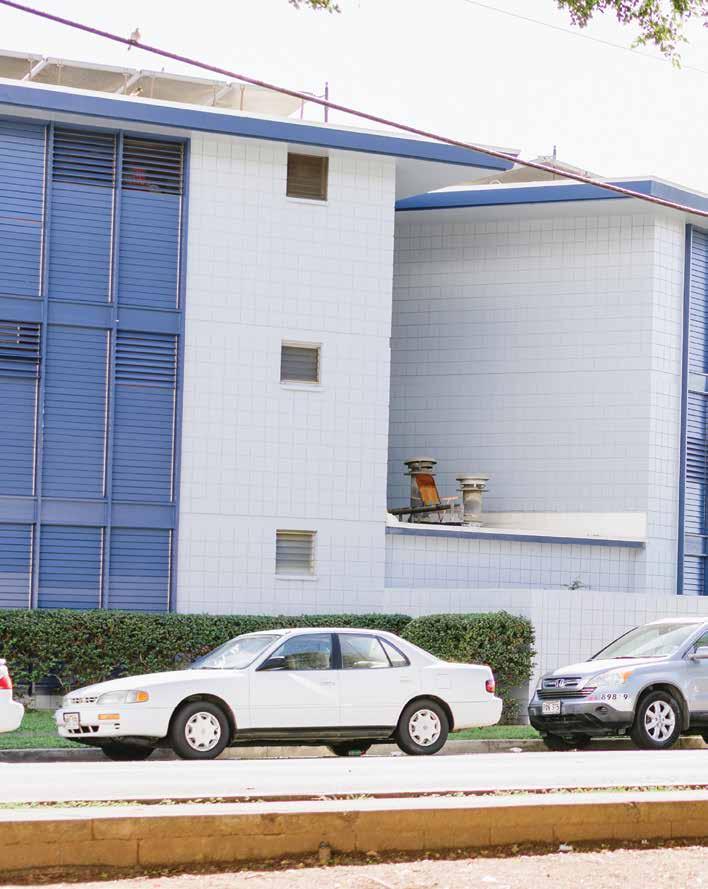
182 | FLUXHAWAII.COM

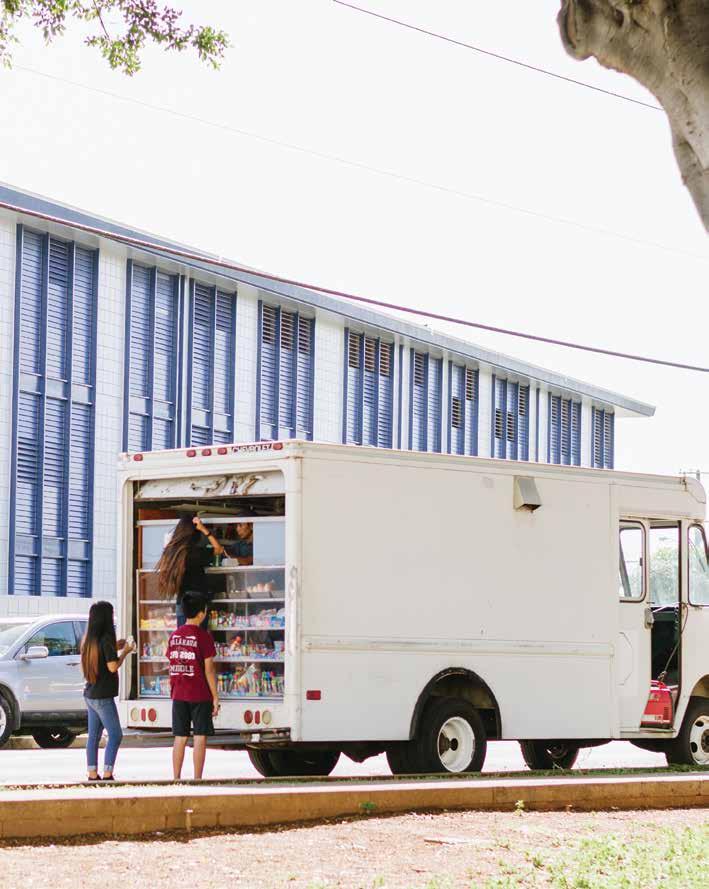
183
Making use of my full bars on the coconut wireless, I hear of a van that parks across from the Kalakaua Boxing Gym at District Park on McNeill Street in Kalihi Kai. I go there, find a spot on the bend in the road by the basketball courts, and while I fiddle with my windshield sun shade, I notice two separate drug deals go down in a span of 30 seconds. I approach a van with middle schoolers and park goers huddled around its side window, and get a couple curious looks like, “You ain’t from around these parts are ya, boy?”
Manapua is a savory local version of the Chinese pastry char siu bao. But I’ve always wanted to get to the bottom of the food’s Hawaiian etymology: Is it from mea ʻono puaʻa, meaning, “delicious pork,” or mauna puaʻa, meaning “mountain of pork?” There is a fierce debate over this, but I keep my nerdy questions to myself, and study the menu. Manapua, rice cake, pork hash, fried pork hash, fried noodles,
� Flavors, like those of steaming manapua, can transport us to days when we were younger and remind us of home.
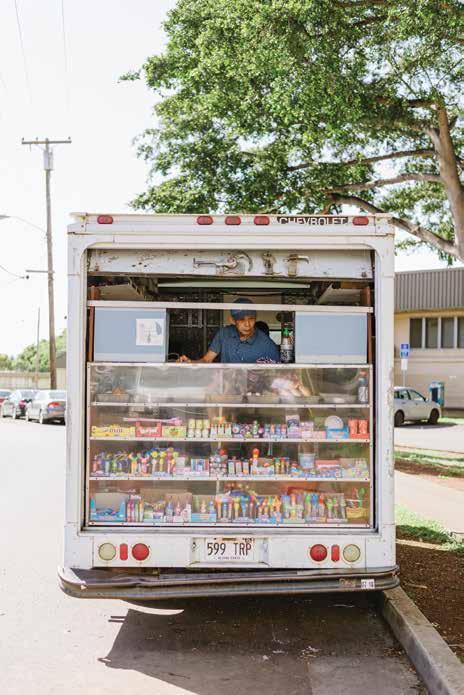

184 | FLUXHAWAII.COM

SPAM musubi, and other local hits, most for under $2. Also available, a collection of soft drinks, Hawaiian Suns, and enough candy to trigger type 2 diabetes. I’m going with a “mountain of pork” because it’s leg day, plus a musubi because I’m starving. I squirt some shoyu from the Sriracha bottle I snagged from the counter over the musubi rice because I love myself.
Fathers with toddlers on their shoulders cross the street from their apartments and get in line. A tūtū and her grandson make their way from the elementary school. A kid pushes over from the courts on a skateboard. I realize that my carbon footprint was a few sizes larger than everyone’s here. If you gotta drive to a manapua man, you’re not from the neighborhood.
There are flavors that bring us back to places that still exist—though there may not be any successors. They transport us back to hanabada dayz. Their aromas emanate from holes in walls and counters in vans that were established well before the food truck craze. These flavors transcend health codes and seating and advertisement. They are safe havens and crafts, and spaces that smell and sound and taste, like home.

186 | FLUXHAWAII.COM



Harbor Restaurant at Pier 38
Sitting atop the Pier 38 Fishing Village overlooking Honolulu Harbor is Harbor Restaurant at Pier 38. Just over a year old, the latest addition to the fishing village is adding to the local mystique of the complex located just off Nimitz Highway, which is also home to United Fishing Agency’s Honolulu Fish Auction the only fresh tuna auction in the United States.
“It ’s a dream job,” says executive chef Rob McDaniel. “Having nextdoor access to the freshest fish in town, looking at these harbor views every day, and working in a state-ofthe-art kitchen, it ’s awesome.”
Harbor’s kitchen features Hawai‘i’s only brasa commercial oven, an enclosed grill that burns kiawe charcoal, “for its distinctive flavor and clean burning properties,” adds McDaniel. The brasa, meaning “hot coal” in Spanish, imparts unique texture very quickly while locking in flavor and without drying out the food.
Separate lunch and dinner menus feature favorites like the grilled Spanish octopus served on arugula,
the Cuban panini made with slowroasted citrus pork and house-made cornichon pickle tapenade, the misoyaki Chilean sea bass, and the 20 oz. prime rib served daily.
The restaurant offers lunch and dinner with “huki pau” happy hour from 2 p.m. to 6 p.m. Live music happens Wednesday through Sunday and a private dining program is available.
� Harbor Restaurant at Pier 38 is located at 1129 N. Nimitz Hwy. For more information, call 808-550-3740 or visit harborpier38.com.
IN FLUX | PROMOTIONAL | 188 | FLUXHAWAII.COM
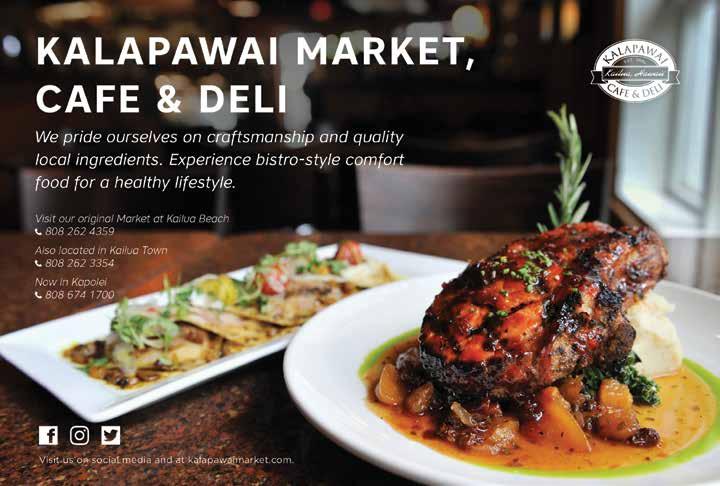


Where brasa is boss. Lunch 11-3. Huki Pau 2-6. Dinner 5-9. 1129 N. Nimitz Hwy, Pier 38, Honolulu FREE PARKING | HARBOR VIEWS 808.550.3740 harborpier38.com Kiawe-burning brasa grill-ovens deliver distinctive textures and flavors for your dining pleasure.
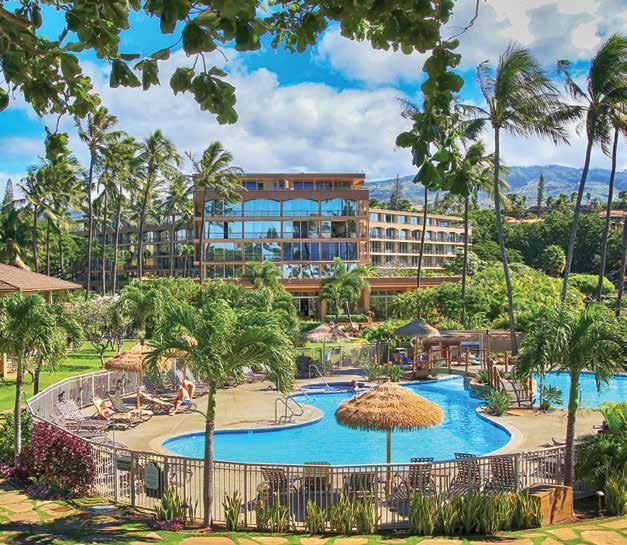
Island Living, Your Way
For an unforgettable getaway to Hawai‘i, head to Maui Kaanapali Villas on the island of Maui. This magnificent beachfront resort rests on 11 acres of serene tropical gardens and Kā‘anapali’s immaculate white sand beach. The resort offers hotel, studio, and one-bedroom suites. Upgrade to a premium suite that offers the finest in luxury for a more indulgent experience.
Whether you’re seeking active water sports or some time just lounging on the beach, the picturesque Kā‘anapali Beach is just steps away. If relaxing poolside is more your style, take a swim in the oversized pool or reenergize yourself in the jet spa. With the resort centrally located in Kā‘anapali, guests can head out and shop and dine at nearby Whaler’s Village, take a hike on one of the Kapalua trails for a panoramic view, or go on a snorkeling adventure at Black Rock. Then head back for dinner or a night cap at onsite restaurant Castaway Café.
� Discover your best vacation yet and book direct at astonmauikaanapalivillas.com or call Hawai‘i-based specialists at 866-774-2924 to elevate your island experience with a free daily car rental when booking the Free Daily Car Rental Package. What better way to experience island life than in the driver’s seat, exploring at your own pace.
IN FLUX | PROMOTIONAL | 190 | FLUXHAWAII.COM
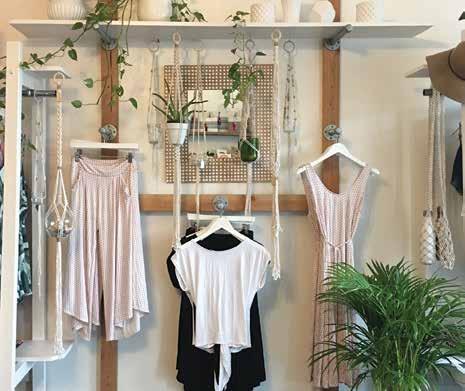
Betty x Joe Boutique
A delightful, island lifestyle boutique featuring hip local artisans and a lovely selection of clothing, accessories, gifts, and plants.
� For more information, find Betty x Joe on Instagram @bettyxjoe. Located at 41 Kihapai St. in Kailua, Hawai‘i.

Glow with the Flow
Let’s raise a toast to those afflicted with the dreaded Asian flush.
TEXT BY MATTHEW DEKNEEF
ILLUSTRATION
BY MITCHELL FONG
As a male of drinking age, and of part-Asian descent, let me share with you a unique cultural problem I face, quite literally, with my face. I’m talking about an anxiety-inducing experience known as “Asian glow,” the erroneously cute term for alcohol flush reaction— a condition concerning the intense blushing and bright rosy hue that fans across one’s face, neck, ears, and body upon the consumption of alcohol. It is common among people of Asian ancestry, a large percentage of whom lack aldehyde dehydrogenase 2, some cellular enzyme that breaks down acetaldehyde, a byproduct of alcohol, causing it to accumulate at 10 times the normal concentration due to the presence of an allele called ALDH2*2 by which— okay, look, I get it: Asians are supposed to be good at, like, bio-engineering and science, but I can’t even pretend to understand what I just copy-pasted from Wikipedia, so why don’t you just Google the rest while I go ahead and live it. Ugh! For us, the worrying starts before the drinking even begins. For most people, a night out means weighing whether or not you want to get freaky, while we weigh looking like a total freak. We worry about getting dressed and choosing clothes that’ll complement our potential face color, which could run anywhere from a portly pink to a deep purple. Drinking can feel like a part-time job because of all the prep work required before downing
one beer, and the mental fortification required for all the potential jokes ahead. (“Are you okay? Do you want some SPF 90? You’re, like, really red right now. Ack, now you’re turning purple! Did you choke on the poke? I made it!”) Everyone means well, but they’re having a killer buzz, and we’re just red with jealousy.
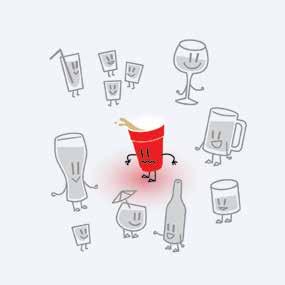
Asian glow is a paradox. It’s at total odds with why people drink in the first place: To rid ourselves of inhibitions only makes us more inhibited. Still, we love knowing our limit better than our friends will ever know theirs. We appreciate that turning red saves us a ton of green. We have to be even more confident in our skin, a life lesson in loving yourself. We use a diverting self-awareness and make light of being a lightweight. And we dream— the ultimate coping mechanism to loving the glow.
The next time we’re blinded by the luminescent reflection of ourselves in the glare of our half-full glasses and begin wondering where we fit in the fabric of this party, we convince ourselves we’re part of an enlightened truth radiating beneath the tide of our crimson surface—that in the post-post-racial year of 2187, everyone will inevitably have some of this hyperactive blood pumping through their veins, and we’re merely bright beacons of that future lying ahead. Basically, we tell ourselves anything so that we can glow with the flow.
IN FLUX | A HUI HOU | 192 | FLUXHAWAII.COM







































 �
Patterson.
�
Patterson.






















 FLUX FEATURE
FLUX FEATURE















 FLUX FEATURE
FLUX FEATURE



 � Lyle Botelho, left, and Daniel Stephens, right, pick cabbage at the Waiawa Correctional Facility in Waipahu.
� Lyle Botelho, left, and Daniel Stephens, right, pick cabbage at the Waiawa Correctional Facility in Waipahu.




 Waiawa Correctional Facility’s nearly 200 acres include prison facilities, an 8-acre farm, an aquaponics farm, a fruit orchard, a koa forest, and a Christmas tree farm.
Waiawa Correctional Facility’s nearly 200 acres include prison facilities, an 8-acre farm, an aquaponics farm, a fruit orchard, a koa forest, and a Christmas tree farm.

















 � The gardens at Ho‘oulu ‘Ā ina, Kalihi. Image by Meagan Suzuki.
� The gardens at Ho‘oulu ‘Ā ina, Kalihi. Image by Meagan Suzuki.









 Illustration by Lauren Trangmar.
Mark “ Gooch ” Noguchi Chef and co-founder of Pili Group
Illustration by Lauren Trangmar.
Mark “ Gooch ” Noguchi Chef and co-founder of Pili Group
 Illustration by Lauren Trangmar.
Kevin Yim Zippy ’s Restaurants vice-president of marketing
Illustration by Lauren Trangmar.
Kevin Yim Zippy ’s Restaurants vice-president of marketing
 Illustration by Lauren Trangmar.
Illustration by Lauren Trangmar.
 Illustration by Lauren Trangmar.
Guy Hagi
Illustration by Lauren Trangmar.
Guy Hagi
 Illustration by Lauren Trangmar.
Illustration by Lauren Trangmar.
 Illustration by Lauren Trangmar.
Illustration by Lauren Trangmar.

 Images by Meagan Suzuki. Yauatcha at International Market Place.
Images by Meagan Suzuki. Yauatcha at International Market Place.







 Image by Aja Toscano.
Image by Aja Toscano.

 Images courtesy of William Sonoma. Mahina’s Family Feast.
Images courtesy of William Sonoma. Mahina’s Family Feast.

 Image courtesy of Mykle Coyne for Feast Hawaii.
Image courtesy of Mykle Coyne for Feast Hawaii.
 Image by Michael Ni.
Image by Michael Ni.
 Image by Amanda Robson for Feast Hawaii.
Image by Amanda Robson for Feast Hawaii.
 � The La Fonda dining chair by Charles and Ray Eames. Image by John Hook.
� The La Fonda dining chair by Charles and Ray Eames. Image by John Hook.



















 � K.P. Young, owner of the Kaimuk ī institution
Crack Seed Store. Image by AJ Feducia.
� K.P. Young, owner of the Kaimuk ī institution
Crack Seed Store. Image by AJ Feducia.





































